CALIFORNIA NATIVE PLANT SOCIETY
Channel Islands Chapter
Channel Islands Chapter
|
|
||||||||||||||||||||||||||||||||||||||||||||||||||||||||||||||||||||||||||||||||||||||||||||||||||||||||||||||||||||||||||||||||||||||||||||||||||||||||||||||||||||||||||||||||||||||||||||||||||||||||||||||||||||||||||||||||||||||||||||||||||||||||||||||||||||||||||||||||||||||||||||||||||||||||||||||||||||||||||||||||||||||||||||||||||||||||||||||||||||||||||||||||||||||||||||||||||||||||||||||||||||||||||||||||||||||||||||||||||||||||||||||||||||||||||||||||||||||||||||||||||||||||||||||||||||||||||||||||||||||||||||||||||||||||||||||||||||||||||||||||||||||||||||||||||||||||||||||||||||||||||||||||||||||||||||||||||||||||||||||||||||||||||||||||||||||||||||||||||||||||||||||||||||||||||||||||||||||||||||||||||||||||||||||||||||||||||||||||||||||||||||||||||||||||||||||||||||||||||||||||||||||||||||||||
|
||||||||||||||||||||||||||||||||||||||||||||||||||||||||||||||||||||||||||||||||||||||||||||||||||||||||||||||||||||||||||||||||||||||||||||||||||||||||||||||||||||||||||||||||||||||||||||||||||||||||||||||||||||||||||||||||||||||||||||||||||||||||||||||||||||||||||||||||||||||||||||||||||||||||||||||||||||||||||||||||||||||||||||||||||||||||||||||||||||||||||||||||||||||||||||||||||||||||||||||||||||||||||||||||||||||||||||||||||||||||||||||||||||||||||||||||||||||||||||||||||||||||||||||||||||||||||||||||||||||||||||||||||||||||||||||||||||||||||||||||||||||||||||||||||||||||||||||||||||||||||||||||||||||||||||||||||||||||||||||||||||||||||||||||||||||||||||||||||||||||||||||||||||||||||||||||||||||||||||||||||||||||||||||||||||||||||||||||||||||||||||||||||||||||||||||||||||||||||||||||||||||||||||||||
|
Sunday 30 June 2019 9:00AM-01:30pm |
Walk Ventura County |
Botany Hike at Pine Mountain
Leader: Rick Burgess At elevations of 5000 to 7000 feet, Pine Mountain Ridge features the highest diversity of conifers in Ventura County and is one of the few “sky islands” in our region that has mostly escaped significant fires over the past several centuries. Botanist Rick Burgess will show us some of the interesting plants that grow here. In addition to the nine species of conifers that are found here, we will look for the newly described Southwestern Monardella (Monardella australis ssp. occidentalis). We hope to see Pine Fritillary (Fritillaria pinetorum), Staining Collomia (Colomia tinctoria), Davidson’s Phacelia (Phacelia davidsonii), Mountain Wooly Star (Eriastrum densifolium ssp. austromontanum), and Sierra Snow Plant (Sarcodes sanguinea). Mr. Burgess is creating a comprehensive flora of Ventura County. Bring a hand lens, water, lunch, and wear lug-soled boots/shoes and a hat. We will meet at the Los Padres Visitor Center at Wheeler Gorge at 9:00 a.m. along Highway 33 and carpool from there. Carpooling is recommended because parking is limited. Anything more than light rain cancels the hike. Directions: Yake the 101 Freeway to the Hwy. 33 exit. Go north on Hwy 33, following the highway’s turn to the left at the Von’s Market in Ojai. Continue north on Hwy. 33 to the Los Padres Visitor Center at Wheeler Gorge on the right side of Hwy. 33 and park outside of (north of) the Visitor Center Parking lot. After carpooling, continue on Highway 33 to Pine Mountain Summit (where there is a road to Pine Mountain on the right) and pull off on the wide dirt shoulder next to the highway.
Tuesday |
16 July 2019 7:00 PM to 9:00 PM
Talk |
Santa Barbara County
Banking on the Future: Saving Southern California’s Native Seed
|
Speaker: Genevieve Arnold, Seed Program Manager, Theodore Payne Foundation for Wild Flowers & Native Plants How can seed banking benefit southern California residents? What is the role of seed banking in native plant conservation, and how will it grow into the future? An introduction to current regional seed banking efforts will be followed by tips for the home gardener in effectively collecting, cleaning and storing seeds of native plants. Seed processing tools will be shared, and TPF’s “Traveling Seed Museum”, which includes a variety of fruit and seed samples, will be on hand for examination and interaction! Genevieve was trained in conservation seed banking at the Rancho Santa Ana Botanic Garden in Claremont, where she served as Seed Program Technician and Research Plant Collections Technician. She has spent the past several years as Theodore Payne Foundation’s Seed Program Manager, where she has implemented the Long Live L.A. Parks Collaborative Conservation Seed Bank and serves as a core member of the regional Seed LA collaborative. She enjoys the unique and artful beauty of native plants in the wild and in the garden, in all their phases – including the intricate and fascinating stages of fruit and seed development. Venue: Santa Barbara Botanic Garden, 1212 Mission Canyon Road, Santa Barbara, California. Parking is free. Doors will open at 7pm. Announcements will be at 7:15 and the talk will follow.
|
|
|
|
|
1st Saturday |
Monthly 10:00 AM - 12:00 PM
Restoration Day, Carpinteria |
Habitat Restoration at Carpinteria Salt Marsh, Carpinteria, Santa Barbara County.
|
Leader: Andrea Adams-Morden, Naturalist/Weed Specialist Andrea leads a late morning, just 2 hours, effort of eradicating invasive exotics on the beautiful and interesting Carpinteria Salt Marsh. The weather should be nice. When is ever not nice in Carpinteria? Join CNPS members and other community enthusiests in improving habitat conditions of the Carpinteria Salt Marsh. Contact Andrea at 805/684-8077 for meeting place. Directions: Meet at the Carpinteria Salt Marsh Nature Park Telescope entrance on Ash Avenue half way between Third Street and Sandyland, in the City of Carpinteria. View Larger Map Contact Andrea Adams-Morden [aadamsmorden@yahoo.com or 684-8077] for more information. Bring water and sun protection, and gloves are a good idea too.
|
Second |
Tuesday or Thursday 7:00 PM
Chapter Board Meetings |
Santa Barbara, Carpinteria, Ojai, or Ventura
Chapter board meetings are usually held monthly, customarily on the second Tuesday or Thursday of every other month. They are held at a private residence in Ojai or at an office in mid-town Ventura, or at the Santa Barbara Botanic Garden immediately preceding the bimonthly evening program. If you want to get further involved in your local CNPS chapter, come to a meeting - there are always plenty of volunteer opportunities. Call 805/646-6045 for more information.
|
|
|
Saturday and/or Sunday |
8:00 or 9:00 AM
Weekend Hike |
and/or Activity
Saturday/Sunday activities are offered once or twice per month. They rotate between botanizing walks and work parties to eradicate non-native invasives. Call 805/646-6045 or email the chapter president at president(at)cnpsci(dot)org to volunteer to lead a hike or activity, or check back here to see what is scheduled.
|
|
Semi-annually |
Spring & Fall 9:00 AM to 2:00 PM
Plant Sale
|
The Chapter holds two plant sales each year: one in spring and one in fall. Contact your chapter president, Andrea Adams-Morden, at aadamsmorden@yahoo.com to volunteer, or just to attend and purchase native plants for your garden. The Fall Native Plant Sale will be held on Saturday, 11 November 2017, at the Ventura Botanical Garden There with a nice selection of local native plants to choose from. The sale goes from 9am to 3pm.
|
|
Annually
|
Annual Dinner
|
The Chapter tries to hold a dinner for all members each year, usually in late summer or early fall. It is an opportunity to review the successes of the past year and to socialize with other members. Social hour includes wine tasting, silent auction, appetizers, and other activities. Contact Heidi Schneider, chapter secretary at secretary@cnpsci.org for more information. Click here to see photos from past annual dinners.
|
|
|
| ||||||||||||||||||||||||||||||||||||||||||||||||||||||||||||||||||||||||||||||||||||||||||||||||||||||||||||||||||||||||||||||||||||||||||||||||||||||||||||||||||||||||||||||||||||||||||||||||||||||||||||||||||||||||||||||||||||||||||||||||||||||||||||||||||||||||||||||||||||||||||||||||||||||||||||||||||||||||||||||||||||||||||||||||||||||||||||||||||||||||||||||||||||||||||||||||||||||||||||||||||||||||||||||||||||||||||||||||||||||||||||||||||||||||||||||||||||||||||||||||||||||||||||||||||||||||||||||||||||||||||||||||||||||||||||||||||||||||||||||||||||||||||||||||||||||||||||||||||||||||||||||||||||||||||||||||||||||||||||||||||||||||||||||||||||||||||||||||||||||||||||||||||||||||||||||||||||||||||||||||||||||||||||||||||||||||||||||||||||||||||||||||||||||||||||||||
|
Sunday 12 May 2019 9:00AM to 12:30PM |
Walk Los Angeles |
Upper Zuma Canyon, Santa Monica Mountains Botany Hike
Leader: Jay Sullivan Native plant aficionado and wildflower photographer Jay Sullivan will guide us along a segment of the Santa Monica Mountains Backbone Trail in Upper Zuma Canyon. This area is a fine example of post-Woolsey Fire recovery, with native wildflowers everywhere. Among the uncommon fire-followers to be seen are Calandrinia breweri (Brewer’s Redmaids), Antirrhinum kelloggii (Kellogg’s Snapdragon), Toxicoscordion fremontii (Fremont’s Deathcamas), Scutellaria tuberosa (Danny’s Skullcap), and Lomatium lucidum (Shiny Biscuitroot) –with the possibility of Papaver californicum (Fire Poppy), Phacelia grandiflora (Largeflower Phacelia), and Ehrendorferia ochroleuca (White Eardrops). Bring a hand lens, water, and snacks, and wear hiking boots and a hat. We will meet at 9:00 a.m. on Encinal Canyon Rd. about 1.6 miles from Kanan Rd. on a dirt pullout just past the Buzzard’s Roost Ranch sign. Please RSVP by calling (805) 794-5334. Directions: Take the 101 Freeway to Kanan Rd. in Agoura Hills. Exit and go south (toward the ocean) 6.1 miles to Mulholland Hwy. Turn right on Mulholland Hwy. and go 1.0 miles to Encinal Canyon Rd. Take the left fork (Encinal Canyon Rd.). After 0.6 mile there is a wooden sign on the right side of the road for Buzzard’s Roost Ranch. Drive another 50 feet or so past the sign around a curve to a dirt pullout on the left and park. We will meet there.
Sunday |
19 May 2019 9:00AM to 12:00PM
Walk |
Santa Barbara County
San Jose Creek and Tucker’s Grove restoration tour
| Leader: Daniel Wilson, MESM Habitat restoration specialist Daniel Wilson will show us native plant mitigation projects at two sites in Goleta that are at different stages of growth. We will meet at 9:00 a.m. at Location 1: San Jose Creek at N. Kellogg Ave. and Capellina Way, in front of tennis courts at bike path entrance. This project offsets the impacts of the installation of a bike path over the Creek. Fifty oaks, 90 other trees, and 400 shrubs, forbs, and grasses were planted. Later, we will go to the vicinity of Tucker’s Grove County Park (Location 2), meeting at Cathedral Oaks Rd. and Vala Dr. initially, up top on Vala, just near Cathedral Oaks. Then we will drive a half block into the Park and meet near the kids’ play structure near the entrance. These Park area sites were planted as mitigation for a bridge replacement, and consist of 20 oak trees above the creek, 400 coastal sage scrub and riparian species on the benches adjacent to the channel, and riparian scrub within the channel. Bring water, sun protection, and wear hiking boots and a hat. Please RSVP by calling (805) 794-5334. Directions: Take the 101 freeway to the Patterson Ave. exit and turn toward the mountains (going north). Turn left on Cathedral Oaks Rd., then left on N. Kellogg Ave. Continue 4 blocks to the intersection with Capellina Way and find a place to park.
Sunday |
7 April 2019 9:30AM to 2:30PM
Walk |
Santa Barbara and Ventura Counties
Ballinger Canyon Botany Hike
| Leader: Ivana Noell and Pam De Vries Ivana Noell, Resource Officer for the Mt. Pinos Ranger District of the Los Padres National Forest, and regional botanist Pam De Vries will show us some of the rare wildflowers of the Ballinger Canyon area in the Los Padres National Forest. We may find the endangered Kern Mallow (Eremalche parryi ssp. kernensis), Pale-yellow Layia (Layia heterotricha), and Mount Pinos Onion (Allium howellii var. clokeyi). This area is dominated by Great Basin Sagebrush (Artemisia tridentata), Rubber Rabbitbrush (Ericameria nauseosa), and California Juniper (Juniperus californica). Bring a hand lens, water, and lunch, and wear hiking boots and a hat. We will meet at 9:30 a.m. at the Ballinger Canyon Campground. Ivana will show us where to park. The dirt roads to the featured plants are very rough, so bring your 4-wheel-drive high clearance vehicle if you have one and we will carpool from the Campground in them. Please RSVP by calling (805) 794-5334; limited to 16 people. Directions: Take the 101 Freeway to the Hwy. 33 exit. Go north on Hwy 33, following the highway’s turn to the left at the Von’s Market in Ojai. Continue north on Hwy. 33 over Pine Mountain Summit, past Lockwood Valley Road, and through the town of Ventucopa, to Ballinger Canyon Road (FS 9N10) and turn right. Go about 3.5 miles to the campground. The road from Hwy. 33 to the campground is mostly paved but has a lot of potholes, so drive slowly. Park at the campground where Ivana indicates. An alternate route is to take Hwy. 126 to Interstate 5, go north on 5 to Hwy. 166, exit and go west to the intersection with Hwy. 33, then south (left) on Hwy. 33 to Ballinger Canyon Road and turn left. Proceed about 3.5 miles to the OHV campground and park where Ivana indicates.
Saturday |
13 April 2018 10:00 AM to 3:00 PM
Plant Sale |
Ventura County
Fall Plant Sale
| Come check out our fall native plant sale! We will have a wide variety of native plants for sale in both 1 gallon and 4 inch pots. Venue: Museum of Ventura County, 100 E. Main St. Ventura, CA.
Sunday | 14 April 2019 9:00AM to 2:00PM
Tuesday |
16 April 2019 7:00 PM to 9:00 PM
Talk |
Ventura County
Biocontrol of Cape Ivy
| Speaker: Kirsten Sheehy, Research Specialist in the Riparian InVasion Research Laboratory (RIVRLab) at UCSB Cape Ivy is a noxious weed that has invaded many habitats across California. It occupies over 500,000 acres in the state. It is expensive and difficult to control. A biocontrol the Cape Ivy Fly, Parafreutreta regalis, has been identified, tested, and approved for realease by USDA. Kristen will talk about ongoing efforts by her lab to release and monitoring the impacts of this biocontrol method. Kirsten Sheehy is a Research Specialist in the Riparian InVasion Research Laboratory (RIVRLab). The RIVRLab is interested in studying the impacts of non-native species in riparian and aquatic systems and developing methods for their management. Currently, her primary focus is developing best lab practices for mass rearing of a USDA approved Cape Ivy biocontrol agent, the Cape Ivy Fly, Parafreutreta regalis. Future work will consist of establishing release protocols and successful implementation of this biocontrol agent. Venue: Topping Room, E.P. Foster Library, E. Main Street, Ventura, California. Park in the back of the library, or on Main Street if you can find a spot. Doors will open at 7pm. Announcements will be at 7:15 and the talk will follow.
Saturday and Sunday |
20 and 21 April 2019 All Weekend
Overnight Trip |
Santa Barbara and Ventura Counties
Mojave Desert Trip
|
Leader: Connie Rutherford Large fields of poppies and lupines have launched crowds of “superbloom” seekers this spring. However, other less-known areas that support a wider diversity of species are also worth visiting. On this 2-day trip, we will make several stops around the western Mojave Desert, to the north and south of Barstow, primarily on lands managed by Bureau of Land Management. Potential stops include Black Mountain, Coolgardie Mesa, Spanish Canyon, Afton Canyon, the Thornscrub Unusual Plant Assemblage, Camp Rock Road, and Kane Springs, with the final itinerary to be determined by a scouting trip the prior weekend. We will likely see several species that are rare or uncommon. Participants must be willing to endure conditions including wind, heat, and cold. Camping on Saturday night will be on BLM lands, but not in a campground. Therefore, participants must be prepared to camp without typical campground amenities. To minimize our impact, the trip will be limited to 10 participants. Four-wheel drive vehicles are required, and we will endeavor to arrange ride-sharing to minimize number of vehicles. This will be a “stop- and-go” trip, so there will be plenty of opportunity to take short hikes, but there will be no long hikes. Interested? Please contact Connie at ruthercam@charter.net, and indicate how many are in your party and whether you are able to take additional passengers. Connie recently retired from the U.S. Fish and Wildlife Service as botanist; her duties included monitoring the status of rare plants to determine those that were appropriate for listing under the Federal Endangered Species Act. Her husband, Ray Bransfield, is a biologist with the FWS; he is familiar with desert wildlife, but is also half-decent at finding plants and remembering their former Latin names.
Saturday |
9 March 2019 9:00AM-12:30pm
Walk |
Ventura County
Walking and Driving Tour of CSU Channel Islands
| Leader: Steven Norris Rescheduled for the second time to Saturday March 9th. Beginning with CSUCI’s mostly undeveloped University Park, CSUCI lecturer Steve Norris will take us on a walking/driving tour of native plant sites around the edges of CSUCI’s campus. We will see common coastal sage scrub and chaparral plants, and possibly the rare Verity’s Dudleya (Dudleya verityi), a member of the succulent Stonecrop family. The immediate sites may not have restrooms, but there are restrooms some distance away on the campus proper. Bring hiking boots, sunscreen, a hat, and water. We will meet at the Amtrak [train] station parking lot on Lewis Rd. and Ventura Blvd., Camarillo to carpool. Parking passes are $6.00 per vehicle, and parking space at the sites is limited, so carpooling is highly encouraged. It is advised that you buy your parking pass at the machine in front of the campus police station, not at University Park, because the latter only allows you to park at University Park, nowhere else. Call (805) 794-5334 to RSVP. Directions: From Santa Barbara and Ventura, take the 101 Freeway east to Camarillo. Exit at the Lewis Rd. off-ramp and turn left on Ventura Blvd. Go straight across the intersection of Ventura Blvd. and Lewis Rd. into the train station parking lot and park. From Thousand Oaks and points east, take the 101 Freeway west to Camarillo. Exit at the Lewis Rd. off-ramp and turn right on Daily Dr. Turn right on Lewis Rd., then left into the train station parking lot at Ventura Blvd. Park there.
Sunday |
10th March 2019 09:00AM to 12:00PM
Walk |
Santa Barbara County
Bryophyte Botany Walk at San Antonio Creek Trail
| Leader: Amanda Heinrich, CNPS Bryophyte Chapter Liaison Bryophyte enthusiast Amanda Heinrich will guide us on a beginners’ hike to show us fascinatingly intricate mosses, liverworts and hornworts. We will encounter a wide variety of liverworts and mosses, and will even catch some glimpses of hornworts. San Antonio Creek Trail is essentially flat and easily accessible to all, and we will likely not hike more than a mile. Amanda will provide a handout with photos of 10-15 species. Photos of the species we will be focusing on will be posted on iNaturalist. Search for Amanda Heinrich, click on view observations, zoom in on the map to “San Antonio Canyon Park,” then click on individual pins. Bring a hand lens, water, snacks and wear lug-soled boots/shoes and a hat. Meet at 9:00 a.m. at the parking lot labelled “Kiwanis Meadow.” RSVP to “amandaheinrich777@gmail.com.” Directions: Take the 101 Freeway to Turnpike Rd. in Goleta. Exit and go north (toward the mountains). Where the road ends at Cathedral Oaks Rd., you will see Tucker’s Grove County Park. When entering the park, take a right and continue to the far parking lot Labelled “Kiwanis Meadow.” We will meet at the far end of the parking lot and head up past the gate which blocks the road up toward the doggie park, stopping at the bathrooms before proceeding up the trail.
Tuesday |
19 March 2019 7:00 PM to 9:00 PM
Talk |
Santa Barbara County
Harnessing the diversity of digital herbarium data to generate and to test novel predictions
| Speaker: Isaac Park, UCSB Understanding the effects of changing climate on the timing of key life cycle events is a critical issue that has ecological ramifications not only for individual species, and may also produce broad changes in not only the timing of flowering, but also in the risk of frost damage to floral tissues and in the distribution of floral diversity throughout the growing season over space. Dr. Park demonstrates a series of novel analysis that capitalize on the unparalleled taxonomic diversity, spatial breadth, and temporal depth of data derived from historical plant specimens to evaluate the ecological impacts of climate (and climate change) on an unprecedented array of taxa, as well on the collective ecological properties of the floras they constitute. We used this data to examine the aspects of climate that best predict changes in the timing of flowering among 2,468 distinct North American taxa, conduct the first continental assessment of the risk of frost exposure by floral tissues throughout North America, and also evaluate the manner in which local floras differ in the structure and temporal distribution of their floral diversity along regional temperature gradients. Dr. Isaac Park is an Assistant Project Scientist and Co-PI on an NSF grant (Phenological sensitivity to climate across space and time: harnessing the diversity of digital herbarium data to generate and to test novel predictions). Isaac earned his Ph. D. in Geography in 2015 from the University of Wisconsin-Milwaukee. His collaborative research uses digital records of historical plant specimens to evaluate the factors influencing historical and contemporary flowering times within and among flowering plants across the continental U.S., with particular focus the effects of climate on altering the structure of regional flowering displays. Venue: Santa Barbara Botanic Garden, 1212 Mission Canyon Road, Santa Barbara, California. Parking is free.
Sunday |
17th March 2019 09:00AM to 02:00PM
Walk |
Santa Barbara County
Snyder Trail Wildflower Walk
| Leader: Jason Johns Jason Johns, a U.C. Santa Barbara graduate student, will lead us on a refreshing spring hike on the Snyder Trail. The Snyder Trail winds up the north side of the Santa Ynez Mountains from Paradise Road in the Santa Ynez River Valley to Knapp's Castle at East Camino Cielo Rd. We will be passing through stark ecotones of almost every type of plant community represented in Santa Barbara County. It is one of our local hotspots for oak diversity, boasting several tree and shrub species with rare and cryptic hybrids between them. Among the perennial shrub vegetation that is sure to be growing vigorously, we will be on the lookout for the early bloomers of the year. If we have the stamina, we can even make it up to a north facing riparian area which promises to be full of ferns and early flowers as well. People should meet at the turnout at the base of the Snyder Trail off of Paradise Road (about a half mile past the Los Prietos Campground). Directions: Take the 101 Freeway to the Hwy. 154 exit. Go north on Hwy 154 over the crest of Santa Ynez Mountains (San Marcos Pass). Continue to Paradise Rd. and exit. Take Paradise Rd. to about a half mile past the Los Prietos Campground where there is a turnout at the base of the Snyder Trail. The following GPS coordinates will take you right to the parking area: N 34.541495, W -119.794657
Sundayy |
24th March 2019 09:00AM to 12:00PM
Walk |
Ventura County
Botany Hike at Meher Mount
| Leader: Rick Burgess Meher Mount is not only an Upper Ojai Valley spiritual center dedicated to Avatar Meher Baba; it doubles as a 172-acre natural preserve for plants and wildlife. Situated on a 2500-foot ridgetop overlooking the Channel Islands, Pacific Ocean, and Ojai Valley, it is primarily an oak woodland. Botanist Rick Burgess will guide us on CNPSCI’s first field trip to this unique site. Mr. Burgess is creating a comprehensive flora of Ventura County. Expect to see the royal blue Pholistoma auritum (Fiesta Flower), Eriogonum elongatum (Wand Buckwheat) and Phacelia species. Bring a hand lens, water, lunch, and wear lug-soled boots/shoes and a hat. There is a picnic area (Topa Topa Patio) near the main building where we can eat lunch at the end of the hike. The main building has a restroom. Meet at 9:00 a.m. in the parking area at 9902 Sulphur Mountain Road. Carpooling is recommended because parking is limited. Anything more than light rain cancels the hike. Directions: From the 101 Freeway, take Hwy. 33 to Ojai. Continue through Ojai on Hwy. 150 (Ojai Avenue). After leaving Ojai on Hwy. 150, you will climb Dennison Grade to the Upper Ojai Valley. Make a right turn on Sulphur Mountain Rd. from Hwy. 150, drive uphill on the curving road to the address 9902 Sulphur Mountain Road, and enter the wrought iron gate. The parking area is on the left.
Saturday |
26th January 2019 10:00AM to 12:00PM
Walk |
Santa Barbara County
Tour of North Campus Open Space (NCOS)
| Leader: Lisa Stratton Lisa Stratton, the Director of Ecosystem Management for UCSB’s Cheadle Center for Biodiversity and Ecological Restoration (CCBER) will lead a tour of the North Campus Open Space Project (NCOS). NCOS is part of the greater Devereux Slough ecosystem, a coastal estuary on the south coast. It has been designated by National Audubon Society as an Important Bird Area, based on its global importance to bird populations. The lower Devereux Slough is part of the Coal Oil Point UC Reserve. The upper Devereux Slough was bulldozed and filled in the 1960s to create a golf course. In 2013, it was purchased by The Trust for Public Land and deeded to UCSB for restoration. In 2017, the restoration of the 100 acre North Campus Open Space began. The project goal is to restore the historical conditions of the upper slough and adjacent mesa through soil movement and planting diverse native plant communities using locally collected seeds. This exciting project continues and is southern California's largest active restoration effort. We will have the opportunity to tour the restoration and see many of our region’s migratory birds and other coastal species as we explore the grasslands, vernal pools, and estuary. Lisa Stratton is the Director of Ecosystem Management for UCSB’s Cheadle Center for Biodiversity and Ecological Restoration (CCBER) and has managed UCSB's restoration projects and open space since 2005. Lisa earned her PhD in 1998 in Botany and Conservation Biology from the University of Hawaii Manoa. She has also worked on Catalina Island, Hawaii, and in East Africa. Lisa is particularly interested in restoration on the urban fringe where it can provide ecosystem services and support wildlife. Working at CCBER has enabled her and her team to provide hands-on opportunities for multiple generations of students to appreciate California's natural heritage. Directions: Take exit 108 Storke Rd from Highway 101. Turn south on Storke Rd. and continue across Holister. You will then pass through two traffic lights and Whittier Ave will be a right turn. Pass the Sierra Madre apartments and on your left and there will be a fenced in parking lot. Park in this lot.
Tuesday |
15 Jan 2019 7:00 PM to 9:00 PM
Talk |
Santa Barbara County
Chaparral Wildfires: Human-caused Changes, Effects on Native Plants, and Mitigation Strategies
| Speaker: Bryant Baker, Los Padres Forest Watch Population growth and suburban sprawl in our region have significantly altered natural chaparral and coastal sage scrub wildfire regimes. Native plants are facing threats from both overly-frequent fire and landscape-level vegetation management projects, while communities continue to expand into wildland areas despite inherent fire danger. Fortunately, we can look to decades of chaparral wildfire science for strategies to protect communities and native ecosystems. Bryant Baker is the Conservation Director of the local nonprofit conservation organization, Los Padres ForestWatch, where he works to protect the Los Padres National Forest and other public lands in the region through advocacy, research, community outreach, and on-the-ground stewardship. Much of his work over the past two years has focused on improving the resiliency of local communities to wildfire by advocating for science-based mitigation measures while advising legislation development, testifying at numerous hearings, writing hundreds of pages of technical comments on proposed projects, and penning op-eds throughout the area. Bryant holds a Master’s and Bachelor's in Environmental, Soil, and Water Science and has worked in the conservation field for over eight years. Venue: Santa Barbara Botanic Garden, 1212 Mission Canyon Road, Santa Barbara, California. Parking is free.
Saturday |
8 December 2018 9:00AM to 2:00PM
Walk |
Ventura County
Matilija Creek Hike
| Leader: Rick Burgess Join botanist Rick Burgess for a leisurely hike up the Upper North Fork of Matilija Creek. Matilija Creek is a perennial stream that supports a shady riparian woodland which did not get too badly affected by the Thomas Fire. We will hike as far as Matilija Campground where we will eat lunch and hike back. Along the way, we will encounter several uncommon shrubs, such as Plummer's baccharis (Baccharis plummerae) and Fish's Milkwort (Polygala cornuta var fishiae), and enjoy fall color provided by the riparian foliage. In addition, we will get an opportunity to see how the chaparral plant community responded to the fire and practice our forensic botany. Although many of the plants are dormant at this time of year, there are still a number of things that will be in bloom! Rick is working on a flora of Ventura County. Bring hiking boots/shoes, water, a hat, sunscreen, sunglasses, and a lunch. There are no restrooms. Directions: Take North Matilija Road which leaves Hwy 33 before you get to Wheeler Gorge. Drive past Matilija Lake and drive to the end of the road, where there is a locked gate and dirt parking lot. Meet at the parking lot at 9:00 A.M. If you wish to carpool, meet at the Ojai Rotary Park parking lot at 8:30 a.m. at the southeast corner of the “Y” intersection of Hwy 150 and Hwy 33 in Ojai (kitty corner from the Vons shopping center). Carpooling is suggested because there is not much space in the parking area at the west end of North Matilija Road next to the locked gate.
Saturday |
17 Nov 2018 10:00 AM to 3:00 PM
Plant Sale and workshops |
Ventura County
Fall Plant Sale
| Come check out our fall native plant sale! We will have a wide variety of native plants for sale in both 1 gallon and 4 inch pots. This year we will also have lectures and demos. Join us for a lecture on fall and spring bloomers, a seed cleaning demo, and a dish garden workshop. Venue: Museum of Ventura County, 100 E. Main St. Ventura, CA.
Saturday |
10 November 2018 9:00AM to 2:00PM
Walk |
Ventura County
Matilija Creek Hike
| Leader: Rick Burgess Join botanist Rick Burgess for a leisurely hike up the Upper North Fork of Matilija Creek. Matilija Creek is a perennial stream that supports a shady riparian woodland which did not get too badly affected by the Thomas Fire. We will hike as far as Matilija Campground where we will eat lunch and hike back. Along the way, we will encounter several uncommon shrubs, such as Plummer's baccharis (Baccharis plummerae) and Fish's Milkwort (Polygala cornuta var fishiae), and enjoy fall color provided by the riparian foliage. In addition, we will get an opportunity to see how the chaparral plant community responded to the fire and practice our forensic botany. Although many of the plants are dormant at this time of year, there are still a number of things that will be in bloom! Rick is working on a flora of Ventura County. Bring hiking boots/shoes, water, a hat, sunscreen, sunglasses, and a lunch. There are no restrooms. Directions: Take North Matilija Road which leaves Hwy 33 before you get to Wheeler Gorge. Drive past Matilija Lake and drive to the end of the road, where there is a locked gate and dirt parking lot. Meet at the parking lot at 9:00 A.M. If you wish to carpool, meet at the Ojai Rotary Park parking lot at 8:30 a.m. at the southeast corner of the “Y” intersection of Hwy 150 and Hwy 33 in Ojai (kitty corner from the Vons shopping center). Carpooling is suggested because there is not much space in the parking area at the west end of North Matilija Road next to the locked gate.
Saturday |
17 Nov 2018 10:00 AM to 3:00 PM
Plant Sale and workshops |
Ventura County
Fall Plant Sale
| Come check out our fall native plant sale! We will have a wide variety of native plants for sale in both 1 gallon and 4 inch pots. This year we will also have lectures and demos. Join us for a lecture on fall and spring bloomers, a seed cleaning demo, and a dish garden workshop. Venue: Museum of Ventura County, 100 E. Main St. Ventura, CA.
Tuesday |
20 Nov 2018 7:00 PM to 9:00 PM
Talk |
Santa Barbara County
Search and Rescue: The Hunt for Jolon Clarkia
| Speaker: Heather Schneider, Rare Plant Plant Biologist, Santa Barbara Botanic Garden Jolon Clarkia (Clarkia jolonensis) is a rare annual wildflower that occurs only in Monterey County. There are 23 purported locations of Jolon clarkia in the wild, but some of the historic occurrences were last documented 100 years ago. In 2017, Dr. Heather Schneider of the Santa Barbara Botanic Garden began a multi-year effort to locate, document, and seed bank existing populations of Jolon clarkia to evaluate the current status of the plant and create a conservation plan for the species. Join us as Dr. Schneider shares what she’s found after two field seasons scouring Monterey County for Jolon clarkia and hear about what the future might hold for these beautiful wildflowers. Dr. Heather Schneider is the Rare Plant Biologist at the Santa Barbara Botanic Garden. She received her PhD from the University of California, Riverside and has diverse experience in plant ecology, invasive plants, anthropogenic nitrogen deposition, evolutionary biology and conservation…with a brief foray in desert tortoise research. She is an avid wildflower hunter and can frequently be found with her nose to the ground in search of belly flowers. Venue: Santa Barbara Botanic Garden, 1212 Mission Canyon Road, Santa Barbara, California. Parking is free.
Tuesday |
18 September 2018 7:00 PM to 9:00 PM
Talk |
Santa Barbara County
IMPACTS OF MESEMBRYANTHEMUM CRYSTALLINUM ON THE PLANT AND ARTHROPOD DIVERSITY OF SAN NICOLAS ISLAND
|
Speaker: Denise Knapp, Director of Conservation and Research, Santa Barbara Botanic Garden Crystalline iceplant (Mesembryanthemum crystallinum) is an invasive weed from South Africa that was recorded as abundant on San Nicolas Island as early as 1898. It is known to accumulate salts on the soil surface and forms high ground cover throughout the island, but the resulting impacts to plant and arthropod communities have not been quantified. In April 2016, we gathered baseline plant and arthropod biodiversity data prior to initiating experimental restoration treatments. We performed pitfall trapping and visual plant cover surveys in a series of 42 2x2 meter plots in each of three locations on the island. We found that results differed among the three sites, with significant negative effects of Mesembryanthemum on both plant and arthropod richness at two sites (plants 65% and 23% lower, p=0.005 and 0.042 respectively; arthropods 38% and 35% lower, p=0.002 and 0.010 respectively), and the third site displaying no difference in plant richness but somewhat greater arthropod richness in Mesembryanthemum plots (19% greater, p = 0.06). Furthermore, we found a strong negative correlation between Mesembryanthemumcover and both plant and arthropod richness at the first two sites (Pearson’s r = -0.61 and -0.49 for plants, -0.76 and 0.70 for arthropods). The site with fewer differences is dune sand, which supports sparser vegetation and may leach salts more readily. In future work, we will investigate soil texture and salinity as well as differences in arthropod composition, particularly those taxa known as preferred food sources for island foxes. Then in fall 2016, we will apply twoMesembryanthemum reduction treatments (grow-kill, which should leach any salts, and herbicide, which is more cost-effective) and hydroseed native plants in a portion of those plots. Bio:Denise oversees the Conservation program at the Garden, including all biodiversity, rare plant, restoration, and outreach/advocacy work. Denise has a Ph.D. in Ecology from the University of California, Santa Barbara and an M.A. degree in Geography from the University of California, Los Angeles. She has worked on vegetation, fire ecology, invasive species, and rare plant projects; her current focus is plant-insect interactions. She has worked as a plant ecologist in California (particularly the Channel Islands) for nearly two decades, including the consulting, University, and nonprofit worlds. Venue: Santa Barbara Botanic Garden, 1212 Mission Canyon Road, Santa Barbara, California. Parking is free.
Sunday |
23 September 2018 9:00AM to 12:30PM
Walk |
Ventura County
Hanson Property Botany Hike
|
Leaders: Brad Meiners and David Torfeh As fall begins, it may be surprising to see that there are some plants in bloom at this riparian site west of Santa Paula. Two naturalists will guide you on an easy hike over mostly level ground and there will be many stops to view the plants of the area. Several plants in the Sunflower family (Asteraceae) are currently in flower, such as the lavender- colored Cudweed-aster (Corethrogyne filaginifolia) and the perky yellow Hoary-aster (Dieteria canescens). We will start at the south end of Mission Rock Road where The Nature Conservancy has a locked gate at 9 a.m., walk to the Santa Clara River, then visit the northern border of the riparian area that is thick with 3 species of willows. Children are welcome. Bring lug- soled hiking boots/shoes, water, sunscreen, and a hat. There are no restrooms. Botanist David Magney created a plant checklist for the Santa Clara River Valley in general. It is featured on our website at http://www.cnpsci.org/html/PlantInfo/Checklists.htm Directions: From Santa Barbara , take the 101 Freeway east toward Ventura. In Ventura, branch off of the 101 Freeway onto the 126 Freeway. Exit at Briggs Road (just west of Santa Paula) and turn right onto Pinkerton Road (which parallels the freeway, backtracking). Pinkerton Road curves south and becomes Mission Rock Road, ending at a locked gate. Park on either side of Mission Rock Road and meet at the locked gate. From Camarillo, Moorpark and Thousand Oaks, take Highway 118 west to the 126 Freeway and head east. From Oxnard, take Highway 232 (Vineyard Avenue) north to Highway 118 then follow the Camarillo directions. From the Ojai Valley, take Highway 33 south to the 101 and follow the Ventura directions.
Sunday |
7 October 2018 9:00AM to 12:00PM
Walk |
Ventura County
Hayden Teaching Preserve Hike
| Leader: Rachelle Gray CNPSCI has never been to the Hayden Teaching Preserve before. Rachelle, a volunteer with the Ventura Land Trust, will lead us on a non-strenuous mixed terrain hike through willow scrub, emerging riparian woodland, and native grass habitats. Highlights will include getting to know Parish’s spike rush (Eleocharis parishii), Salt Grass (Distichlis spicata), Giant Wild Rye (Elymus condensatus), California fuchsia (Epilobium canum), Hollyleaf Cherry (Prunus ilicifolia), Narrow leaf willow (Salix exigua), and visiting the large Coast live oak (Quercus agrifolia). We can extend a greeting to the song birds, raptors, lizards, rabbits and ground squirrels that make this Ventura River tributary and flood plain their home. This is an ongoing habitat restoration site. Rachelle respectfully acknowledges that we are here and now on Ventureño Chumash traditional lands. Special thanks go to the Ventura Land Trust. We will start at the Hayden Teaching Preserve driveway on the north side of Canada Larga Road just east of Bridge 301 (address: 249 Canada Larga Rd.) at 9 a.m. Then we will hike the relatively flat areas, hillside, dry cobblestone creek bed and bank. Children are welcome. Bring lug-soled hiking boots/shoes, water, sunscreen, and a hat. There are no restrooms. We will take a break halfway through. Directions: From Santa Barbara, take the 101 Freeway east toward Ventura. As you enter Ventura, exit onto Highway 33. Go north about 4 miles on Highway 33 and exit at Canada Larga Road. Turn right and go over Bridge 301. Park near the chained driveway located on the north side of the road. From points east of Ventura, take Highway 101west to Highway 33 and follow the Santa Barbara directions. From the Ojai Valley, take Highway 33 south to Canada Larga Road. Exit and turn left, going just past Bridge 301. Take a left into the driveway on the north side of Canada Larga Road between the California walnut trees and eucalyptus tree. Park towards the right of the first clearing and meet next to the planted bunch grasses in the center.
Tuesday |
16 October 2018 7:00 PM to 9:00 PM
Talk |
Ventura County
The connection between plants of California and Chile: The American amphitropical disjunction
|
Speaker: Matt Guilliams, Ken and Shirley Tucker Plant Systematist, Santa Barbara Botanic Garden There are many groups of California plants with close relatives that occur in the southern half of South America but are absent from the intervening tropics. Termed American Amphitropical Disjunction, this biogeography pattern has recently resurfaced as a subject of study. In his talk, Matt will highlight recent research relating to this disjunction and discuss some of the results that shed light on how this pattern evolved. Matt is a plant systematist and curator of the Garden's Clifton Smith Herbarium. As a botanist/plant systematist, his overall focus is the study of the flora of California, which includes floristics, biodiversity description, inferring evolutionary patterns, and conservation genetics of rare plants. Matt earned his B.S. and M.S. in Evolutionary Biology at San Diego State University and his Ph.D. in Integrative Biology from U.C. Berkeley. He has been working as a botanist in the state since 1998. Venue: Topping Room, E.P. Foster Library, E. Main Street, Ventura, California. Park in the back of the library, or on Main Street if you can find a spot.
Sunday |
19 August 2018 11:00am
Walk |
Santa Barbara County
Botany Walk at Santa Barbara Botanic Garden
| Leaders: Sam Babcock For both California Native Plant Society –Channel Islands chapter (CNPSCI) and the Santa Barbara Botanic Garden (SBBG), docent Sam Babcock will lead a hike around the Garden in Mission Canyon to show us what is currently blooming and will discuss other topics of interest to CNPSCI members The SBBG entrance fee is $12.00. Children are welcome. Parking is free. Meet outside between the entrance kiosk and the Garden Shop at 11:00 a.m. There are restrooms nearby. Bring a hand lens if you have one, water, and snacks. Please wear lug-soled [hiking] boots and sunscreen. Directions: Take the Mission Street exit from the 101 in Santa Barbara and turn northeast. Go about 1 mile to Laguna Street. Turn left and go 3 blocks to East Los Olivos Street. You will see the Santa Barbara Mission. Turn right at the 4-way stop and keep to the left at the fork. East Los Olivos Street will become Mission Canyon Road. Go 0.7 miles to Foothill Road. Turn right and go 0.25 mile to a 3-way stop. Turn left on Mission Canyon Road and proceed past Tunnel Road and Las Canoas Road to the entrance driveway of SBBG on the left side of the road.
Tuesday |
21 August 2018 7:00 PM to 9:00 PM
Talk |
Ventura County
Ferns Living on the Edge of Survival in the Santa Monica Mountains
|
Speaker: Stephen D. Davis California experienced severe drought between 2012 and 2016. During this period, we compared seasonal changes in tissue-water relations among eight fern species in the understory of shrubs and trees in a chaparral ecosystem of the Santa Monica Mountains. We tested the hypothesis that niche segregation in water utilization is a mechanism of drought survival during extreme water deficits. We monitored seasonal changes in fern water status and physiological performance. Observed differences in physiological performance among eight fern species reflected niche partitioning in water utilization and habitat preference associated with distinct phenological traits. We predict differential survival among fern species as future drought events in California intensify, with desiccation-tolerant resurrection ferns having highest survival and evergreen ferns lowest survival Stephen D. Davis is a Distinguished Professor of Biology at Pepperdine University and his research with undergraduate students over the last several decades has revealed the remarkable resilience of chaparral shrub species to environmental stress such as drought, wildfire, and freezing. They have also identified the limits of survival with unprecedented drought events. Venue: Topping Room, E.P. Foster Library, E. Main Street, Ventura, California. Park in the back of the library, or on Main Street if you can find a spot.
|
|
Saturday |
30 June 2018 9:00AM to 12:30PM
Walk |
Ventura County
Conservation Discussion Hike With Nick Jensen, Ph.D. and CNPSCI board members
| Leaders: Nick Jensen, CNPSSouthern California Conservation Analyst, David Torfeh, CNPSCI, and Leslie Purcell, CNPSCI We will visit these scenic ponds near the beach (and across from Ventura Harbor) that are surrounded by wetland plants and coastal sage scrub. Temperatures here are more tolerable than inland at this time of the year. The focus of our hike will be discussing conservation issues in our area and in Southern California with regard to native plants. NIck Jensen, CNPS's Southern California Conservation Analyst, will moderate the discussion. He will be coming from Rancho Santa Ana Botanic Garden in Upland, California to give our chapter a boost. Directions: From the 101 Freeway, take the Seaward exit toward the Pacific Ocean. Then turn left on Harbor Blvd, proceeding to Spinnaker Dr., where you turn right and enter Ventura Harbor. The Ventura Settling Ponds and water treatment plant are on Angler, a left turn before Spinnaker curves to the right. Park either across the street from the entrance gate on Angler, or in the lot on right hand side of Spinnaker Dr. If you park in the lot on the right, use caution in crossing Spinnaker Dr. at the blind curve. Meet in front of the chain link gate at 9:00 a.m.
Sunday |
8 July 2018 9:00AM to 12:30PM
Walk |
Ventura County
Emma Wood State Beach Plant, Bird and Butterfly Hike
| Leaders: Sean Clark and David Torfeh, CNPSCI Botanist Sean Clark and naturalist David Torfeh and will lead an easy hike through Emma Wood State Beach to see what is blooming. Participants will learn about the plants, birds, and butterflies of the Ventura coast near the Ventura River estuary. There are coastal scrub, riparian woodland, marsh, beach and coastal dune habitats. In past years, many plants were flowering there (such as Isocoma menziesii var. vernonioides (Coastal Goldenbush) and numerous birds (including Ospreys and a jaeger) were observed. Summer wildflowers will be blooming, nesting birds will be there, and some butterflies will be out, too. Botanist David Magney prepared a checklist of the plants which can be found on this hike, available on the Plant Checklists page of the cnpsci.org website under Ventura River Mouth - checklist. To access this list, go to http://www.cnpsci.org/html/PlantInfo/Checklists.htm Bring water, snacks, a hat, and maybe binoculars. Wear lug-soled boots/shoes and sunscreen. Temperatures on the coast are hard to predict, so dress in layers. Location: Emma Wood State Beach Park, Ventura. Meet near the State Park’s entrance kiosk toward the ocean from W. Main St. at 9:00 A.M. There are restrooms available in the State Park’s camping area. Park on W. Main St. between the RV park and the 101 Freeway northbound on-ramp and walk under the 101 Freeway overcrossing to the State Park’s entrance kiosk. Directions: From East Ventura, Oxnard, Camarillo and points south, take the 101 Freeway north. Exit at California St. in downtown Ventura and turn left on E. Main St. Continue on E. Main St. (it becomes W. Main St. as you pass the Ventura Ave. intersection). Go under the Highway 33 overpass and park along W. Main St. between the RV park and the 101 Freeway northbound on-ramp. From Ojai, take State Route 150 west (toward Meiners Oaks) to State Route 33, heading south to Ventura. Exit at the Main St. off-ramp and make two right turns so that you are on W. Main St. Go under the Highway 33 overpass and past the bridge. Park on W. Main St. between the RV park and the 101 Freeway northbound on-ramp. From Santa Barbara, take the 101 Freeway south and exit at the Main Street off-ramp as you get to Ventura. Turn right and park along W. Main St. just before the RV park.
Tuesday |
17 July 2018 7:00 PM to 9:00 PM
Talk |
Santa Barbara County
Plant diversity at a biogeographic crossroads: the first flora of Tejon Ranch
| Speaker: Nick Jensen At approximately 270,000 acres Tejon Ranch is California’s largest contiguous piece of private land. Located primarily in the Tehachapi Mountains of Kern County, Tejon Ranch occupies one of the most interesting and complex areas of ecological convergence in the state: the junction of the San Joaquin Valley, Sierra Nevada, Western Transverse Ranges, and Mojave Desert. Prior to 2008, when nearly 90 percent of the ranch was placed under conservation agreements, Tejon Ranch was closed to scientific research. On Tejon, over the past four years Nick has made more than 4,000 herbarium collections representing at least one new species (a Streptanthus), dozens of new populations of rare species, and countless range extensions. A highlight of these collections, in 2015, was the discovery of a large population of California jewelflower, Caulanthus californicus, an endangered species previously considered extirpated in the San Joaquin Valley, in the Tejon Hills. So far, these collections represent more than 1060 taxa, approximately 85% of which are native to California. This means that Tejon Ranch provides habitat for more than 14% of the state’s native plants on just 0.25% of California’s acreage! Nick Jensen recently received his Ph.D in Botany at Rancho Santa Ana Botanic Garden/Claremont Graduate University. His research interests include biogeography, rare plant conservation, and biodiversity. His research projects include the flora of Tejon Ranch, threats to California’s rare plants, and evolutionary relationships in Streptanthus (jewelflowers). Nick has a B.S. in Environmental Horticulture from UC Davis and previously served as the Rare Plant Program Director for the California Native Plant Society. He has also worked as a botanist for the U.S. Forest Service, Chicago Botanic Garden, and in the private consulting industry. Venue: Santa Barbara Botanic Garden, 1212 Mission Canyon Road, Santa Barbara, California. Parking is free.
Sunday |
17 June 2018 9:00AM to 12:30PM
Walk |
Ventura County
Bird and Plant Hike on Cozy Dell Trail
|
Leaders: David Torfeh, CNPSCI Enjoy the very late spring and celebrate post-Thomas Fire regrowth and Father’s Day with an introduction to the wildflowers (and some birds and butterflies) of Cozy Dell Trail in the Ojai Front Country, Los Padres National Forest. This will not be a strenuous hike because there will be many stops to view the profusion of plants in bloom. However, there will be moderate elevation gain. The burned oak and chaparral north-facing slopes of the Cozy Dell/Sheldon Canyon area hold many surprises. We will start at Hwy. 33, hike about ¾ mile east, and then return the same way. Children are welcome. Bring lug-soled hiking boots/shoes, water, sunscreen, a hat, lunch, and a camera. There are no restrooms. Botanist David Magney created a plant checklist for the trail and placed it our website at http://www.cnpsci.org/html/PlantInfo/Checklists.htm Directions: From Ventura, take Highway 33 north from the 101 Freeway. Meet on the wide dirt parking area (on the left side as you go north) on Hwy. 33 across the road from the Cozy Dell trailhead, by taking Hwy. 33 roughly 4 miles north from the “Y” in Ojai. If you get to the Friends Ranch citrus packing house, you’ve gone about 200 feet too far north. From Santa Barbara, take the 101 Frwy. to Hwy. 150 to Ojai (or all the way to Hwy. 33 in Ventura) then follow the directions above. From Simi Valley, Conejo Valley, or Camarillo, take the 101 Frwy. to Hwy 33 in Ventura, then follow the directions above.
Tuesday |
19 June 2018 7:00 PM to 9:00 PM
Talk |
Ventura County
Conserving plants on a changing planet
| Speaker: Evan Meyer It is no secret that a large portion of the world’s biodiversity is in an extremelyperilous position. The variety of threats facing wild organisms requires a corresponding variety of solutions. One of the most critical threats, the loss of habitat, can be addressed through the preservation of wildlands (in-situ conservation). But this alone cannot protect rare species from extinction. Ex-situ conservation seeks to protect individual species by maintaining and augmenting their populations outside of their natural habitats. Join Evan as he describes examples of how these efforts are being carried out in Southern California and discusses his belief that preserving biodiversity for future generations will require creativity, humility, and adaptation to the realities of a changing planet. Evan Meyer is the Assistant Director at the Mildred E. Mathias Botanical Garden at the University of California, Los Angeles. Prior to this, Evan was the Seed Conservation Program Manager at Rancho Santa Ana Botanic Garden. Venue: Topping Room, E.P. Foster Library, E. Main Street, Ventura, California. Park in the back of the library, or on Main Street if you can find a spot.
Saturday |
12 May 2018 Talk 9:00AM to 10:00AM Hike 10:00AM to 3:00PM
Talk and Walk |
Santa Barbara County
Geoecology and the Plants of the Serpentine Soils at Sedgwick Reserve
Speaker
|
Speaker: Nishanta “Nishi” Rajakarun, Ph.D., Associate Professor, Cal Poly, Biological Sciences Hike Leader: Larry Ballard, author of the Flora of Sedgwick Reserve Join us for this special event at Sedgwick Reserve. This program will consist of a talk by Dr. Rajakaruna, geobotanist from Cal Poly, and a walk led by Larry Ballard, an expert on the flora of Sedgwick Reserve. Nishi’s talk Title: Travels with a Geobotanist: Plant Life on Serpentine and other Harsh Souls Larry Ballard will lead us on the trail to Mt. Dibblee which takes us through a large stand of chaparral on the upper west part of UCSB Sedgwick Reserve. The chaparral is entirely Buckbrush, Ceanothus cuneatus, one of the most widely distributed species in the California Floristic Province, and in early spring the plants are often covered in fragrant lavender blossoms. Larry Ballard has an interest in all aspects of the region’s natural history, and has led many natural history trips for numerous groups and institutions in Santa Barbara County. Program size is limited to 25 adults. Pre-registration required: At Sedgwick's website beginning Feb. 22nd A $20 donation is suggested to help support the programs at Sedgwick Reserve. Venue: UCSB Sedgwick Reserve, 3566 Brinkerhoff Avenue, Santa Ynez, CA Directions: From Highway 154, turn east on Edison Road (at the 4-way flashing stop sign at the big blue church). Drive 1 mile on Edison and turn right on Roblar. Drive 1.5 miles on Roblar and turn north on Brinkerhoff. The Reserve is at the end of the road (3566 Brinkerhoff). Please drive slowly on Brinkerhoff - neighbors and wildlife appreciate the posted 25 mph speed limit. Follow the signs into the field station from the main gate. The gates are only open during public events. At all other times a code is needed to enter.
Tuesday |
15 May 2018 7:00 PM to 9:00 PM
Talk |
Santa Barbara County
15 Minutes of Native Plant Fame
| Speaker: Presenters from 2018 Conservation Conference Local speakers share their inspiring presentations from the 2018 CNPS Conservation Conference in Los Angeles We have four excellent speakers lined up. Madeline Nolan, UCSB, Santa Barbara, CA The influence of seed sourcing on the establishment and growth of Stipa pulchra (Poaceae) during an extreme drought Noreen Murano, Wildscape Restoration, Ventura, CA Herbicide application after fires: Critical lessons learned that will provide valuable expertise in future post-fire Arundo treatment projects Connie Rutherford, US Fish and Wildlife Service, Ventura, CA “In search of ‘best information’ for Camatta Canyon amole” Antonio Sanchez, Nopalito Natives, Carpinteria, CA 'Water Twice a Month and Call me in the Morning: Using scientific (and some not so scientific) data to calculate dry season irrigation in native plant landscapes Join us for a night of informative, inspiring and unique presentations from local speakers! Covering a wide variety of topics, each 15 minute presentation will be a chance for folks to catch speakers and subjects they missed during the 2018 CNPS Conservation Conference in Los Angeles! Venue: Santa Barbara Botanic Garden, 1212 Mission Canyon Road, Santa Barbara, California. Parking is free.
Saturday |
17 March 2018 9:30AM to 12:30PM
Walk |
Santa Barbara County
Hike and driving tour to see patterns of post-fire recovery within the Whittier Fire scar with staff from Los Padres National Forest
| Leaders: Nicole Molinari, USFS ecologist, Lloyd Simpson USFS botanist, and Valerie Hubbartt, USFS resource officer. Wildfire has burned extensively throughout the Los Padres National Forest in the last decade. We plan to explore post-fire recovery within the Whittier Fire scar that burned over 15,000 acres of the Santa Ynez Mountains in the summer of 2017. Post-fire recovery will be viewed as we drive W Camino Cielo, east of Refugio Road. We will park at the end of the paved road to evaluate regeneration on north-facing slopes (oak woodland), south-facing slopes (chaparral) and roadside vegetation. Attendees will also enjoy stunning views! The hike will be 1/2 mile on uneven ground and in burned vegetation. Please wear long pants and close-toed shoes that you don’t mind getting ashy. Venue: Ridgeline of the Santa Ynez Mountains, West Camino Cielo east of Refugio Rd. The group will convene at 9:30am at the crest of the Santa Ynez Mountains where Refugio Rd meets W Camino Cielo and the group will caravan to the final destination.
Tuesday |
20 March 2018 7:00 PM to 9:00 PM
Talk |
Santa Barbara County
Botanical Treasures of the Channel Island
|
Speaker: Betsy Collins Betsy Collins, Director of Horticulture at the Santa Barbara Botanic Garden, will talk about the Garden’s horticultural explorations of the Channel Islands and the many beautiful cultivated plants that are the result. Venue: Santa Barbara Botanic Garden, 1212 Mission Canyon Road, Santa Barbara, California. Parking is free.
Thursday |
5 April 2018 7:00 PM to 9:00 PM
Talk |
Santa Barbara County
Ecology and evolution of the manzanitas and their diversity in Santa Barbara County
|
Speaker: Greg Whalert ***NOTE: This is a special extra monthly program hosted at UCSB. Greg will aslo be leading a field trip about manzanitas on the following Saturday April 7th *** The manzanita (genus Arctostaphylos) is a truly charismatic plant characteristic of California’s Mediterranean flora. Arctostaphylos is composed of 105 recognized taxa, with the greatest diversity occurring in the Coast Ranges. Santa Barbara County is home to 16 taxa, nine of which are endemic to the county. Many taxa are extremely limited in their distribution, with more than half assigned a conservation status of rare, threatened, or endangered. Factors contributing to the diversification of species include local adaptation to California’s diverse substrates, an increase in fire frequency at the end of the Pliocene, the onset of a Mediterranean climate, and the expansion of chaparral into forested areas. Different modes of hybridization are thought to be important processes driving speciation in the genus, with many taxa arising via homoploid hybridization or polyploidization. In addition, Arctostaphylos and Ceanothus are unique among shrubs in California’s chaparral because they contain species that have evolved an obligate seeding mode of reproduction after fire, which may also account for the high rate of speciation. The different modes of speciation and reproductive strategies for life in the chaparral will be discussed. The biological and technological constraints in understanding the evolutionary relationships among species of manzanitas will also be briefly reviewed. Finally, we will highlight and review the diversity and distribution of manzanitas in Santa Barbara County. Greg Wahlert is a native of Sonoma County, California where he became interested in the diversity of manzanitas as a high school student. Greg received his Bachelor's degree in botany at Humboldt State. For his Master's degree, he studied the evolutionary relationships of Arctostaphylos under manzanita gurus Tom Parker and Mike Vasey at San Francisco State University. Turning his attention to tropical plants, Greg has spent the last 10 years working on the Violaceae and other plant groups in Madagascar and the Neotropics. He has now returned to the study of Californian plants as the Tucker Research Botanist and Collections Manager at the Cheadle Center for Biodiversity and Ecological Restoration at UCSB. Venue: Cheadle Center for Biodiversity and Ecological Resotration UCSB, Harder South Building 578, Santa Barbara, CA 93106. Attendees can park in Lot 30 or 38 and purchase parking permits from kiosks located in those lots.
Saturday |
7 April 2018 9:00AM to 02:00PM
Walk |
Santa Barbara County
Plants of La Purisima State Park
| Leader: Greg Whalert, the Tucker Research Botanist and Collections Manager at the Cheadle Center for Biodiversity and Ecological Restoration at UCSB Join Greg on a hike along the trails of La Purisima Mission State Park. The park contains the special Maritime Chaparral vegetation community. We will have the opportunity to see several species of Manzinita that Greg will have talked about in his talk earlier in the week. Venue: La Purisima Mission State Historic Park, 2295 Purisima Road, Lompoc, CA 93436. There is a $6 entrance fee to park in the State Park lot.
Sunday |
8 April 2018 9:00AM to 2:00PM
Walk |
Ventura County
Explore the plants of Lake Eleanor Open Space
| Leader: Rick Burgess The trail through Lake Eleanor Open Space overlooks the picturesque Lake Eleanor which is just west of Hwy 23 and the Ventura/Los Angeles County boundary. This Open Space is east of Hwy 23 (barely in Ventura County) and is managed by Conejo Open Space Conservation Agency (COSCA). Accomplished botanist Rick Burgess will lead us along a scenic ridgeline through redshanks chaparral and Southern California grassland to see a variety of wildflowers, including some local rarities like Lyon’s Pentachaeta (Pentachaeta lyonii) and Bitterroot (Lewisia rediviva var. rediviva) that are endemic to the clay soil that is produced by weathering of the craggy Conejo Volcanic [rock] bluffs. Mr. Burgess is working on a comprehensive flora of Ventura County. Bring water, lunch, and sunscreen, and wear lug-soled boots/shoes and a hat. Meet at 9:00 a.m. at the end of Highgate Road. Anything more than drizzle cancels the hike. Venue: From Ventura, take the 101 Frwy east (toward Los Angeles) to Westlake Blvd. Exit and turn right. Turn left on Triunfo Canyon Road , then left on Highgate Road. Drive to the end of Highgate Road and park at the curb. See http://www.cosf.org/website/html/lake-eleanor-open-space-hike.html for a map and more specific instructions.
Tuesday |
17 April 2018 7:00 PM to 9:00 PM
Talk |
Ventura County
Flower Power - Colorful flowering natives for your Summer and Fall garden
| Speaker: Bob Sussman - Owner, Matilija Nursery Spring is the peak flowering season for our California natives and most other ornamentals as well. Flowers are wall to wall and fence post to fence post. The bugs and birds are everywhere. What do you do and what do you plant to keep the garden colorful and interesting and the bugs and birds visiting and feeding? While most of our California natives flower in spring there are some that flower all year in our Southern California climate. There are also some that flower in the “offseason” like summer and fall. There are even a few “repeaters” with a little irrigation. The objective of our talk will be to show and discuss some of our California natives that will light up your garden after the spring excitement – make the neighbors happy too. Bob’s Bio Yes, it’s true that my background is in finance but I’ve been the owner of Matilija Nursery for the last 25 years (the years go fast). In addition to not having to wear a tie, it’s fun to work in an environment where every year is somewhat different with respect to the customers we serve and the plants we grow. While we started out growing a bit of everything native we now tend to specialize on contract growing for restoration, plants that feed birds and bugs(butterflies mostly), and we’ve pursued with some degree of insanity hybridizing pacific coast irises. Not having to work in downtown Los Angeles ain’t bad either. Venue: Topping Room, E.P. Foster Library, E. Main Street, Ventura, California. Park in the back of the library, or on Main Street if you can find a spot.
Saturday |
21 April 2018 10:00 am
Walk |
Santa Barbara County
Plants of Carpentertia Salt Marsh
|
Leader: Andrea Adams-Morden Celebrate California Native Plant week looking at the plants of the Carpinteria Salt Marsh Nature Park. We will look at dune, upland, and lowland plant and learn about some of their animal associates. We will walk through the city park and then the property of the Santa Barbara County Land Trust for about two hours. Bring a lunch to enjoy in the marsh or at the beach. Hope you can come. Call Andrea for more information:805-684-8077. Venue: Carpenteria Salt Marsh Nature Park Directions from: North: 101 to Linden off-ramp. Turn toward the ocean and go to the end at Sandyland Avenue. Turn right an go to the end at Ash Avenue. The park entrance is straight ahead. Park on the street. South: 101 to Casitas Pass Road. Turn toward the ocean until the end and turn right on Carpinteria Avenue. At the next signal turn left on Linden Avenue and follow the above directions to the marsh.
Sunday |
6 May 2018 12:30 pm
Walk |
Ventura County
Sulphur Mountain Plant, Bird And Butterfly Hike
| Leader: David Torfeh Naturalist David Torfeh will lead a fairly easy 4-mile round-trip hike up, then back down, the west side of Sulphur Mountain to see what has bloomed this late spring after the Thomas Fire and the rain. Participants will learn about the plants, birds, and butterflies of Sulphur Mountain. In February 2015 and March 2016, a multitude of plants were flowering and many birds were observed. Now the late spring wildflowers are blooming (including fire-followers), nesting birds are there, and butterflies are out, too. The flora should be somewhat different than what we saw on the January 2018 hike. Botanist David Magney prepared a checklist of the plants which can be found on this hike, available on the Plant Checklists page of our cnpsci.org website. Bring water, lug-soled boots/shoes, sunscreen, a hat, and maybe a camera or binoculars. Location: Sulphur Mountain, west end, along Sulphur Mountain Road (dirt). Meet at the west end of Sulphur Mountain Road off of State Route 33 at the locked gate at 12:30 p.m. No restrooms are available. Parking is free. Directions from: From the 101 Freeway in Ventura, take Highway 33 north (toward the mountains). After roughly 7 miles on SR 33 (just after passing through the town of Casitas Springs), turn right on Sulphur Mountain Road, and park along the road near the Girl Scout Camp. From Ojai, take State Route 150 west (toward Meiners Oaks) to State Route 33, heading south (toward Ventura). After passing through Oak View, turn left on Sulphur Mountain Road from SR 33 and park along the road near the Girl Scout Camp.
Monday |
7 May 2018 9:00 AM to 5:00 PM
Field Trip |
Ventura County
Trip to Santa Cruz Island with Steve Junak
|
Trip Leader: Steve Junak Renowned Channel Island botanist Steve Junak will lead a botanically focused hike to Prisoner's Harbor on Santa Cruz Island. We will have the opportunity to see the special island flora. We will hike on property managed by the Nature Conservancy and may make the trek over to Pelican Bay. The trip will leave from Ventura Harbor at 9:00am and return around 5:00pm. We will be taking the Island Packers boat and so we will be dropping people off at Scorpian Anchorage on the way out and picking them up on the way back. Email the CNPSCI President, Kipp Callahan, at Kipp.Callahan@gmail.com to sign up and arrange payment. Cost: $65 for Members and $95 for non-members
Saturday |
24 February 2018 9:00AM to 12:30PM Optional 1:00PM to 4:00PM
Walk |
Santa Barbara County
Bryophyte Botany Hike
|
Leader: Amanda Heinrich, CNPS Bryophyte Liaison We will hike approximately 3/4 mile up the Rattlesnake Canyon trail to the first creek crossing, learning about the mosses, liverworts and hornworts along the way, and take a small steep side trail up to a very mossy rock face. Bring a hand lens, water, and a lunch. Please wear lug-soled [hiking] boots and sunscreen. A handout with glossy photos of species we will encounter will be provided. We will reconvene in the Arroyo Room at the Santa Barbara Botanic Garden (1.7 miles from the trailhead) at 1 p.m. to get a close up view of our bryophytes under the microscopes. Anything more than drizzle cancels the hike. Venue: Meet at the Skofield Park parking lot on Las Canoas Road at 9 a.m. There are bathrooms a bit of a walk down into the park. Directions: Take the Mission Street exit from the 101 in Santa Barbara and turn northeast. Go about 1 mile to Laguna Street. Turn left and go 3 blocks to East Los Olivos Street. You will see the Santa Barbara Mission. Turn right at the 4-way stop and keep to the left at the fork. East Los Olivos Street will become Mission Canyon Road. Go 0.7 miles to Foothill Road. Turn right and go 0.25 mile to a 3-way stop. Turn left on Mission Canyon Road to Las Canoas Road, where you turn right and proceed about 1.2 miles to the Skofield Park parking lot.
|
|
Sunday |
14 January 2018 12:30PM to 4:30 PM
Walk |
Ventura County
Sulphur Mountain Plant Hike and Bird Walk
|
Leader: David Torfeh Naturalist David Torfeh will lead an easy to moderate difficulty hike up the west side of Sulphur Mountain to see what has bloomed this winter. Participants will learn about the plants and birds of Sulphur Mountain. We will also see which portions of the area have burned in the recent Thomas Fire. In mid-February 2015, a multitude of plants were flowering here and many birds were observed. Botanist David Magney previously prepared a checklist of the plants which can be found on this hike, available on the Plant Checklists page of our website, cnpsci.org. Bring lug-soled [hiking] boots/shoes, sunscreen, water, snacks, a hat, and maybe a camera or binoculars. Anything more than drizzle cancels. Venue: Sulphur Mountain, west end, along Sulphur Mountain Road (dirt). Meet at the west end of Sulphur Mountain Road off of State Route 33 at the locked gate. No restrooms are available. Parking is free. Directions: From the 101 Freeway in Ventura, take Highway 33 north (toward the mountains). After roughly 6 miles on SR 33 (just after passing through the town of Casitas Springs), turn right on Sulphur Mountain Road, and park along the road near the Girl Scout Camp. From Ojai, take State Route 150 west (toward Meiners Oaks) to State Route 33, heading south (toward Ventura). After passing through Oak View, turn left on Sulphur Mountain Road from SR 33 and park along the road near the Girl Scout Camp.
Tuesday |
23 January 2018 7:00 PM to 9:00 PM
Talk |
Santa Barbara County
Wild about monkeyflowers: an exploration of monkeyflower diversity in California
|
Speaker: Naomi Fraga ***NOTE: Dr. Fraga was originally scheduled to speak on January 16th but her talk was postponed to January 23rd due to the highway 101 closure *** Plants placed in the genus Mimulus L. (Phrymaceae), as traditionally defined, are commonly known as monkeyflowers. These charismatic plants are exceedingly diverse in western North America with over 150 of the nearly 200 species worldwide occurring here. Nearly 60% (ca. 100) of the species native to western North American occur in California. However, Mimulus has recently undergone significant changes in taxonomy leaving the name Mimulus virtually absent from the California flora. In this presentation I will present an overview of these changes and provide information on how to identify the three new genera are recognized in California: Erythranthe, Diplacus and Mimetanthe and how these differ from Mimulus in the strict sense. I will also provide an overview of monkeyflower diversity in California, including information on rare monkeyflowers, and interesting monkey flowers that you can grow in your garden. An evaluation of species discovery and its implications for conservation will be presented, with insight from recent taxonomic studies in Erythranthe. ! Naomi Fraga PhD serves as Director of Conservation Programs at Rancho Santa Ana Botanic Garden. Her research interests include plant geography, conservation biology, pollination biology, and rarity in endemism. Naomi also currently serves on the board of Southern California Botanists, California Botanical Society and the American Society for Plant Taxonomists. Naomi completed her PhD in Botany at Claremont Graduate University in 2015 and holds a M.S. in Botany from Claremont Graduate University and a B.S. in Botany and Biology from California Polytechnic University, Pomona Venue: Santa Barbara Botanic Garden, 1212 Mission Canyon Road, Santa Barbara, California. Parking is free.
Sunday |
19 November 2017 9:00 AM to 3:00 PM
Walk |
Ventura County
Lion Canyon Botany Hike
|
Leader: Andrea Adams-Morden Andrea Adams-Morden will lead a easy to moderate hike up Lion Canyon out of Middle Lion Campground. Especially featured are the Fremont and Black Cottonwoods and willows in fall color that grow along Lion Creek. The trailhead is at Middle Lion Camp in the Los Padres National Forest, Ventura County. The canyon walls contain mixed chaparral and the picturesque conifer Bigcone Spruce (Pseudotsuga macrocarpa). Along the creek we will also see White Alder trees (Alnus rhombifolia) and the sedge Carex senta. On the drive back, we may pass by the scarce Brown Dogwood (Cornus glabrata) with bright red leaves northwest of the Campground. Botanist David Magney has documented 232 vascular plant taxa in Lion Canyon, almost all native species. Visit the Plant Checklists page on this website for the most current checklist of plants in Lion Canyon, which is titled "Lion Creek-Spruce Falls" Venue: Meet at Ojai Rotary Park at the intersection of Hwy 150 and Hwy 33 in Ojai, kitty-corner from Vons grocery store, at 9:00 a.m. for carpooling. Carpooling is necessary because parking space is extremely limited at Lion Canyon. Wear hiking boots, a hat, and sunscreen, and bring water and a lunch. Anything more than drizzle cancels the hike. Directions: From Ventura and points south, take US 101 North to SR 33 North, to Ojai Rotary Park. From Santa Barbara and points north, take US 101 South through Carpinteria, taking US 101 to Ventura and SR33 or SR 150 over Casitas Pass to SR33 into Ojai. If you are one of the carpool vehicles leaving from Ojai Rotary Park, take SR33 north to the Rose Valley/Piedra Blanca Recreation Area turnoff, and drive 4.8 miles to the road split. Middle Lion Campground and the Lion Canyon Trailhead are down the right fork 0.8 mile.
Tuesday |
14 November 2017 7:00 PM to 9:00 PM
Talk |
Santa Barbara County
Title: Goals of the CNPS
|
Speaker: Dan Glussenkamp Dan Glussenkamp, director of the California Native Plant Society, will give an illustrated talk on how our organization is protecting California's unique environment through citizen science and conservation gardening. This one is a can't miss talk! Dan is the current Executie Driector of the state CNPS chapter. In the past, Dan served as Executive Director of The Calflora Database where he led the organization in developing exciting new tools for conservation, research, and appreciation of wild California plants. Dan first fell in love with California plants (and CNPS) at UC Santa Cruz, and earned his Ph.D. at UC Berkeley studying the ecology of native and invasive thistles. He has a long history with California plant conservation and research, with on-the-ground experience restoring native habitat as Director of Habitat Protection for Audubon Canyon Ranch and with leadership roles in the California Invasive Plant Council and Bay Area Early Detection Network. Venue: Santa Barbara Botanic Garden, 1212 Mission Canyon Road, Santa Barbara, California. Parking is free.
|
Tuesday |
18 July 2017 7:00 PM to 9:00 PM
Talk |
Santa Barbara County
Inviting California to Dinner: Bringing California native plant foods into your life and and the future of native plant agriculture
|
Speaker: Antonio Sanchez Locally grown foods and low-water landscaping are all the rage right now, but a quick trip to farmer's market or a local nursery will showcase almost no California native plants. What if, among the more than 6,000 plants native to California, hundreds were not only edible, easy to use and delicious, but extremely low-water as well? This one of a kind presentation, led by native food enthusiast Antonio Sanchez, discusses the ancient and emerging field of California native foods and their cultivation. With an eye on the past and the many living traditions that have been passed down by local indigenous peoples, this unique lecture explores how old ways can combine with new ways to find a place in local gardens and kitchens. Among the dozens of native food plants discussed will be: Low-water salad greens and native grains such as Saltbush (Atriplex spp., Chenopodiaceae) and Tepary Beans (Phaseolus spp., Fabaceae), local fruits like Native Goji Berries (Lycium spp., Solanaceae) and Huckleberries (Vaccinium ovatum) and many others that can be introduced to local diets. This workshop includes tastings of native sage pesto made with Salvia clevelandii (Cleveland sage, Lamiaceae) and Allium unifolium (single-leaf onion, Alliaceae), Mesquite cookies made with mesquite powder (Prosopis glandulosa) and Agave Syrup blended with local Hummingbird Sage leaves (Salvia spathacea). Antonio Sanchez has been working with California native plants and native foods for over a decade, and was one of the lead organizers for the 2015 California Native Food Symposium in Claremont. Antonio has worked at various native plant institutions across the state, including Rancho Santa Ana Botanic Garden, The Theodore Payne Foundation for Native Plants, Cal Flora Nursery, Santa Barbara Botanic Garden and was co-founder of Nopalito Native Plant Nursery in Ventura Venue: Santa Barbara Botanic Garden, 1212 Mission Canyon Road, Santa Barbara, California. Parking is free.
Tuesday |
15 August 2017 7:00 PM to 9:00 PM
Talk |
Ventura County
Title:The ecology and flora of Bitter Creek National Wildlife Refuge
| Speaker: Jason Storlie This presentation will focus upon the historical and current ecology of the region encompassing Bitter Creek National Wildlife Refuge, with perspectives on management and conservation efforts to benefit native flora. Venue: Topping Room, E.P. Foster Library, E. Main Street, Ventura, California. Park in the back of the library, or on Main Street if you can find a spot..
Saturday |
19 August 2017 9:00 AM to Noon
Walk |
Ventura County
South Ormond Beach Botany and Bird Hike
| Leader: David Torfeh. Join us for a salt marsh and beach dunes hike to see native plants including Giant Coreopsis (Leptosyne gigantea), a few invasive plants, and some local birds. Temperatures at South Ormond Beach should be much cooler than inland areas, and there are good chances of a breeze being present. This area borders Point Mugu Naval Air Station and the Ventura County Game Preserve. David Magney compiled a plant list for South Ormond Beach in 2006 (see the Plant Checklists page on our cnpsci.org website). Bring water and wear suncreen and a hat. There are portable restrooms in the parking area. We will meet at 9 a.m. in the parking area. Parking is free. Please don't leave anything valuable in your vehicle. Directions: From Ventura, Ojai, and Santa Barbara, take the 101 Freeway east to Rice Avenue (in Oxnard). Exit and turn right on Rice Avenue. Proceed south to Hueneme Road. Turn right on Hueneme Road and go west to Arnold Road. Turn left on Arnold Road and proceed to the parking area at the end of the road. From Camarillo, Thousand Oaks and Los Angeles, take the 101 Freeway west to Rice Avenue (in Oxnard), Turn left on Rice Avenue/Santa Clara Avenue and continue to Hueneme Road. Turn right on Hueneme Road and go west to Arnold Road. Turn left on Arnold Road and proceed to the parking area at the end of the road. From Malibu, take Highway 1 (Pacific Coast Highway northwest to Hueneme Road. Exit and turn left on Hueneme Road. Continue to Arnold Road. Turn left on Arnold Road and proceed to the parking lot at the end of the road.
Tuesday |
20 June 2017 7:00 PM to 9:00 PM
Talk |
Ventura County
Native Plants and Their Pollinators
|
Speaker: Michael Glenn. 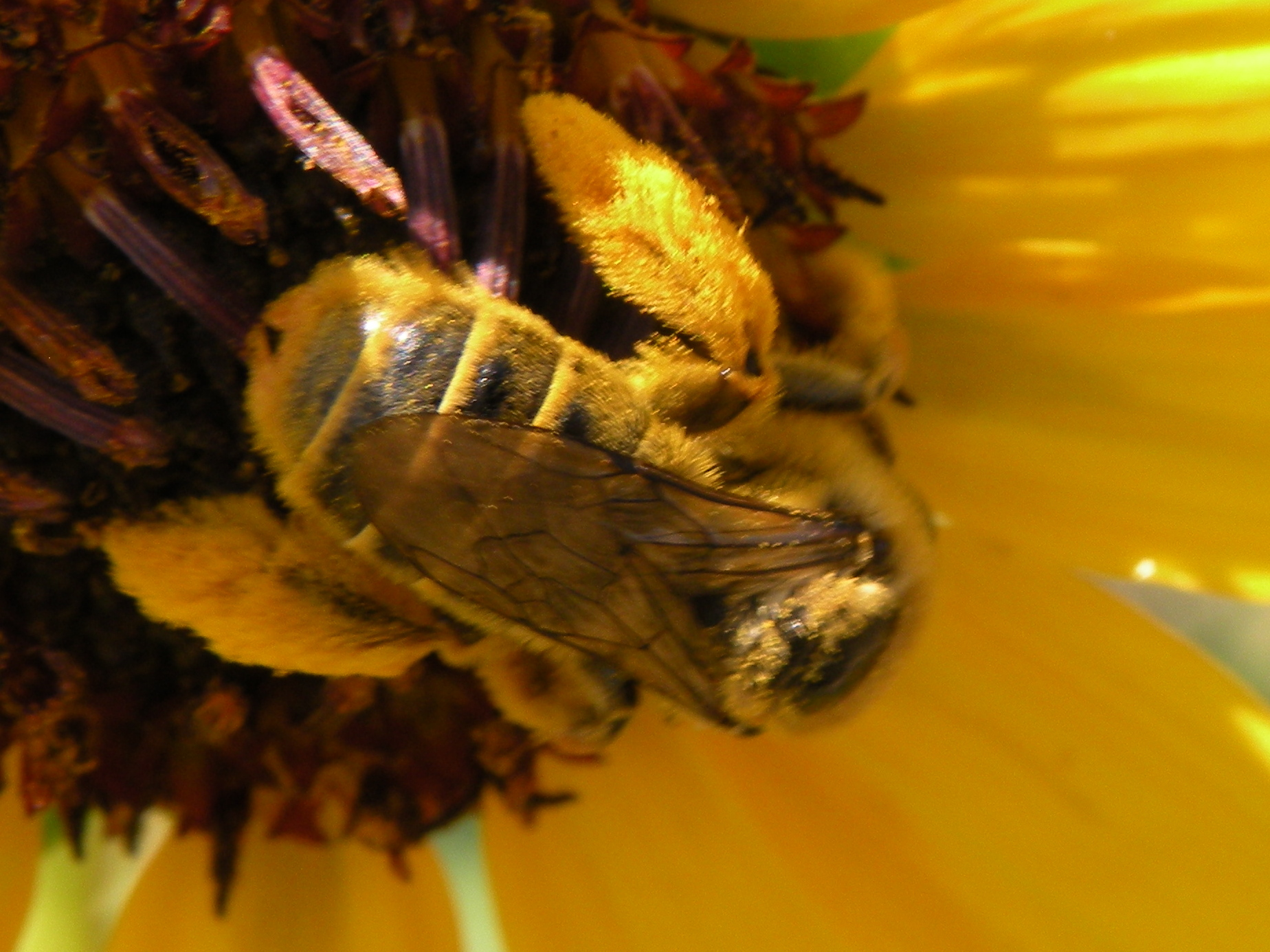
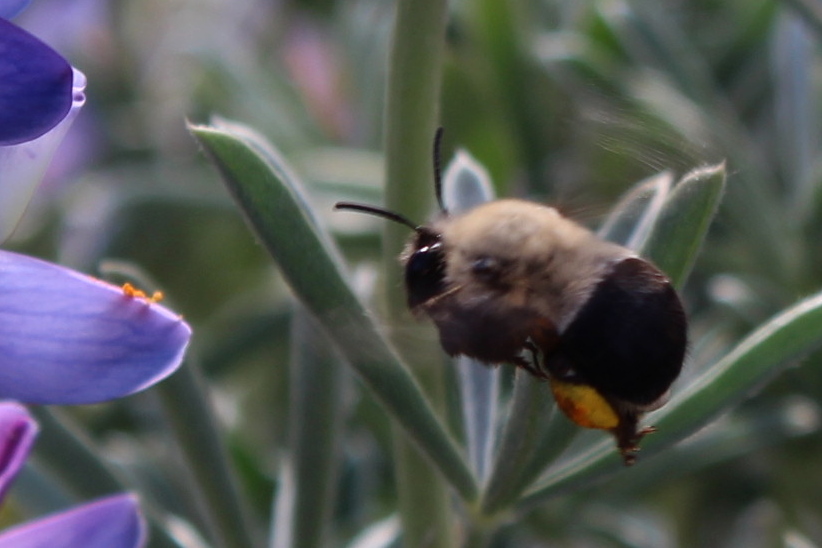 Venue: Topping Room, E.P. Foster Library, E. Main Street, Ventura, California. Park in the back of the library, or on Main Street if you can find a spot..
Tuesday |
21 June2016 7:00 to 9:00 PM
Talk |
Ventura County
|
Speaker: Peter Jump. Peter will be speak on the effects of the drought on native plants, and how it is effecting the insect life of the Carrizo Plains and Cuyama. For more information, call Andrea at 805/684-8077 or email aadamsmorden@yahoo.com. Venue: Topping Room, E.P. Foster Library, E. Main Street, Ventura, California. Park in the back of the library, or on Main Street if you can find a spot.
|
Saturday |
25 June 2016 9:00 AM to Noon
Walk |
Santa Barbara County
East Carpinteria Bluffs Survey Walk
|
Leaders: Andrea Adams-Morden. Help us explore the resources of this property overlooking the Pacific Ocean west of Carpinteria. Bring binoculars, water, and a snack. For more information, call Andrea at 805/684-8077 or email aadamsmorden@yahoo.com. Venue: Mother Nature's Carpinteria Bluffs, Carpinteria. We will meet at the dirt parking area on the sea side just west (toward town) of the Highway 150/Carpinteria Avenue junction. No restrooms are available (except behind the bushes). Parking is free.
|
Tuesday |
19 July 2016 7:00 to 9:00 PM
Talk |
Santa Barbara County
California Big Tree Project
|
Speaker: Natalie Rossington. Natalie will describe the California Big Tree Project, which is about finding and documenting the biggest examples of every tree growing in California. For more information, call Andrea at 805/684-8077 or email aadamsmorden@yahoo.com. 
 Venue: Santa Barbara Botanic Garden, 1212 Mission Canyon Road, Santa Barbara, California. Parking is free.
|
Tuesday |
16 August 2016 7:00 to 9:00 PM
Talk |
Ventura County
Botanist Certification AND the CNPS Rare Plant Treasure Hunt
|
Speaker: David Magney, CNPS Rare Plant Program Manager. David will talk about the details of the newly established certification program for consulting botanists, and about the CNPS Rare Plant Treasure Hunt. CNPS is administering the new program to certify consulting and field botanists in California. Certification will be by examination only, meaning that only those individuals that can demonstrate their knowledge about field botany and/or consulting botany by passing extensive examination will be certified. David, who is chairman of the Board of Certification, will describe the program in detail. David will also talk about the Rare Plant Treasure Hunt, which CNPS has been leading for a few years now. Currently, CNPS is focusing on those rarest of rare plants in California that have not been seen in over 20 years. CNPS staff and chapters coordinate field events to find historic occurrences of the target species and work to find additional populations, which is a truly rewarding endeavor. David will talk about what plants are being targeted in the Channel Islands Chapter's region. For more information, call David at 916/447-CNPS or email dmagney@cnps.org. Venue: Topping Room, E.P. Foster Library, E. Main Street, Ventura, California. Park in the back of the library, or on Main Street if you can find a spot.
|
Tuesday |
20 September 2016 7:00 to 9:00 PM
Talk |
Santa Barbara County
Project Baseline
|
Speaker: Heather Schneider, PhD. Heather will describe the Project Baseline. For more information, call Andrea at 805/684-8077 or email aadamsmorden@yahoo.com. Venue: Santa Barbara Botanic Garden, 1212 Mission Canyon Road, Santa Barbara, California. Parking is free.
|
Tuesday |
18 October 2016 7:00 to 9:00 PM
Talk |
Ventura County
TBD
|
Speaker: TBD. We are working on another great and interesting talk. For more information, call Andrea at 805/684-8077 or email aadamsmorden@yahoo.com. Venue: Topping Room, E.P. Foster Library, E. Main Street, Ventura, California. Park in the back of the library, or on Main Street if you can find a spot.
|
Tuesday |
15 November 2016 7:00 to 9:00 PM
Talk |
Santa Barbara County
Dudleya - The Live-forevers
|
Speaker: Steve McCabe. Steve will talk about his research and knowledge of the genus Dudleya, that group of succulent plants that have many very rare species. For more information, call Andrea at 805/684-8077 or email aadamsmorden@yahoo.com. 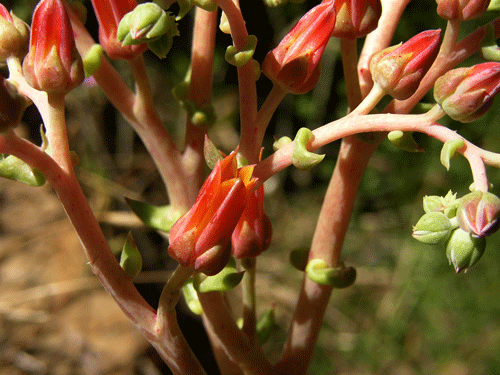
 Venue: Santa Barbara Botanic Garden, 1212 Mission Canyon Road, Santa Barbara, California. Parking is free.
|
Tuesday |
20 December 2016 7:00 to 9:00 PM
Talk |
Ventura County
TBD
|
Speaker: TBD. We are working on another great and interesting talk. For more information, call Andrea at 805/684-8077 or email aadamsmorden@yahoo.com. Venue: Topping Room, E.P. Foster Library, E. Main Street, Ventura, California. Park in the back of the library, or on Main Street if you can find a spot.
|
Saturday |
23 April 2016 10:00 AM to 1:00 PM
Walk |
Santa Barbara County
Hike along Prehistoric and Historic Fremont Ridge Trail
|
Leaders: Gloria Hall. Gloria lead an easy 3-4-mile hike up along Fremont Ridge Trail on the crest of the Santa Ynez Mountains to see what bloomed this spring after the rainfall. Gloria and fellow CNPS members and California Naturalists hiked down a portion of the Fremont trail off of East Camino Cielo. The group also hiked up to the Coulter Pine forest. The views were beautiful and the weather was perfect. We added 30 more plants to the plant list bringing the list to a total of 74. The blooming plant highlights were the Snowdrop Bush (Styrax redivivus), Woolly Bluecurls (Trichostema lanatum), Pitcher Sage (Lepechinia calycina), and Chaparral Pea (Pickeringia montana). The plant checklist for this hike is available on the Plant Checklists webpage. 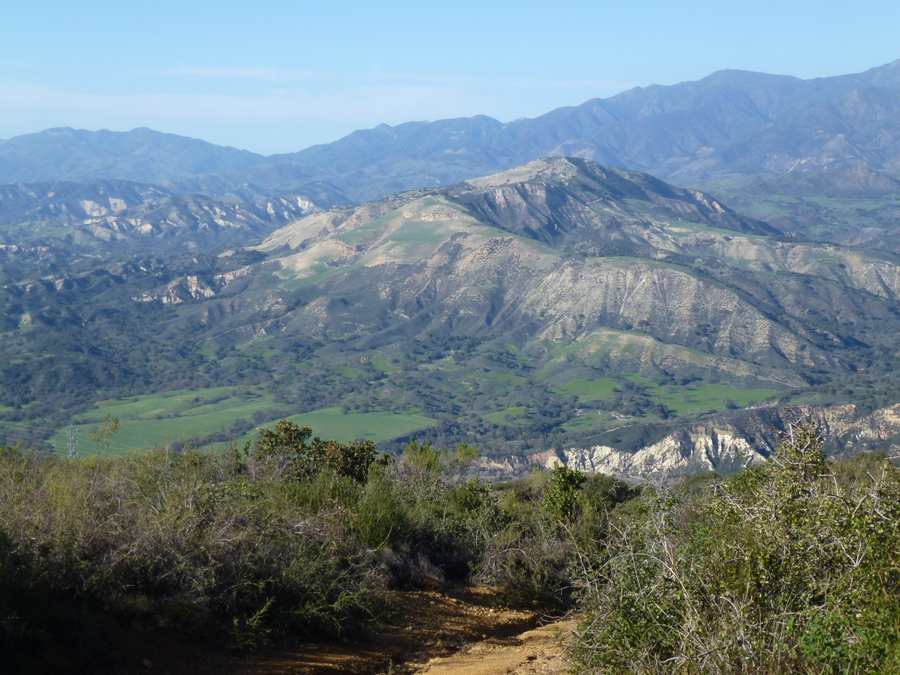
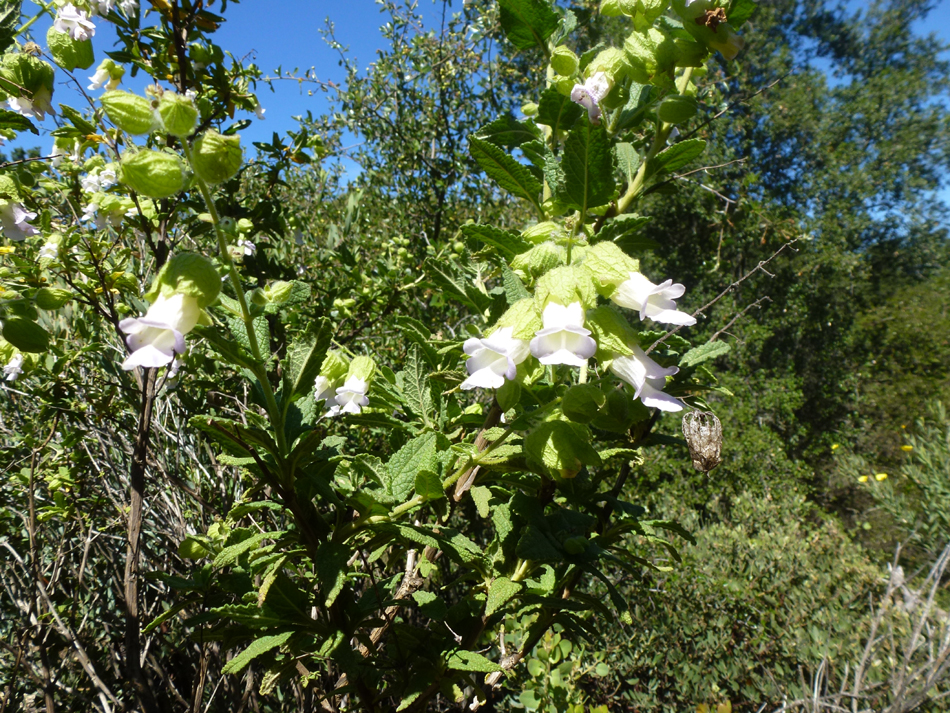 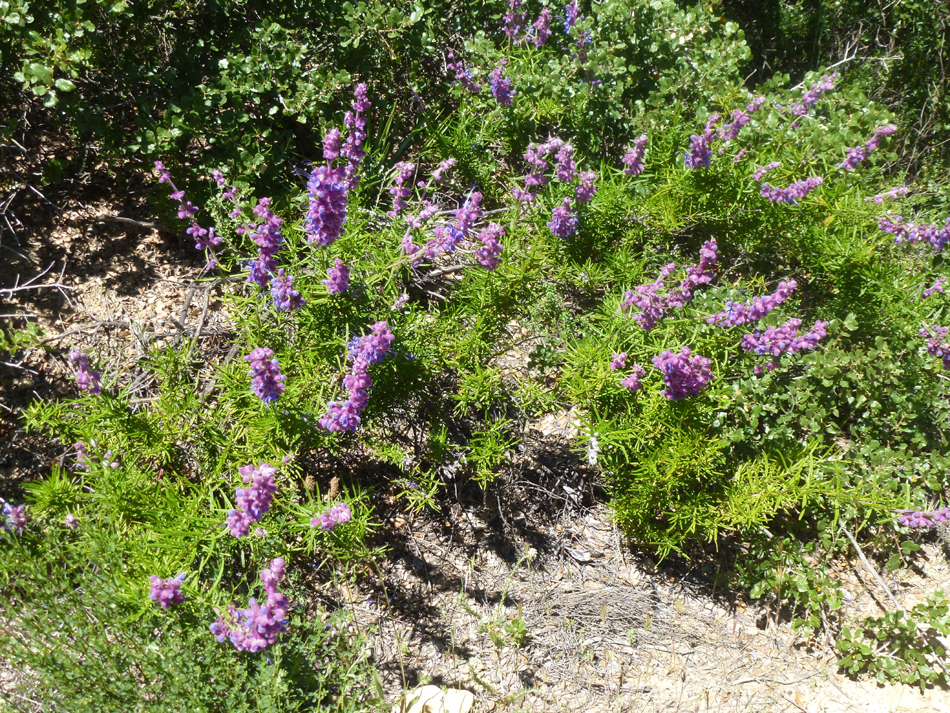
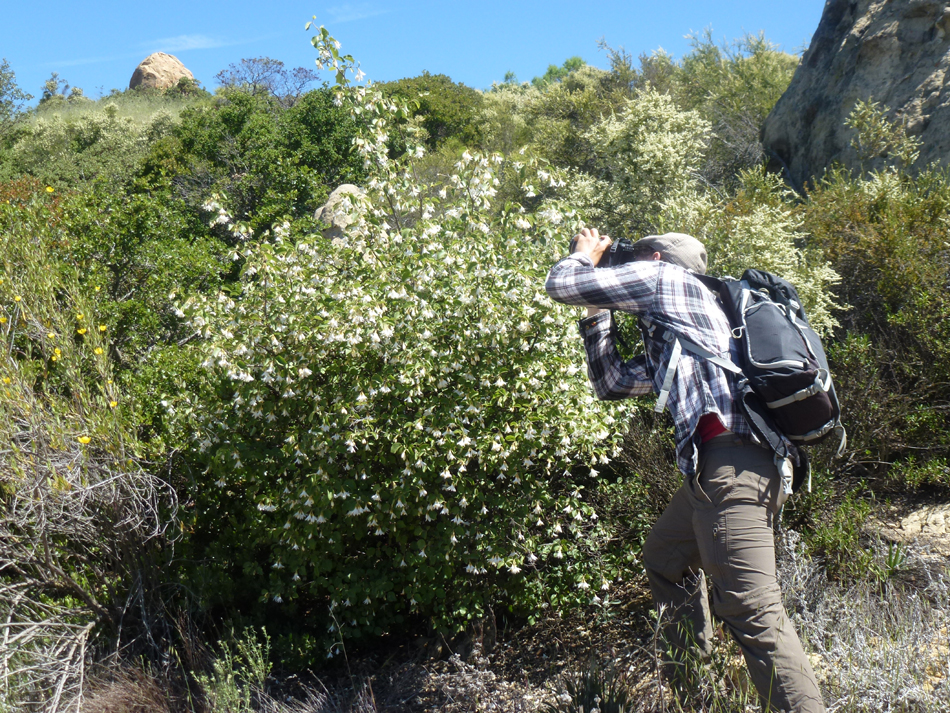 Photos by Gloria Hall Directions: From U.S. 101 in Santa Barbara, take State St./ State Route 154 exit. Turn NW on SR 154/San Marcos Pass Road. Drive 7.8 miles to East Camino Cielo Road on the right. Turn right and continue for about 1.6+ miles and look for a dirt road on your left with a metal gate. You’ll know if you’ve gone too far if you come to the turn off for Painted Cave Road. Parking is found along the road, on the left beyond the trailhead gate.
|
Tuesday |
19 April 2016 7:00 to 9:00 PM
Talk |
Ventura County
California's Prairies
|
Speaker: Glen Holstein, PhD. A Visit to the California Prairie. The earliest visitors to California’s valleys and foothills found a sea of wildflowers where grasses were scarce and vast elk herds grazed. Why then do so many call these areas “grasslands” when even today native wildflowers can so completely cover them that hardly a grass blade is seen? Answering that takes looking back at some plant ecology history still hugely effecting California native plant conservation. California’s prairies are its lost ecosystem hiding in plain sight. A nice group of over a dozen members listened as Dr. Holstein explored their misunderstood history, their unique ecology, their great biodiversity, and their urgent conservation challenges. Dr. Holstein first learned about California’s plants and wildlife in the chaparral and deserts of southern California. That inspired him to get a degree in biology at Cal Poly San Luis Obispo and then go on to graduate school in botany at UC Davis in the great days when Ledyard Stebbins, Dan Axelrod, Jack Major, and Grady Webster were there. He took a few years off to help found the California Natural Diversity Data Base, participate in creation of the Cosumnes, Cold Canyon, Nipomo Dunes, and Carrizo Plains reserves, and do a chapter on riparian biogeography for Warner & Hendrix’s California Riparian Systems before completing his PhD with a dissertation on climatic influence on plant physiognomy across world biomes. Glen first became a CNPS member soon after it was founded in the nineteen-seventies and when he retired he became an active CNPS volunteer. Starting first as Sacramento Valley Chapter Botanist he soon became its Chapter Council Delegate and then a member of its state Board of Directors while also serving on boards of Yolo County’s Conservation Plan, Tuleyome, and Habitat 2020. Recent projects included guest editing and writing 3 articles for a 2011 issue on California’s prairies and grasslands for the CNPS journal Fremontia and a giving a talk on the subject for its 2015 San Jose Conservation Conference. For his conservation work Glen was named 2013 Environmentalist of the Year by the Environmental Council of Sacramento. 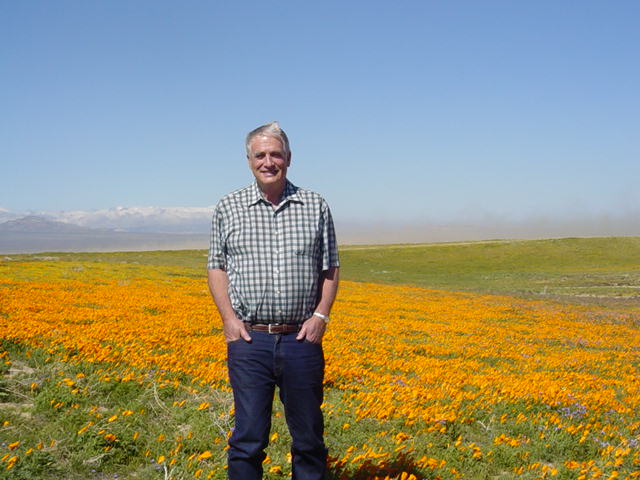
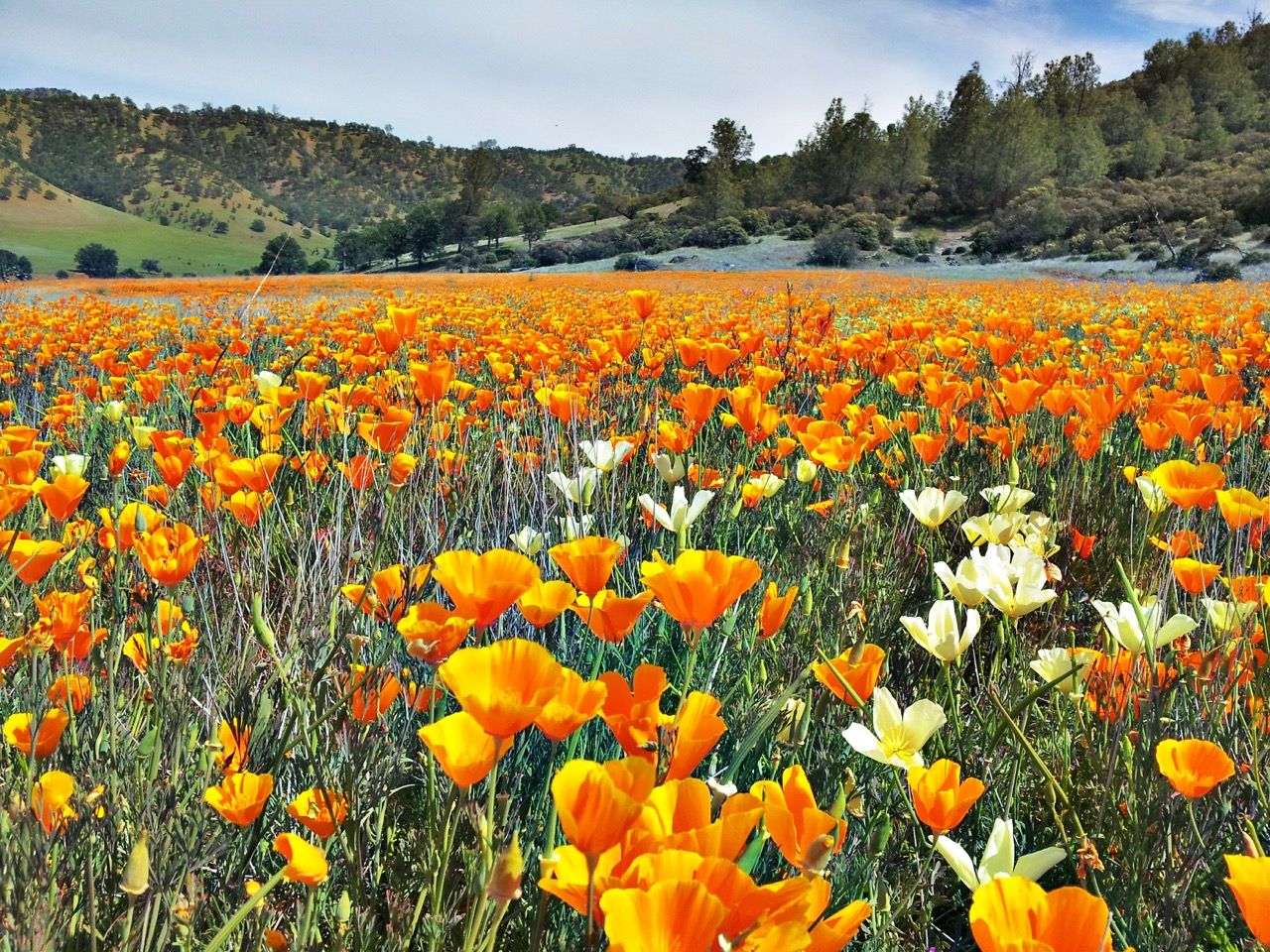 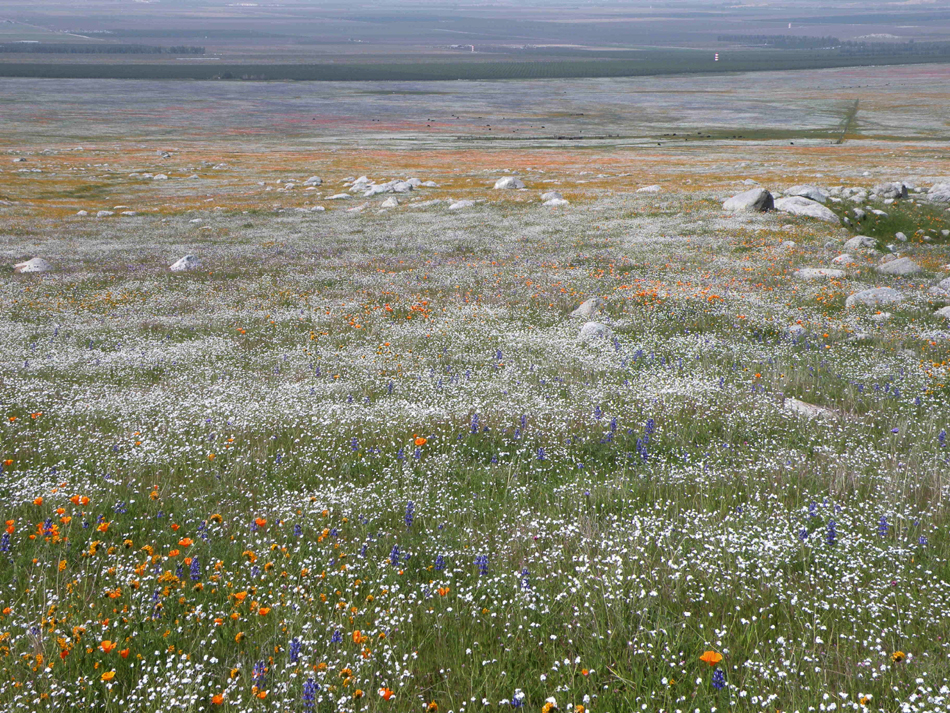
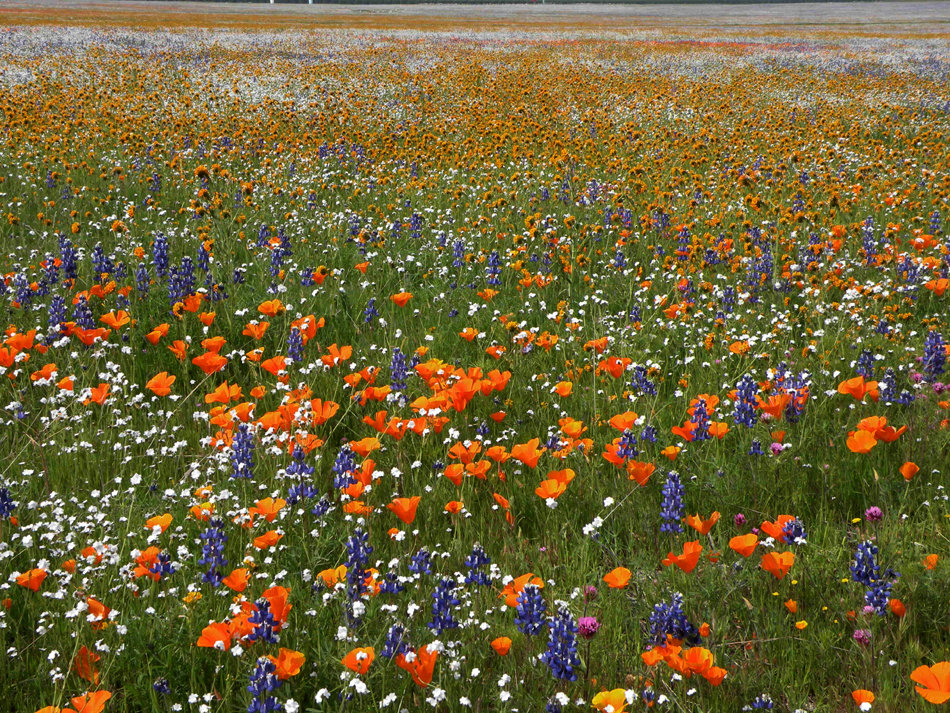
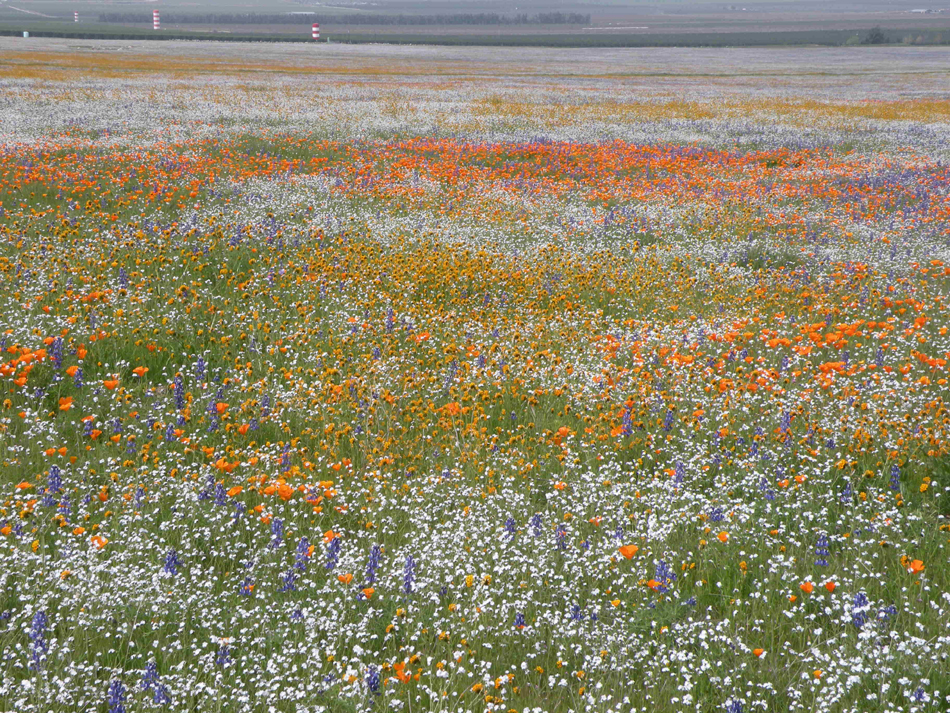
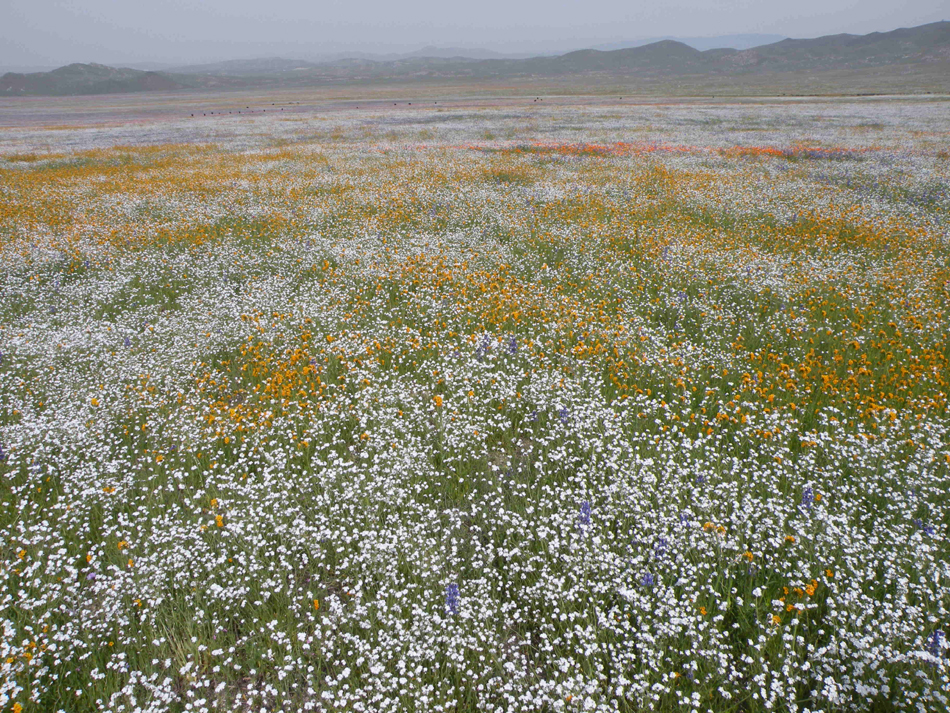
|
Sunday |
17 April 2016 9:00 PM - 1:00 PM
Hike |
Cozy Dell Trail Ojai, California
Botany, Bird, and Butterfly Hike
| Leader: David Torfeh. A nice group enjoyed the spring and celebrate Native Plant Week with an introduction to the botany (and some birds and butterflies) of Cozy Dell Trail in the Ojai Front Country, just south of the Los Padres National Forest boundary. This was not be a strenuous hike because there were many stops to view the profusion of plants in bloom. However, there was a moderate elevation gain. The oak and chaparral shaded north-facing slopes of the Cozy Dell area held many surprises. Local botanist David Magney has created a plant checklist for the trail and placed it our website at Plant Checklists webpage. Additional species where found during the hike, so Magney's list will be updated accordingly. The new plants observed included: Acourtia microcephala, Aphanus occidentale, Anthriscus caucalis, Apiastrum angustifolium, Cerastium glomeratum, Clarkia epiloides, Conium maculatum, Cotula australis, Dendromecon rigida, Epilobium canum ssp. canum, Eriogonum fasciculatum var. foliolosum, Geranium carolineum, Geranium mollis, Melilotus indicus, Nicotiana glauca, Pholistoma auritum var. auritum, Poa secunda ssp. secunda, Pseudognaphalium bioletti, Pterostegia drymarioides, Ranunculus hebecarpus, Salvia columbariae, Sisymbrium orientale, Stipa lepida, Thysanocarpus curvipes, and Trifolium ciliatum. That is actually quite a few additions! 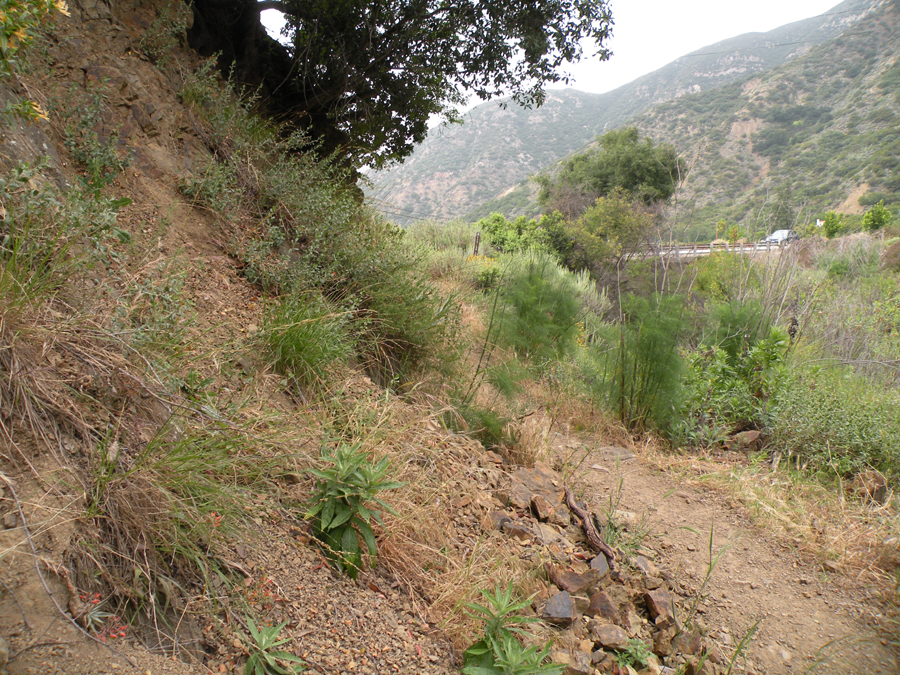
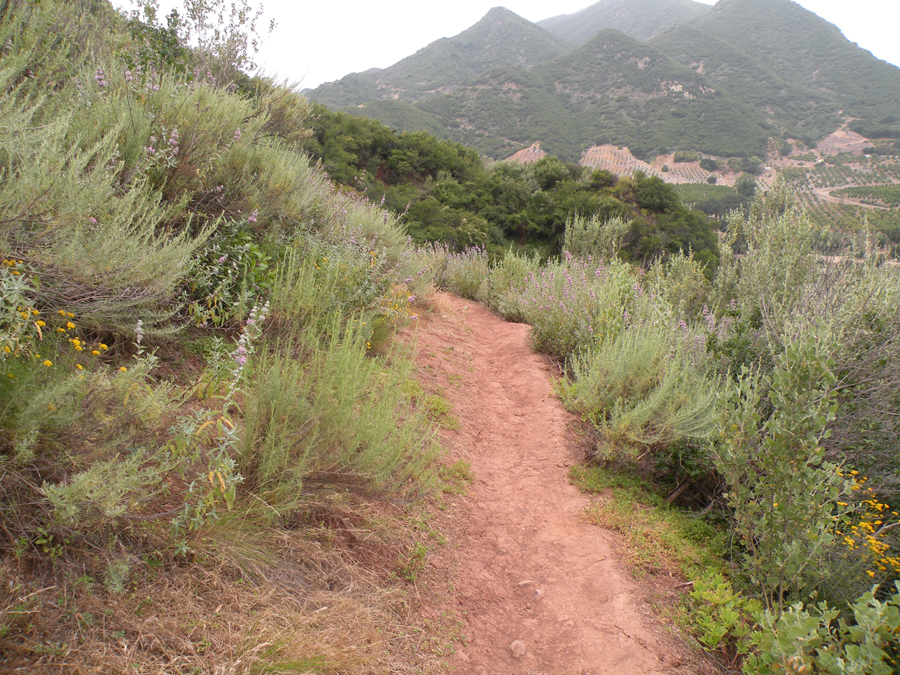
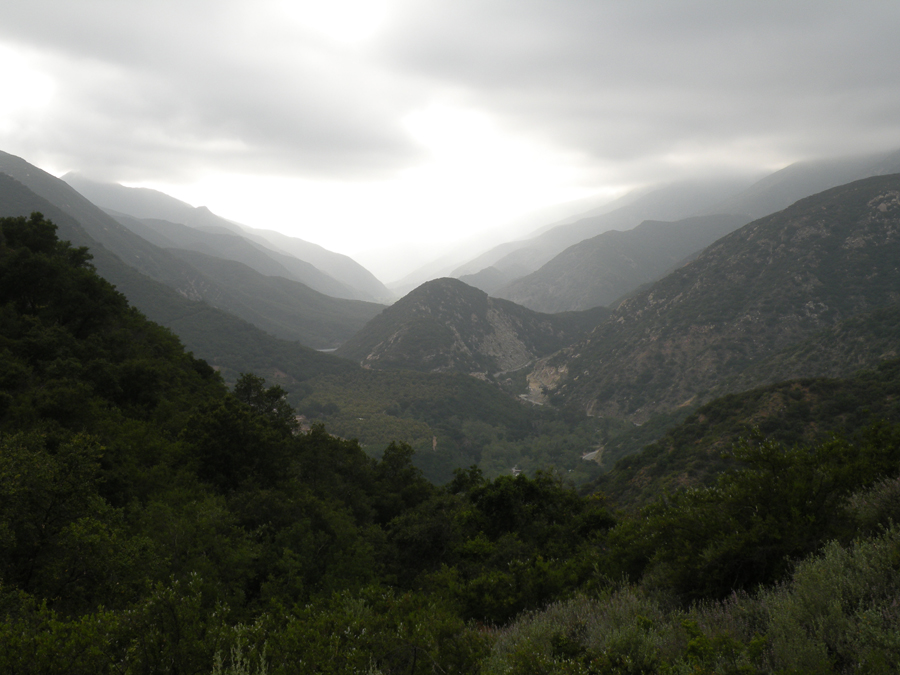
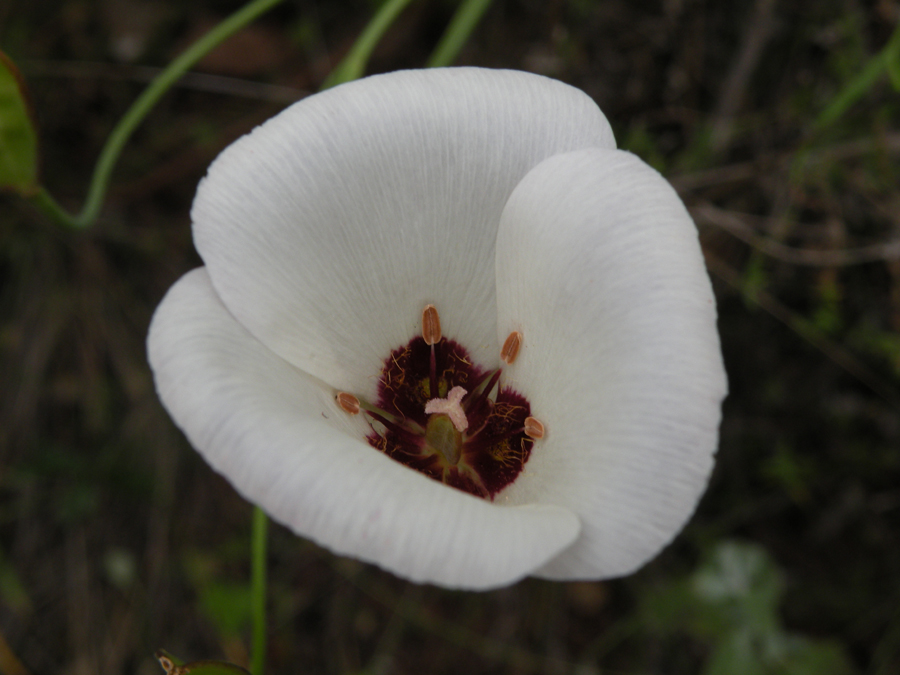
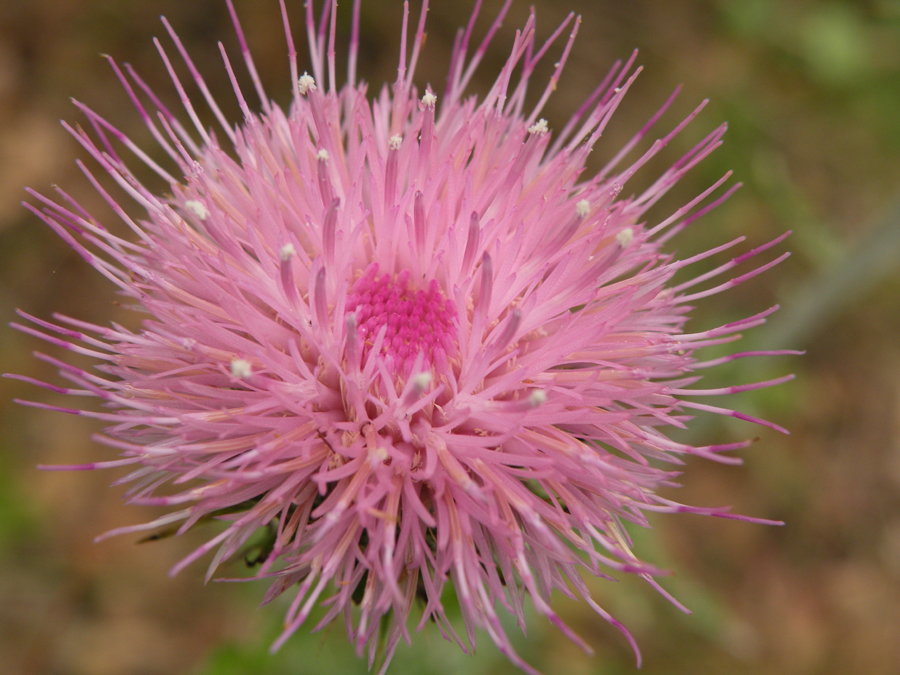
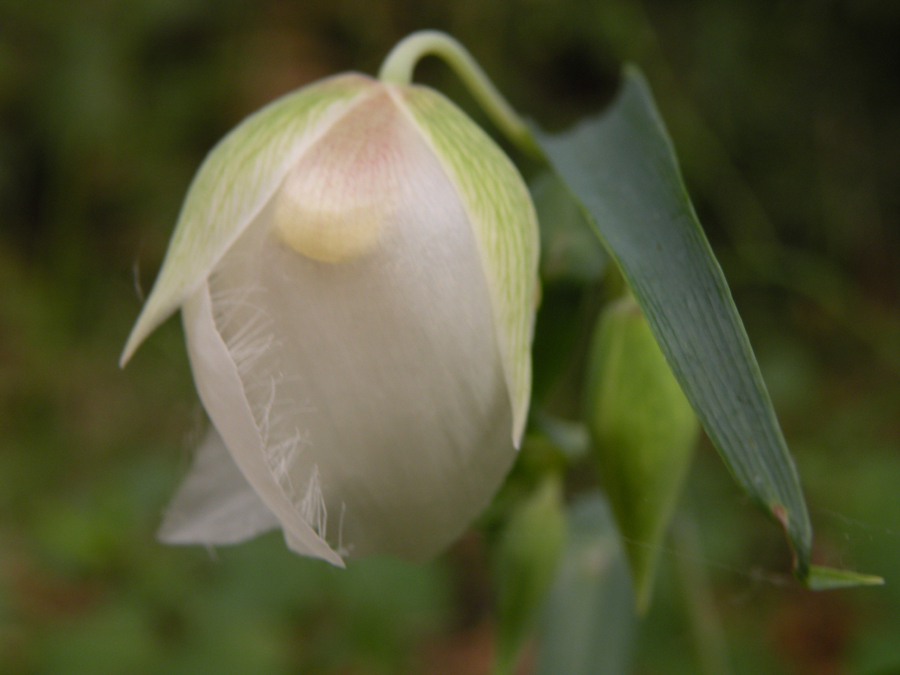
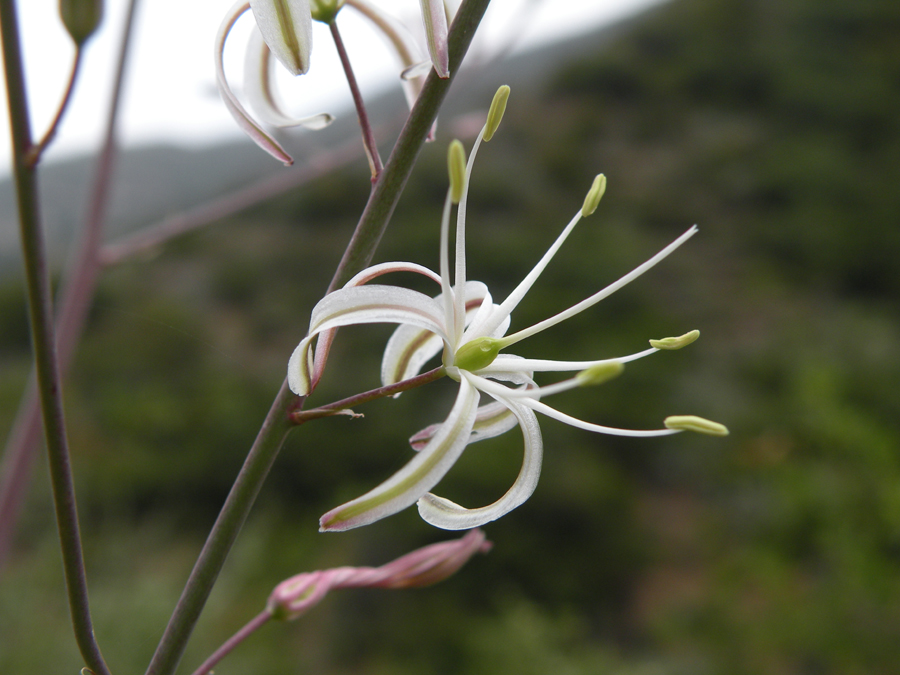
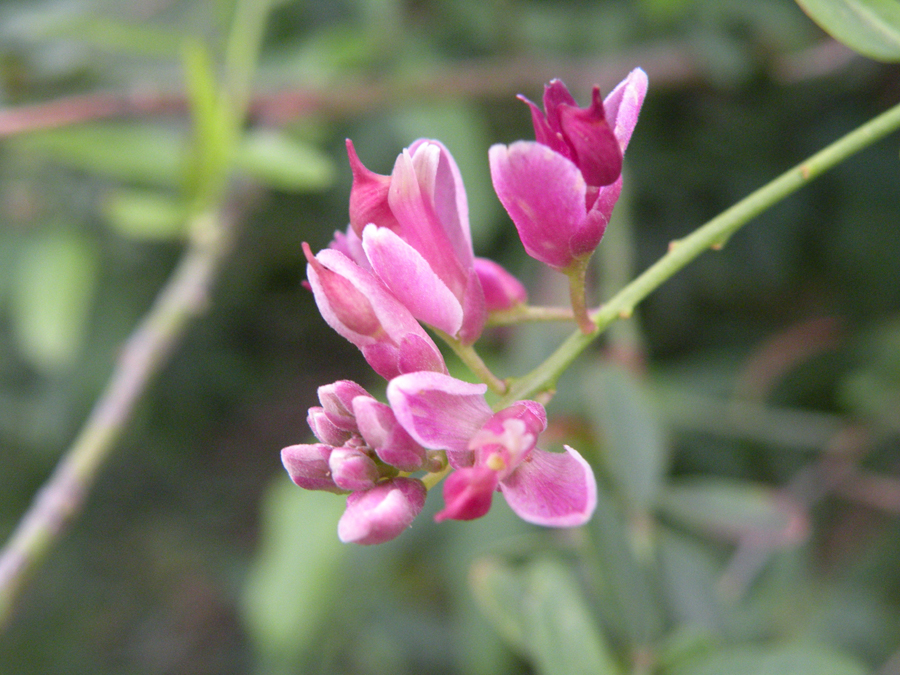
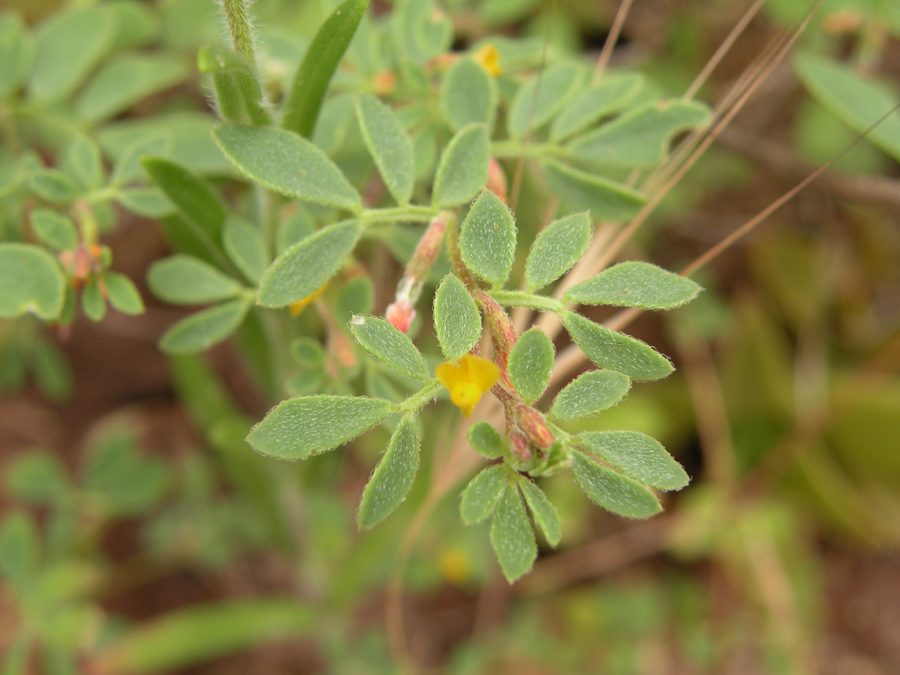
Photos by David L. Magney
|
Saturday |
9 April 2016 8:45 AM to Noonish 1:00 PM to 3:00 PM
Moss Walk |
Santa Barbara County
Meet the Bryophytes in the Field in Rattlesnake Canyon
|
Speakers: Paul Wilson and Amanda Heinrich. Paul and Amanda will lead a few members on an outdoor exploration for our local bryophytes in Rattlesnake Canyon. We saw liverworts and hornworts too, besides the ever-present mosses. The weather permits a walk in the woods, i.e. not raining hard. Those attending were provided a photo identification guide handout, which really help you learn to recognize the more common bryophyte genera. Bring a handlens for the moss walk. Also bring your lunch to eat either in Rattlesnake Canyon, Skofield Park, or at the Santa Barbara Botanic Garden. 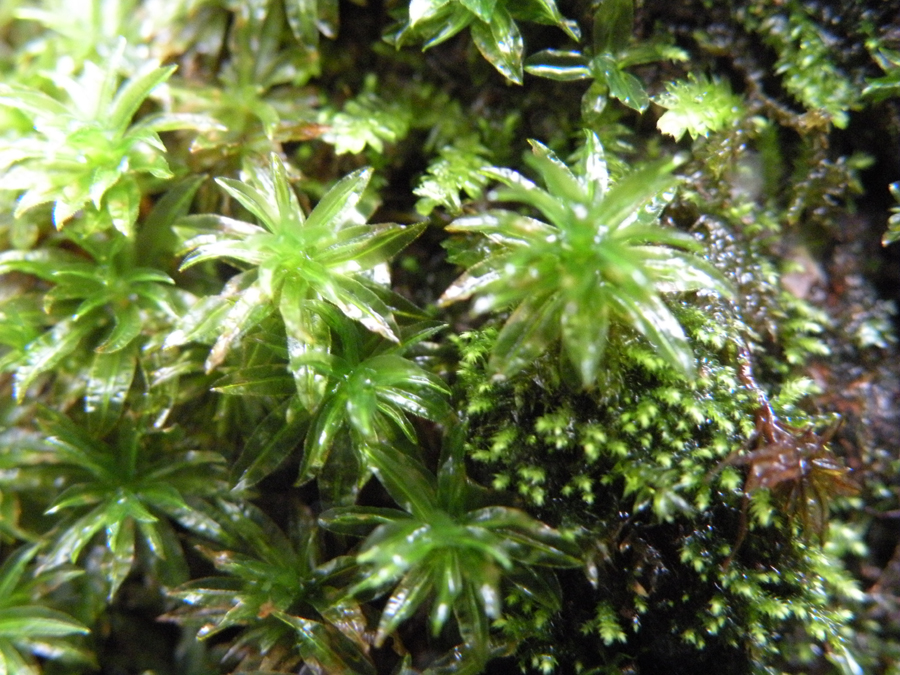
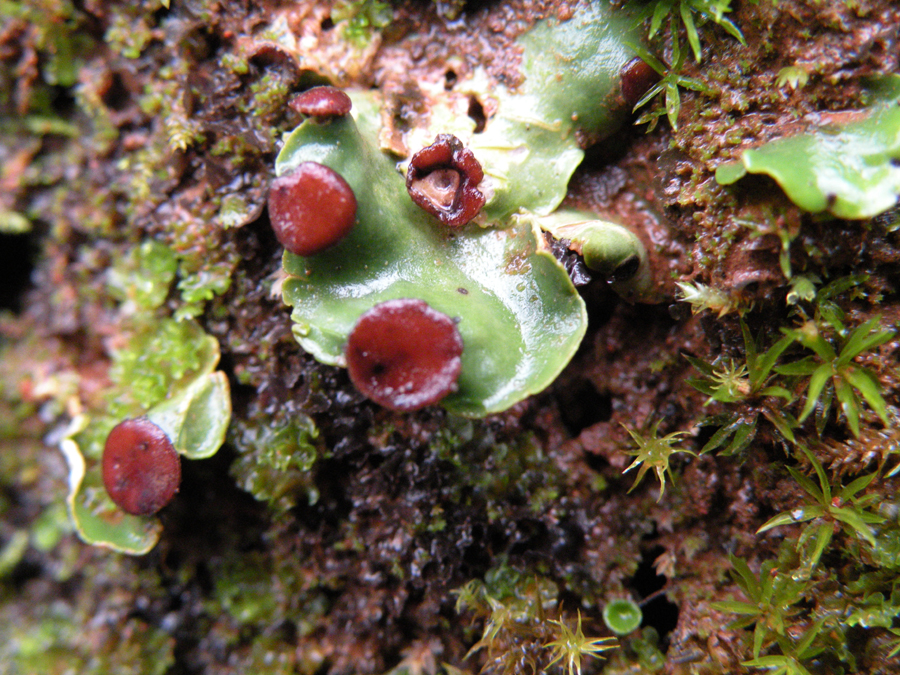 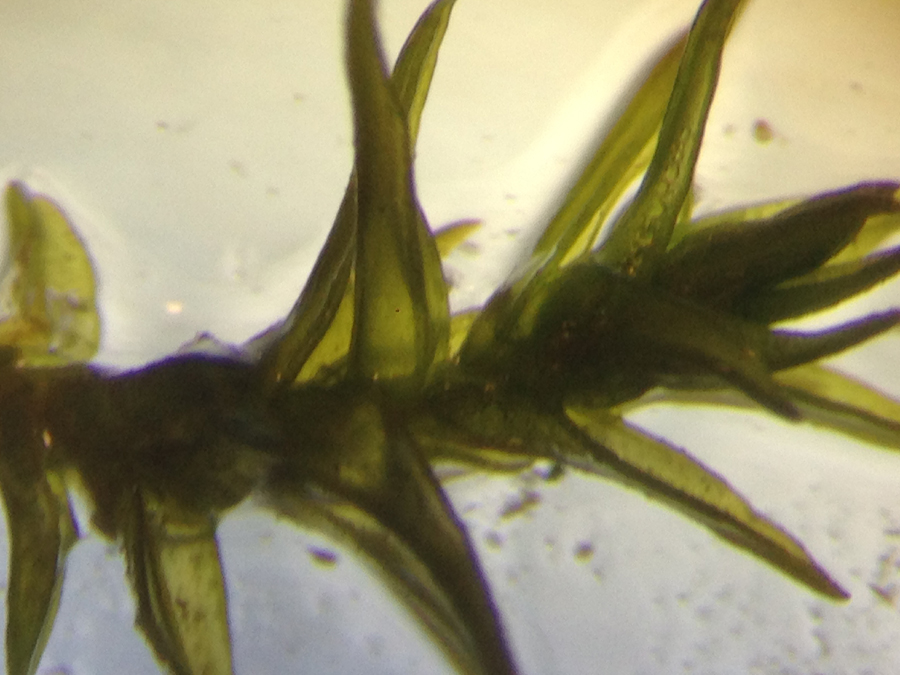
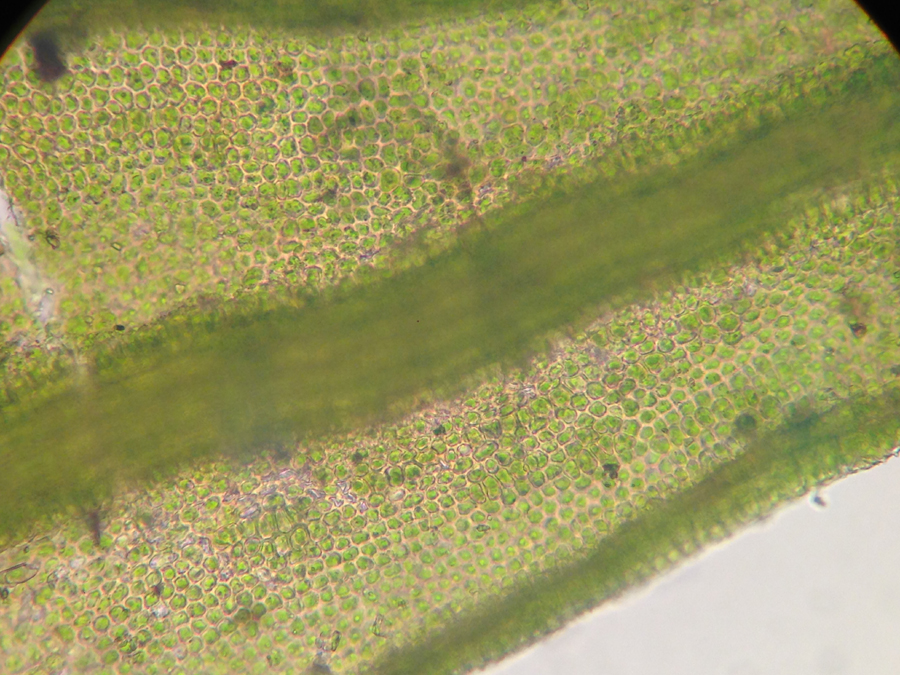
Photos by David L. Magney
|
Saturday |
5 March 2016 9:00 AM to 2:00 PM
Walk |
Ventura County
Sulphur Mountain Plant Hike and Bird Walk
|
Leaders: David Torfeh and Saudamini Sindhar. Naturalist David Torfeh and Botanist Saudamini Sindhar will lead an easy hike up the west side of Sulphur Mountain to see what has bloomed this winter after the rainfall so far. The annuals have sprouted nicely and the ground is green with plants. Participants will learn about the plants and birds of Sulphur Mountain. David Magney previously prepared a checklist of the plants that can be found on this hike, available on the Plant Checklists page of this website. Bring your unknown native plants to ID before the talk. Bring a lunch, lug-soled boots/shoes, sunscreen, water, a hat, and maybe a camera. 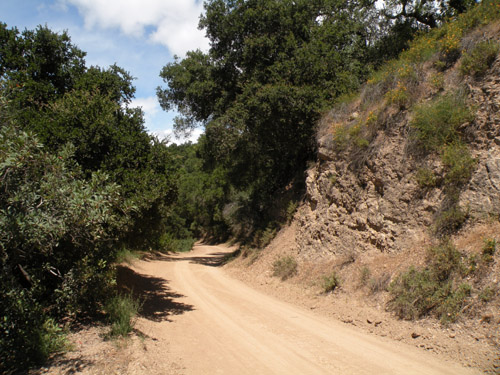
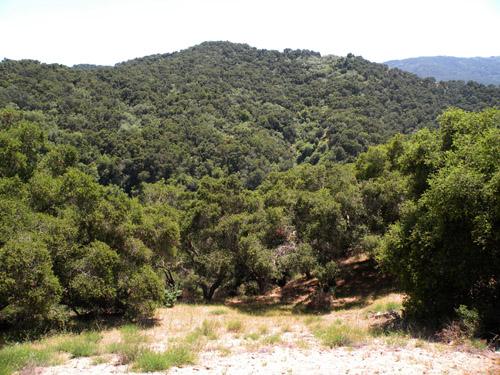
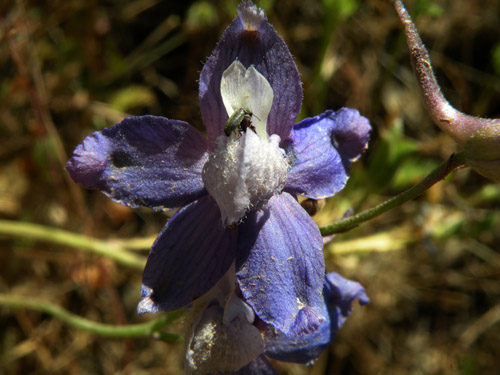
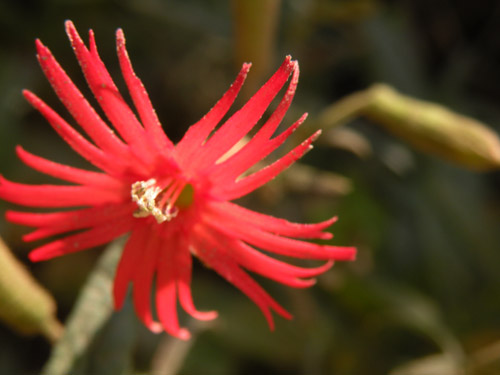
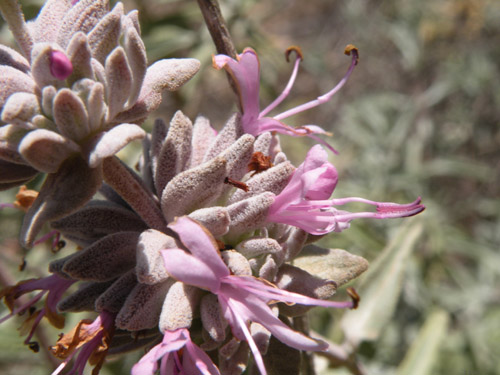
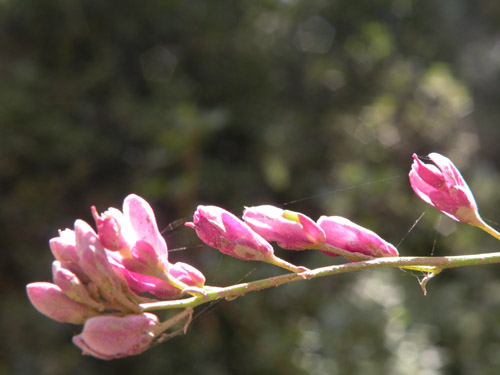 Photos by David Magney from May 2011 Venue: Sulphur Mountain, west end, along Sulphur Mountain Road (dirt). Meet at the west end of Sulphur Mountain Road off of State Route 33 at the locked gate. No restrooms are available (except behind the bushes). Parking is free. Directions: From the 101 Freeway in Ventura, take Highway 33 north (toward the mountains). After roughly 6 miles on SR 33 (just after passing through the town of Casitas Springs), turn right on Sulphur Mountain Road, and park along the road near the Girl Scout Camp. From Ojai, take State Route 150 west (toward Meiners Oaks) to State Route 33, heading south (toward Ventura). After passing through Oak View, turn left on Sulphur Mountain Road from State Route 33 and park along the road near the Girl Scout Camp.
|
Saturday |
20 February 2016 10:00 AM to Noon
Nature Walk |
Santa Barbara County
Carpinteria's Dune and Salt Marsh Plant Communities
|
Leader: Andrea Adams-Morden. A nice nature walk around Carpinteria's dune and saltmarsh plant communities was had by those that attended. 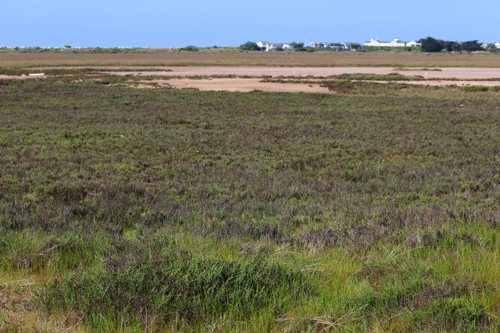
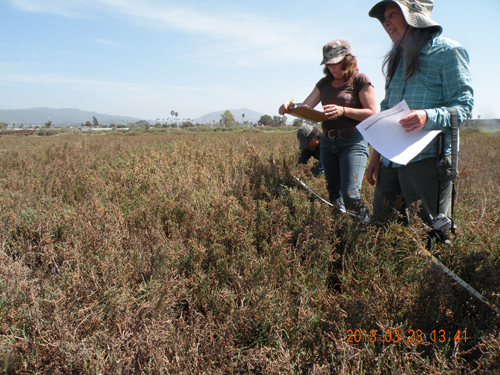
Venue: entrance to the Carpinteria Salt Marsh Nature Park at the corner of Sandyland and Ash Avenue.
|
Tuesday |
16 February 2016 7:00 to 9:00 PM
Talk |
Ventura County
Does the Endangered Species Act Help Recover Listed Plant Species?
|
Speaker: Connie Rutherford. The federal ESA is one of our premier environmental laws, but are our plants any better off? Using examples of listed plant species from the central coast counties, Connie talked about some of the progress that has been made, as well as the setbacks that have been encountered along the way, in furthering conservation and recovery efforts. Plants highlighed included Nipomo Lupine (Lupinus nipomoensis), Island Rush-rose (Helianthemum [Crocanthemum] greenei), Island Bedstraw (Galium buxifolium), Hickman's Potentilla (Potentilla hickmanii), Vandenberg Monkeyflower (Diplacus vandenbergensis), San Fernando Valley Spineflower (Chorizanthe parryi var. fernandina), Verity's Dudleya or Live-forever (Dudleya verityi), two varieties of Abram's Cypress (Hesperocyparis abramsii), Camata Canyon Amole (Chlorogalum purpureum var. reductum), Ventura Marsh Milkvetch (Astragalus pycnostachyus var. lanosissimus), Gambell's Watercress (Nasturtium gambellii), and Marsh Sandwort (Arenaria paludicola). Connie Rutherford is Listing and Recovery Coordinator for the U.S. Fish and Wildlife Services Ventura-based office. She is an alum of UC Santa Cruz and Humboldt State University, and spent several adventurous years in the field in Alaska, the Pacific Northwest, Haiti, and the Mojave Desert before settling down in Ventura to a real job and family life. Early in her career, she worked to put a lot of plant species ON the list of endangered species; now she works to get them OFF. Nearly 20 people attended her talk and learned a lot about the work she does to protect our rarest plants. 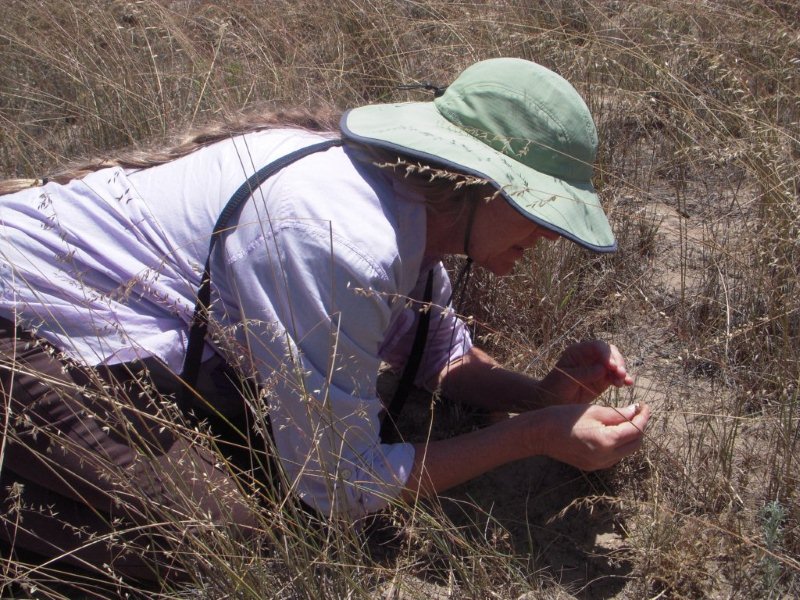
Venue: Topping Room, E.P. Foster Library, 651 E. Main Street, Ventura, California.
|
Saturday |
12 December 2015 9:00 AM to Noon
Walk |
Ventura County
Foster Park Native Plant and Bird Walk
|
Leader: David Torfeh. David will lead an easy to moderate walk around Foster Park, most of the time in the Ventura River bed. Nearly two years ago at this location, 66 plant species were found and 20 different birds observed. Bring water, a hat, lug-soled boots/shoes, sunscreen, and a camera. For a list of plants, visit cnpsci.org and go to Plant Checklists. Meet near the park entrance at 9 AM. Venue and Directions: Foster County Park, near Casitas Springs (mouth of the Ojai Valley). Take the 33 Freeway north (toward Ojai) from the 101 Freeway about 5.6 miles. Exit at Casitas Vista Road and start to go under the 33 Freeway overcrossing. Park on the dirt shoulder on the left under the overcrossing or drive into Foster Park ($4 parking fee) before crossing the bridge over the Ventura River.
|
Wednesday |
9 December 2015 7:15 to 9:00 PM
Talk |
Ventura County
Flora of Mount Pinos
|
Speaker: David Torfeh. Learn about the diverse flora of the Mount Pinos area. Mount Pinos is the the highest peak in Ventura County (8831 feet elevation) and the San Emigdio Mountains. Take a slideshow tour of what can be seen at and near Mount Pinos (in the Los Padres National Forest) in the early summer, which is the height of this area's flowering season. Botanist David Magney has documented about 470 taxa of flowering plants in the Mount Pinos area. Bring your unknown native plants to ID before the talk. 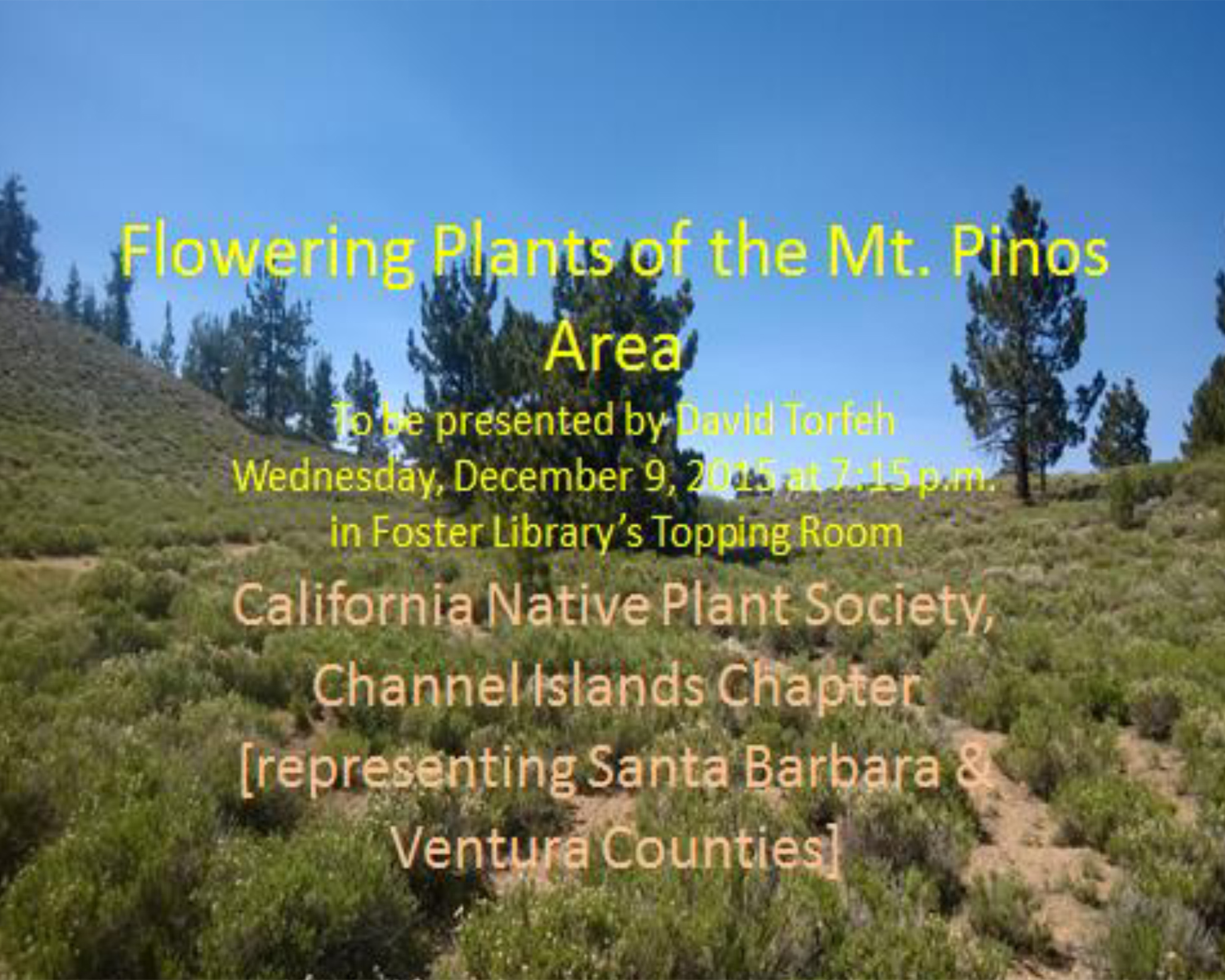
Venue: Topping Room, E.P. Foster Library, 651 E. Main Street, Ventura, California.
|
Saturday |
14 November 2015 9:00 AM - 2:00 PM
Hike |
Sisar Canyon Trail Upper Ojai, California
Fall Colors Plant Hike
|
Leader: Rick Burgess. On an uncharacteristically warm November day, field trip leader Rick Burgess, a skilled botanist (and knoledgable naturalist in general), showed us trees in fall color along Sisar Creek in addition to a wide variety of herbs, and shrubs. Western Sycamore (Platanus racemosa var. racemosa), Fremont Cottonwood (Populus fremontii), and Bigleaf Maple (Acer macrophyllum var. macrophyllum) had turned shades of yellow, orange and/or red, contrasting nicely with the White Alders (Alnus rhombifolia) and other vegetation. Eight people attended the hike. We encountered 81 plant taxa total in Sisar Canyon, with 20 of those taxa exhibiting some flowers (surprising in the fall season with this drought). We found Durango Root (Datisca glomerata) next to the only remaining surface water in the Canyon when we stopped for lunch, and earlier, what appeared to be Peak Rush-rose (Helianthemum scoparium), but not flowering. On a massive, shaded north-facing rock outcrop, we spotted a California Mountain Kingsnake, an uncommon sight (see photo below). Several butterflies and birds were observed, too. Participants were delighted with the day's bounty, and appreciated getting practice recognizing our local native plants and creatures. This canyon is at the base of the Topatopa Mountains (Topatopa Bluffs). David Magney has developed a preliminary checklist of the plants along the Sisar Creek Trail that can be downloaded from the Plant Checklists webpage. See if you can add to the list. 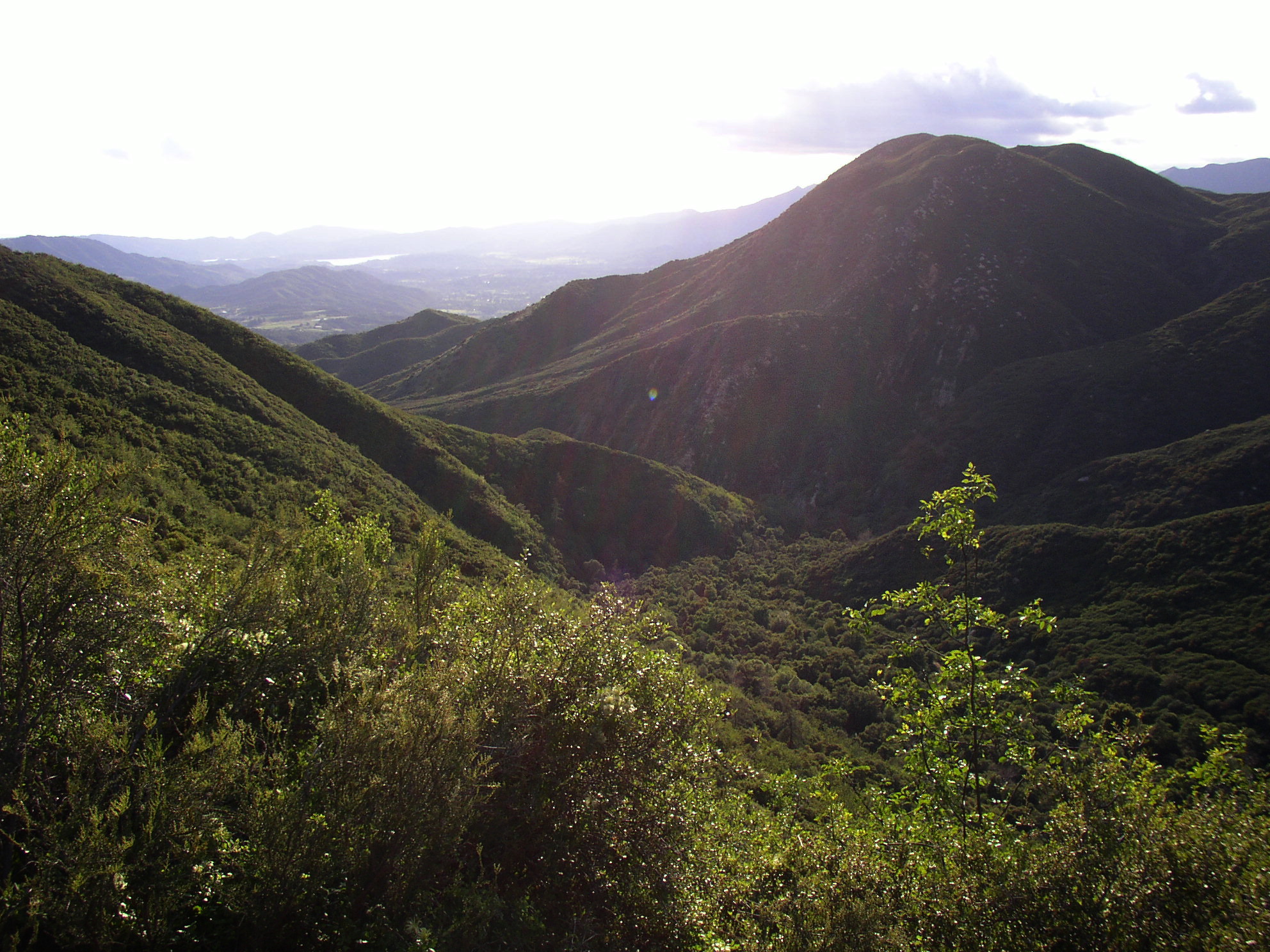
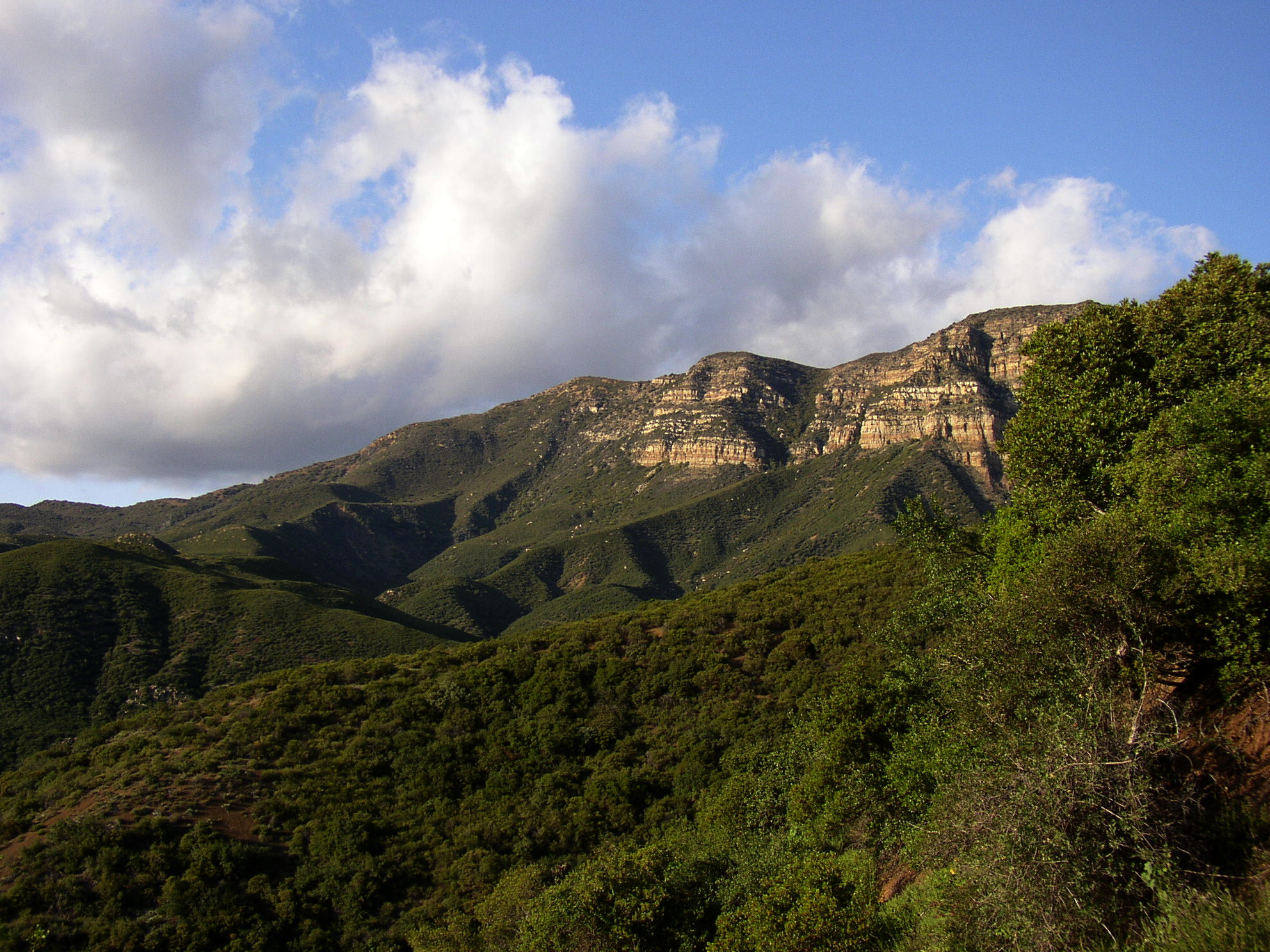
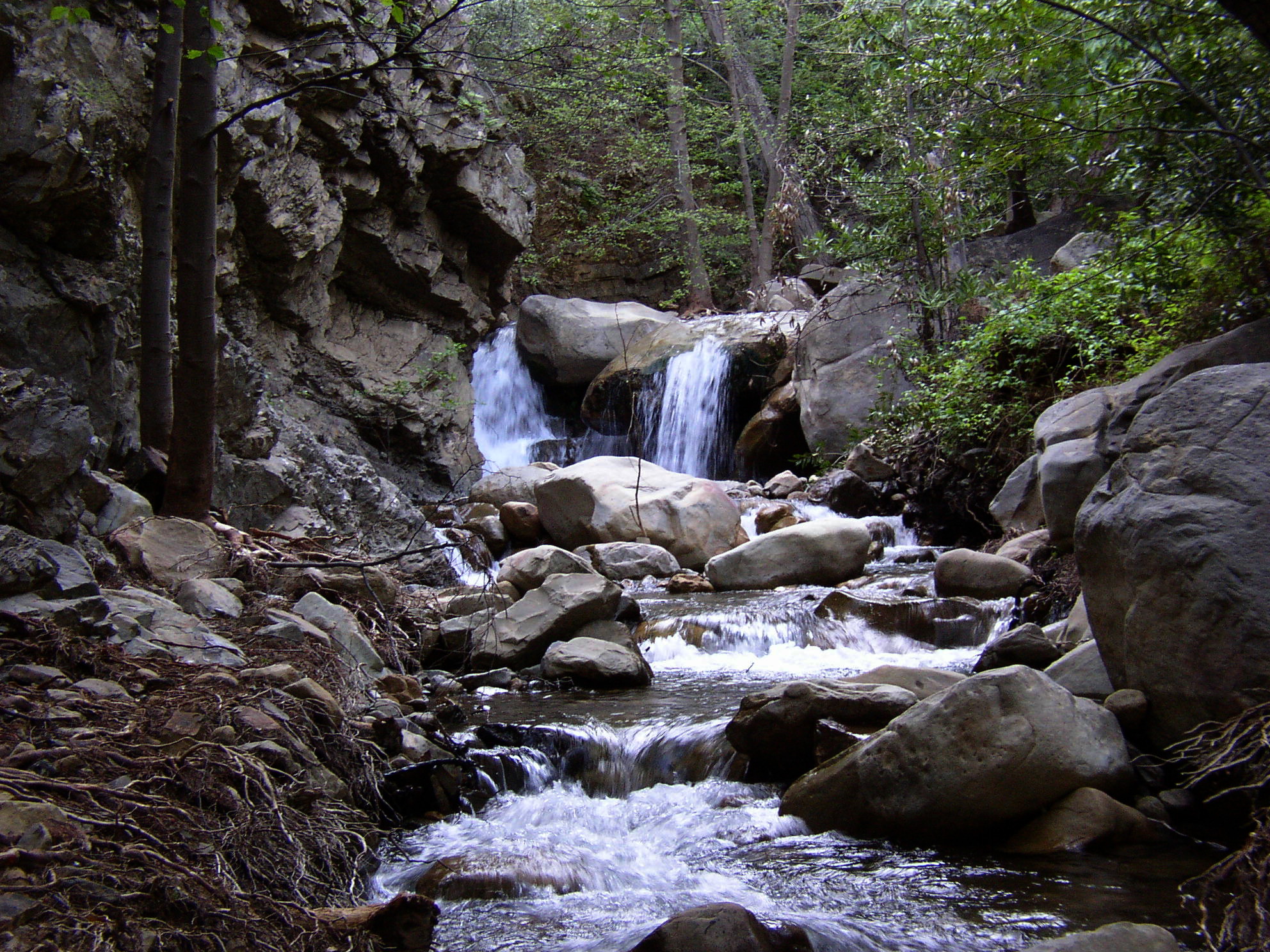
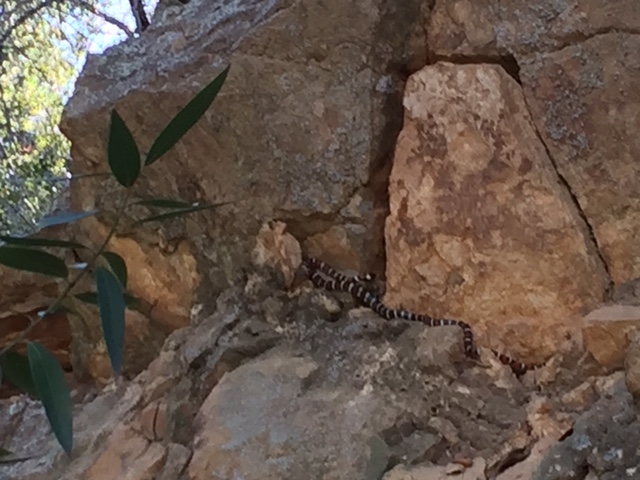
Photos by David L. Magney, snake photo by John Pavelko Directions: (1) From Ventura, take Hwy. 126 east to 10th St. (Hwy. 150) in Santa Paula. Turn left and continue north through Santa Paula, veering right when the road splits. Stay on Hwy. 150 until you see Sisar Road on the right, just past the store and before the school. Drive up Sisar Road slowly, stay right, and park at the locked gate, or back near the highway and walk from there. A high-clearance vehicle is recommended due to the poor condition of the road at the upper end. (3) From Santa Barbara, go east on the 101 Frwy. to Ventura, then follow the “From Ventura…” directions. Alternate routes from Santa Barbara are: (a) 101 Frwy. east to Hwy 150 (starts in Carpinteria) through Ojai or (b) 101 Frwy. east to Hwy 33, then north on Hwy. 33, then right on Hwy. 150 through Ojai. (4) From Fillmore and points east, take Hwy. 126 west to Santa Paula, exit at 10th St. (Hwy. 150), turn right, then follow the directions given for coming from Ventura, starting with “and continue north through Santa Paula…”.
|
Thursday |
12 November 2015 7:15 to 9:00 PM
Talk |
Santa Barbara County
Meet the Bryophytes
|
Speakers: Amanda Heinrich and Paul Wilson. Amanda told us all about bryophytes, otherwise known as mossess, liverworts, and hornworts, and Paul answered the more technical questions. Discover the magic of mosses and their cousins, liverworts and hornworts! We watched mosses rise from the dead and learned to recognize these lovely little plants with biologists Amanda Heinrich and Paul Wilson. After the presentation, we experience the true beauty of actual bryophyte specimens with the aid of hand lenses and microscopes. A board meeting was held immediately preceeding the talk. Paul and Amanda will lead a field trip in the spring of 2016. 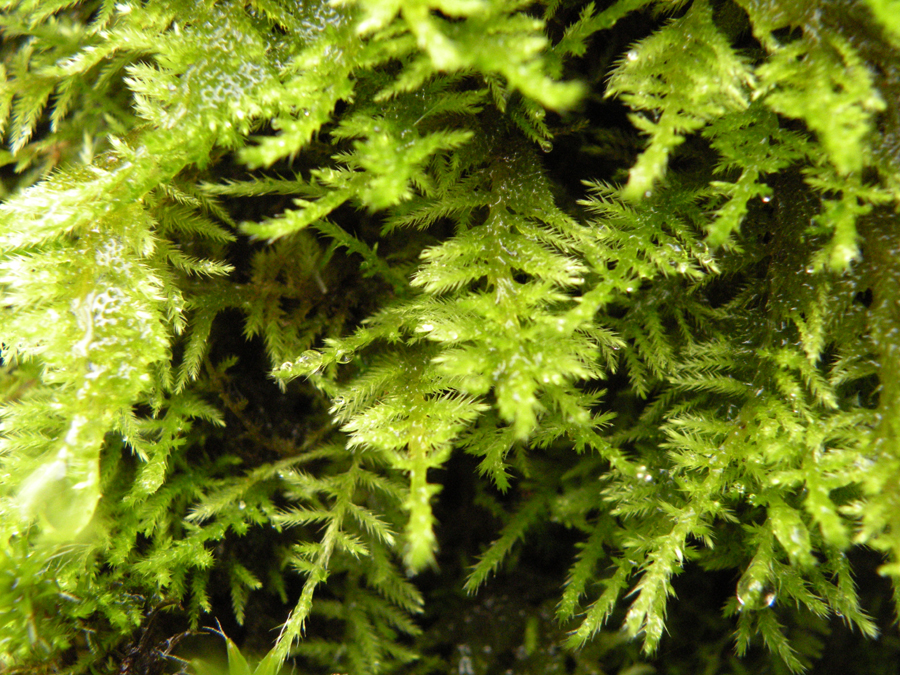
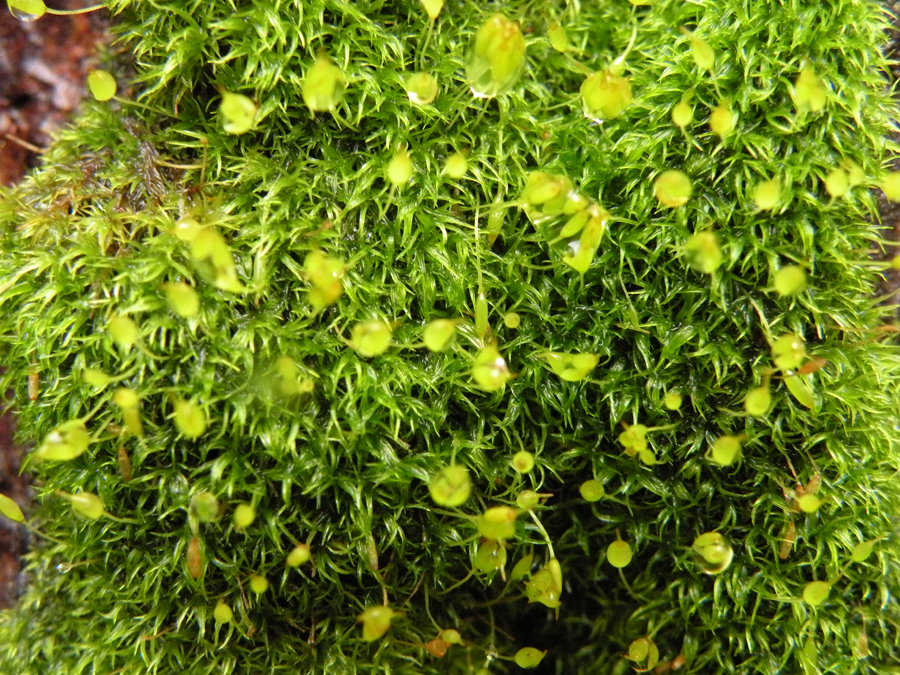
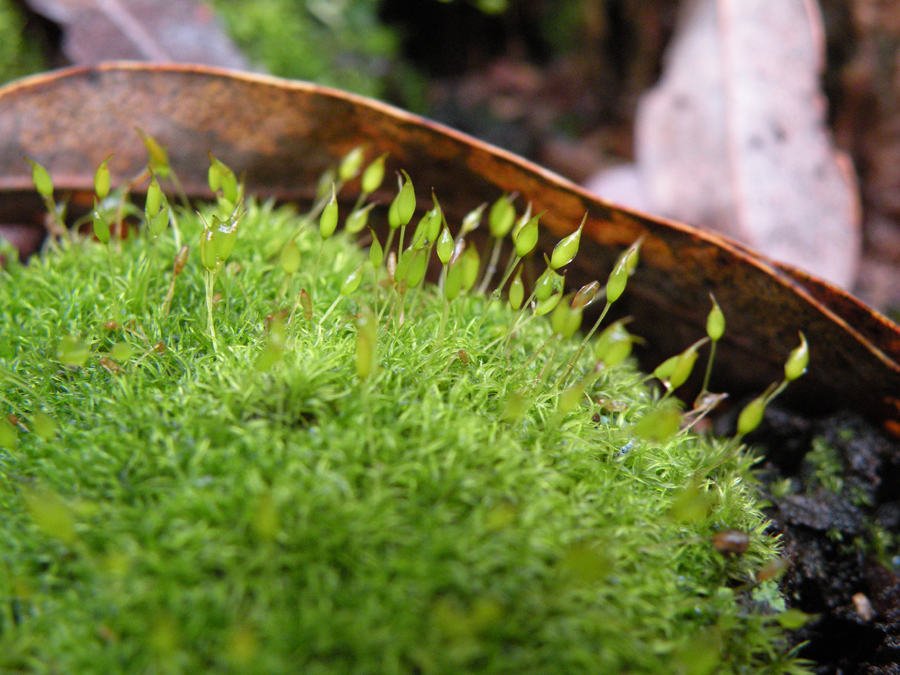
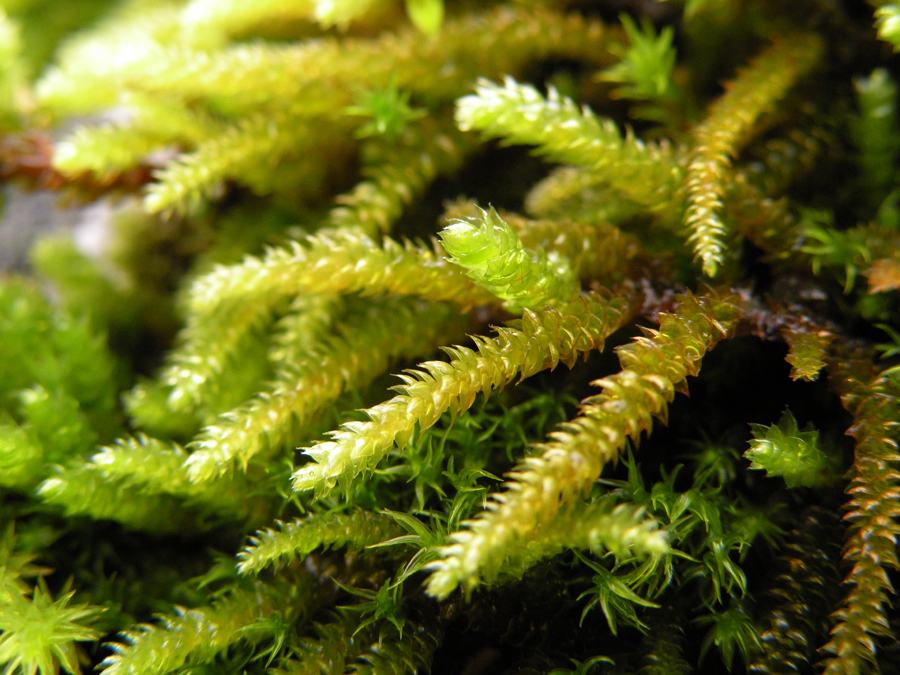
Photos by David L. Magney Venue: Library, Santa Barbara Botanic Garden, 1212 Mission Canyon Road, Santa Barbara, California.
|
Wednesday-Thursday |
4-5 November 2015 8:00 AM - 5 PM
Workshop |
Ventura County
Workshop on CEQA
|
Leader: David Magney. Mr. Magney, with the assistance of Daniel Klemann, Manager of the Residential Permits Section of the Ventura County Planning Division, Whitney Wilkinson, Planing Biologist for the ventura County Planning Division, and Linda Krop, Esq., Chief Legal Counsel for the Environmental Defense Center, taught a two-day workshop on the California Environmental Quality Act (CEQA). The focus was on preparing and critically reviewing the parts about how impacts to botanical resources are dealth with. Participants learned the basics about CEQA and how to prepare legally defensible CEQA documents, at least those parts dealing with biological resources, and how to find and correct inadequacies as well. This workshop was designed for the consulting biologist who prepares bio sections of CEQA documents and for those conservationists who want to learn how to effectively critisize them. There was a good mix of professions and interests of the participants, which lead to great exchanges of experiences and good discussions on the intricacies of CEQA and biological assessments, and the importance of public participation. Certificates of Completion were issued to those participants that passed the examination at the end of the workshop. Reviews of the workshop by the participants were all positive, with all wanting more. 
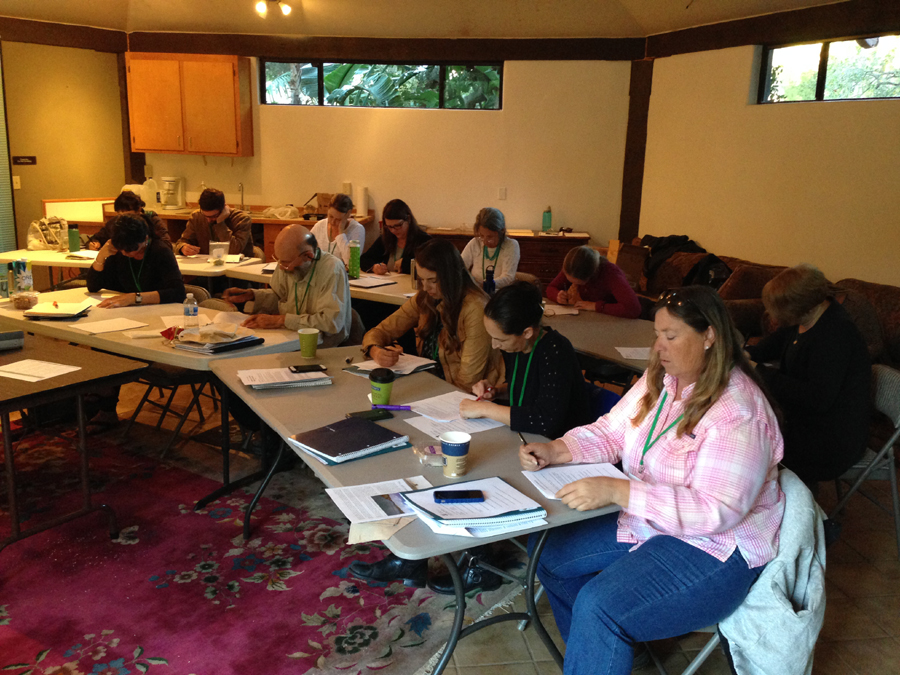 The workshop was held at the Center for Earth Concerns' Taft Gardens just outside of Ojai, California.
|
Tuesday |
13 October 2015 7:15 to 9:00 PM
Talk |
Ventura County
Native Plant Sections of the Ventura Botanical Gardens
|
Speaker: Joe Cahill. Learn about what the new Ventura Botanical Gardens (VBG) is planning for their native plant areas at Grant Park, Ventura. The botanic garden will feature many different plants from around the world, but will also highlight plants that are native to the Ventura County region. The VBG is a public-private partnership with the mission of building and maintaining a world-class botanic garden in Grant Park, Ventura. In early 2015, the Ventura City Council approved a 35-year master plan for the gardens. The greatest proportion of the 107-acre site will be devoted to native California plants. Mr. Cahill will briefly present the history of garden site, design process, recent progress, and plans for phase I over the next five years. VBG has current and future volunteer needs that connect to California native plants. Come and hear what they are thinking and provide them with feedback as well. Bring your unknown native plants to ID before the talk. Venue: Topping Room, E.P. Foster Library, 651 E. Main Street, Ventura, California.
|
Thursday |
17 September 2015 7:15 to 9:00 PM
Talk |
Santa Barbara County
Creating a Beautiful Native Garden
|
Speaker: Paige Minney and Stephanie . Paige and Stephanie, of Willow and Sage Native Landscaping, speak on how to use native plants to create a beautiful garden. They presented three projects they have worked on recently as examples of how to approach figuring out how to landscape yards under different conditions. Venue: Library, Santa Barbara Botanic Garden, 1212 Mission Canyon Road, Santa Barbara, California.
|
Wednesday |
19 August 2015 7:15 to 9:00 PM
Talk |
Ventura County
Botanist Certification Program
|
Speaker: David Magney. David, chairman of the CNPS Botanist Certification Program Committee, told a group of about 20 people about the whys and hows of the new program through CNPS to determine who can call themselves a Certified Botanist in California. The Committee has descided to have two levels of certification, one for field botanists, and one for consulting botanists. The Certified Consulting Botanist will need to know everything the Certified Field Botanist must know. Magney described how the need for this new program came about and the purpose and goals of certifying botanists. Everyone in attendance thought this was a good idea. Venue: Topping Room, E.P. Foster Library, 651 E. Main Street, Ventura, California.
|
Thursday |
16 July 2015 7:15 to 9:00 PM
Talk |
Santa Barbara County
Manzanitas
|
Speaker: Jeff Bisbee. Jeff is sometimes referred to as "Manzanita Man". Needless to say, he knows a lot about the genus Arctostaphylos and shared some of that knowledge with those who attended. Venue: Santa Barbara Botanic Garden, Library, 1212 Mission Canyon Road, Santa Barbara, California.
|
Saturday |
25 July 2015 9:00 AM to 1:00 PM or so
Walk |
Ventura County
Exploratory Walk at South Ormond Beach
|
Leader: Andrea Adams-Morden. Andrea led an easy stroll around The Nature Conservancy's property at South Ormond Beach, which is part of the coastal lagoon/saltmarsh complex that once was quite extensive from Mugu Lagoon up the coast to Pierpont Beach in Ventura. Most of this habitat has been lost to urban and agricultural development. There are some very interesting plants at Ormond Beach, including rare and endangered species. A checklist of all the plants known to occur at Ormond Beach has bee compiled by David Magney and is available on the Plant Checklists page. 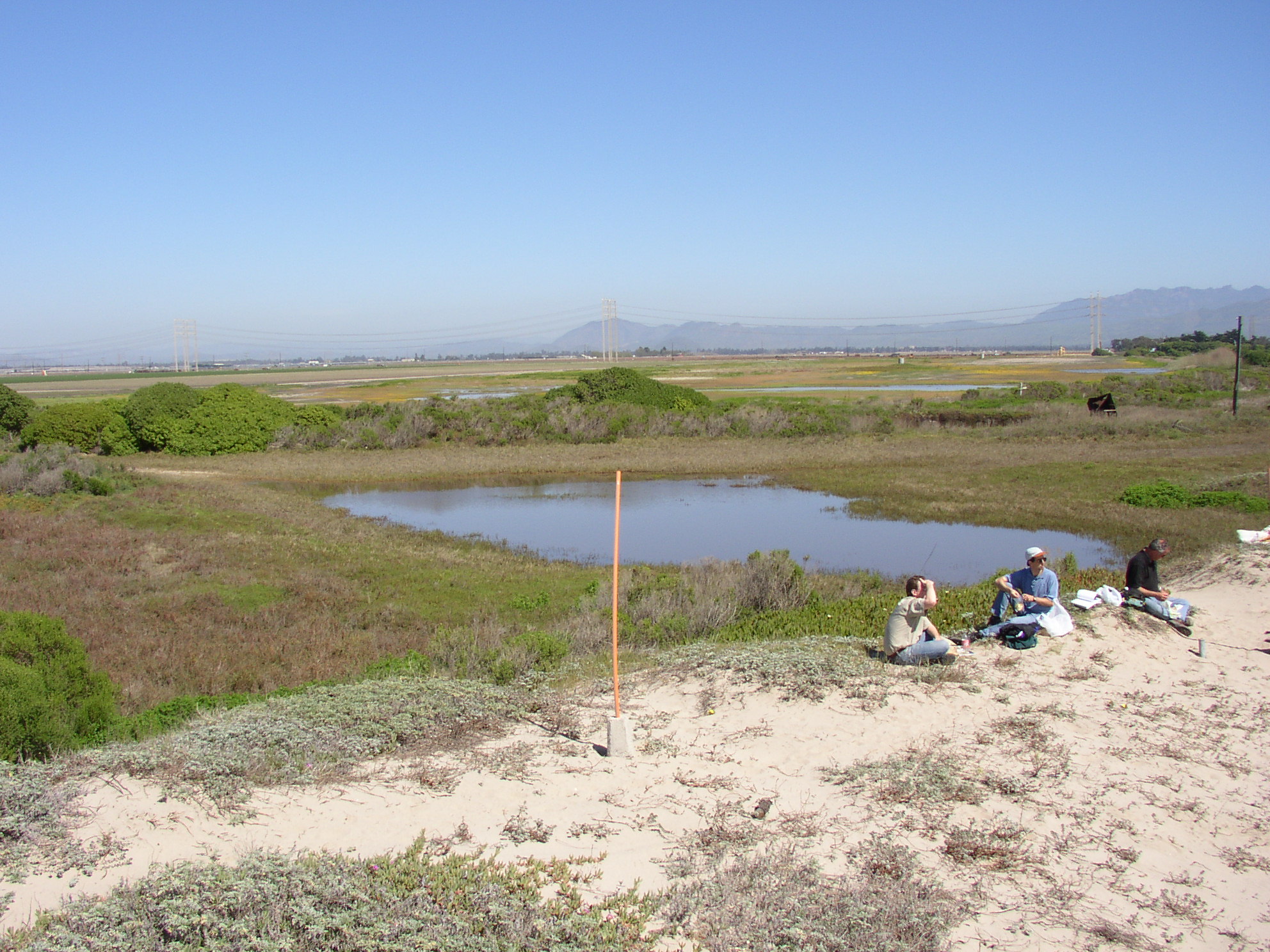
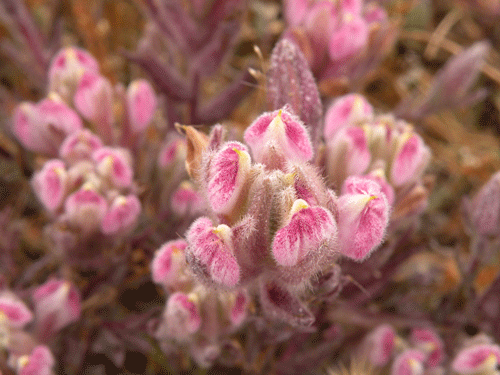
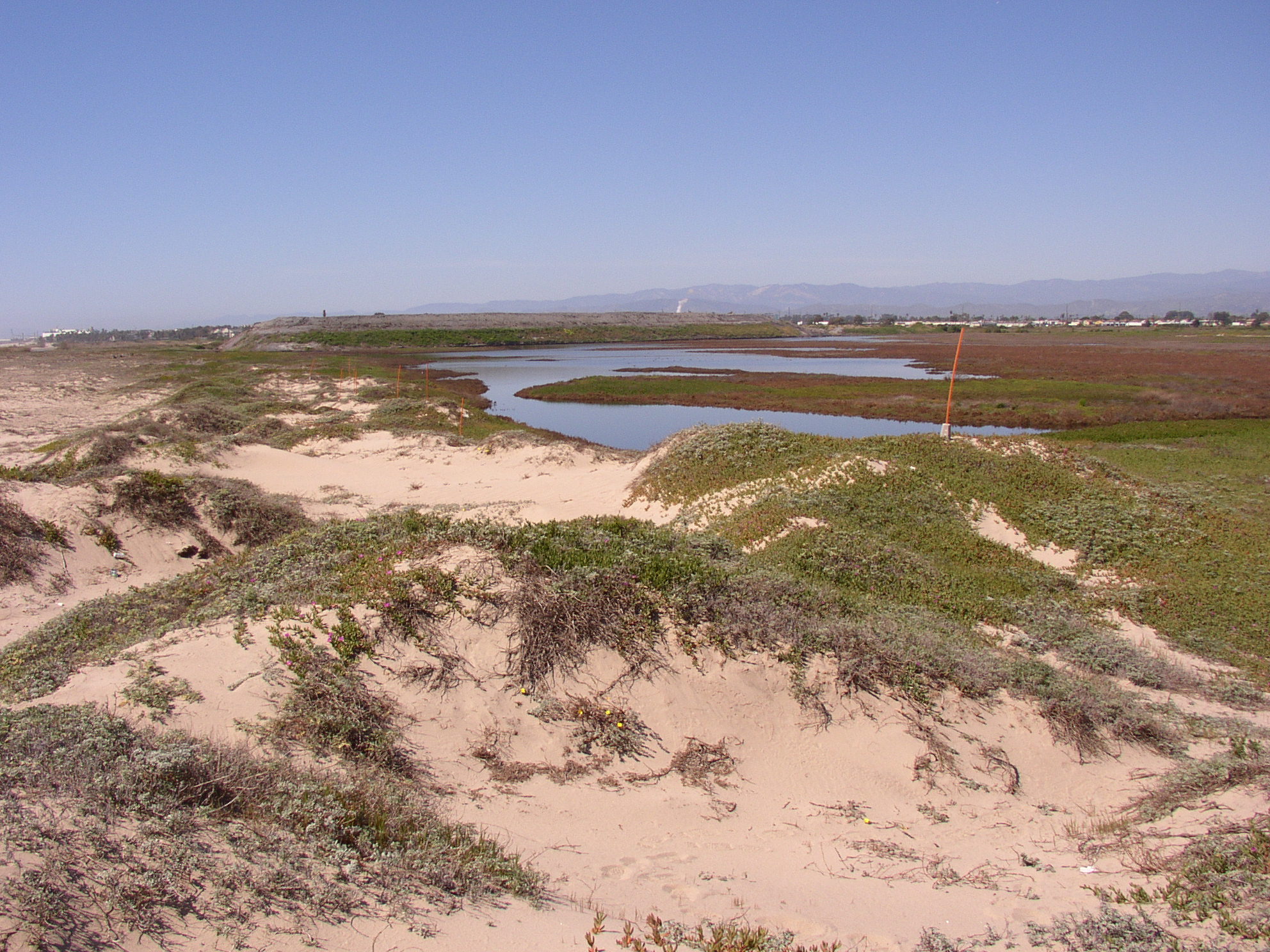
Photos by David L. Magney
|
Saturday and Sunday |
27-28 June 2015 8:00 AM to 8:30 PM
Rare Plant Hunt |
Ventura County
Backpack Trip to Find Clinopodium mimuloides and Acanthoscyphus parishii var. abramsii on top of the Topatopa Mountains
|
Leader: David Magney. Seven people joined David and CNPS for a rare plant treasure hunt backpacking trip to the top of the Topatopa Mountains in the Los Padres National Forest, in the heart of Ventura County. We looked for two plants (Clinopodium mimuloides and Acanthoscyphus parishii var. abramsii), which had not been observed in this area for nearly, or over 100 years, and it is time to see if we can find them again and record their conditions. We rediscovered i>Acanthoscyphus parishii var. abramsii at its Type Locality (location from which it was formally described as a species) on saddle between Timber Canyon Creek and Santa Paula Canyon watersheds at the north foot of Hines Peak, the highest peak of the Topatopa Mountains. We didn't find Clinopodium mimuloides. Access ws restricted to the trailhead, at the east end of the Nordhoff Ridge Forest Service Road, which can only be driven by four-wheel-drive vehicles, by permission only from the Los Padres National Forest. Since it takes a while just to drive to the trailhead, and the trail on the top of the mountains is long, we drove two 4WD vehicles to the trailhead, each to capacity with people and backpacks. This was a fairly strenuous hike (carrying a backpack for wilderness camping certainly makes hiking more strenuous), and mostly above 5,000 feet in elevation. We camped at Ladybug Camp, which was nicely shaded by tall Bigcone Spruce (Pseudotsuga macrocarpa), Canyon Live Oak (Quercus chrysolepsis), and California Bay (Umbellularia californica). We brought lots of water but obtained more from a trickle in Timber Creek that is fed by a spring. There were many plants in bloom, and others that were in fruit, such as Eastwood Manzanita, which some of us enjoyed eating. We backpacked for 6 miles, three miles in, three miles out, but a few of us hiked further down the Red Reef Trail below Ladybug Camp. We saw well over a hundred different plants. You can download a checklist complied by David Magney of all the plants known to occur on the Topatopa Mountains from the Plant Checklists page. 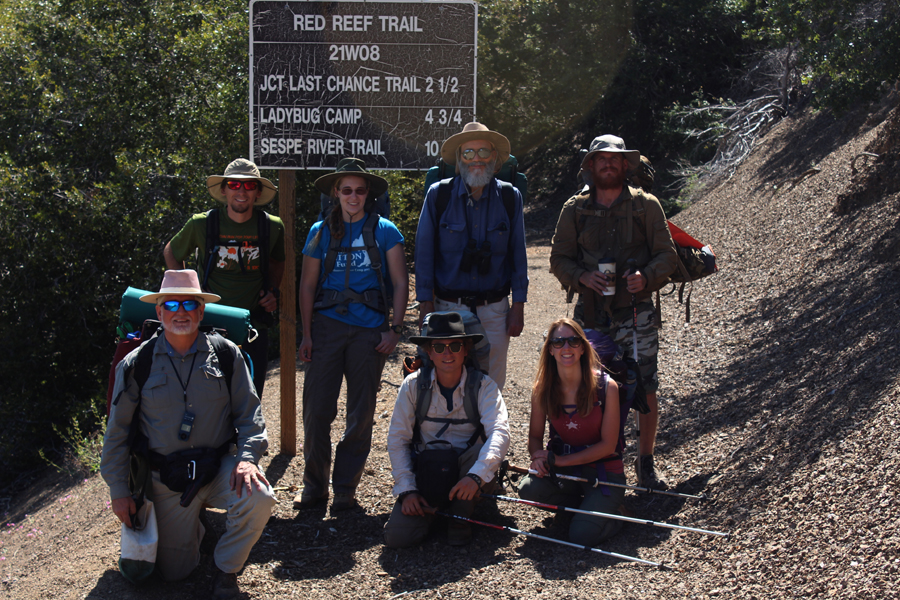

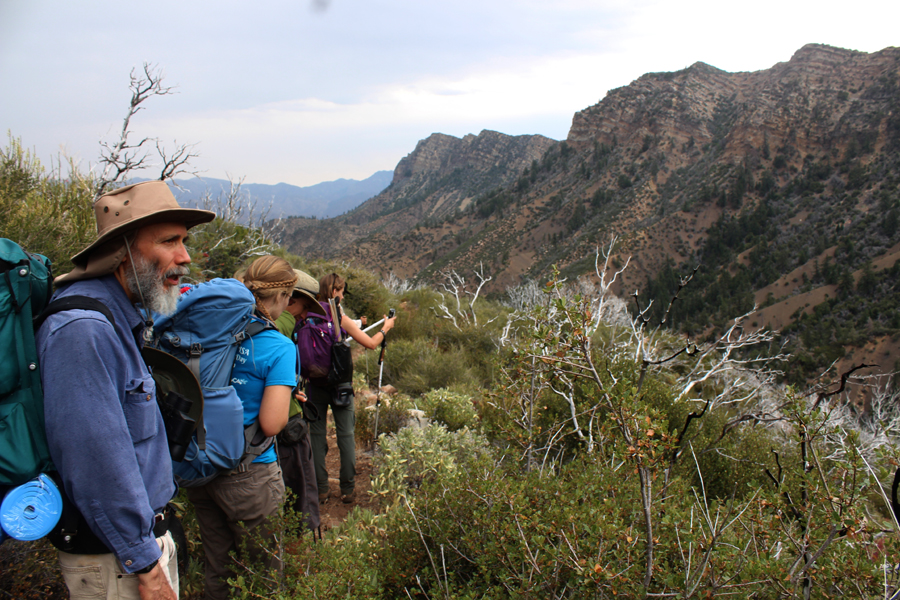
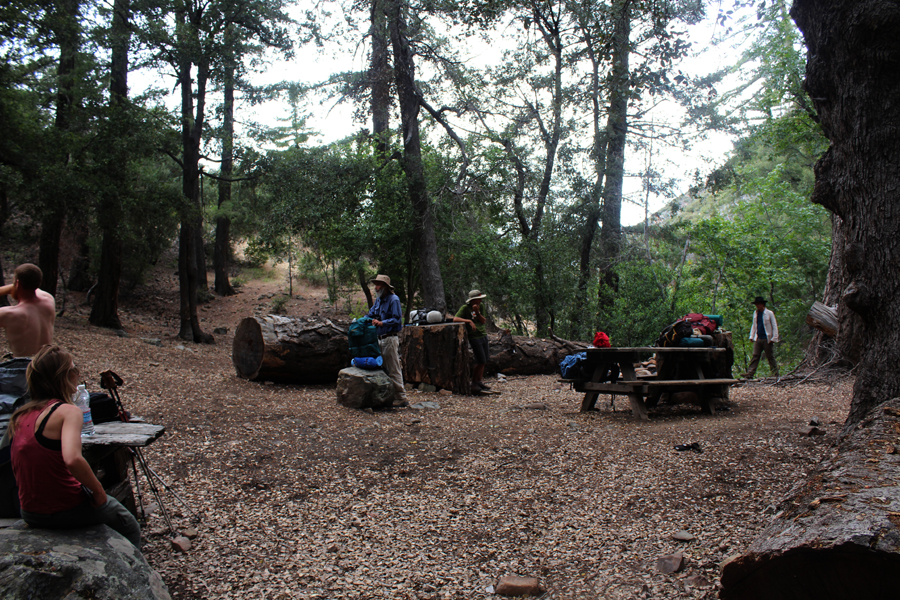
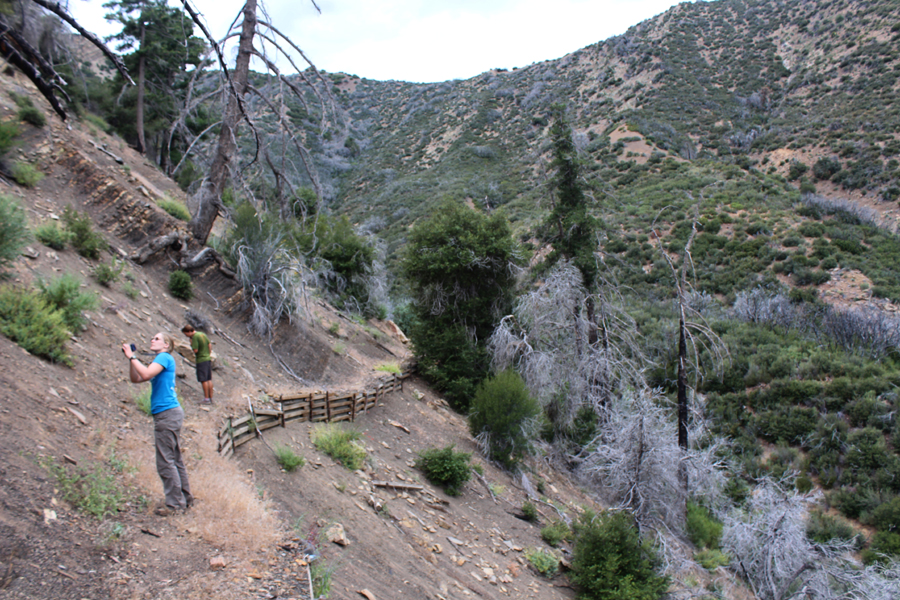
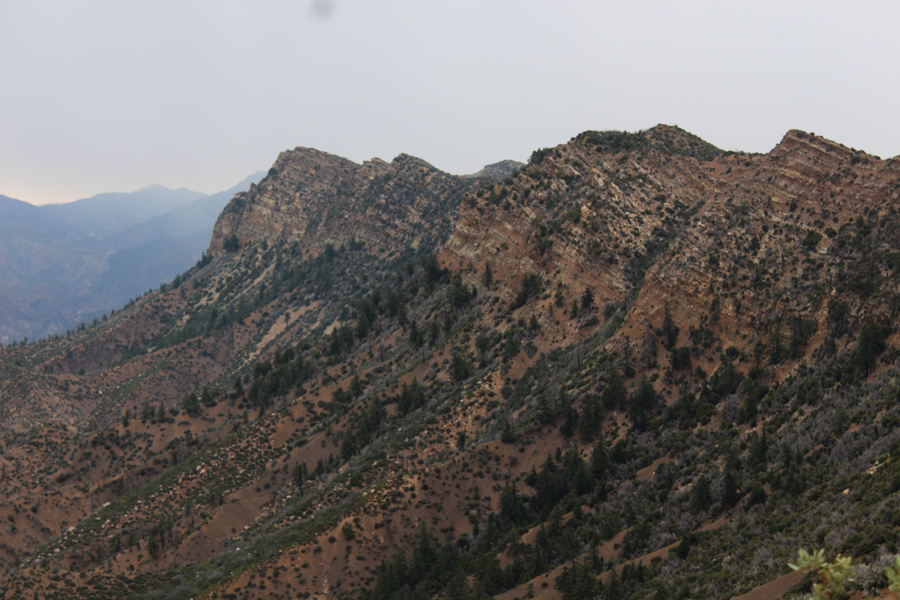
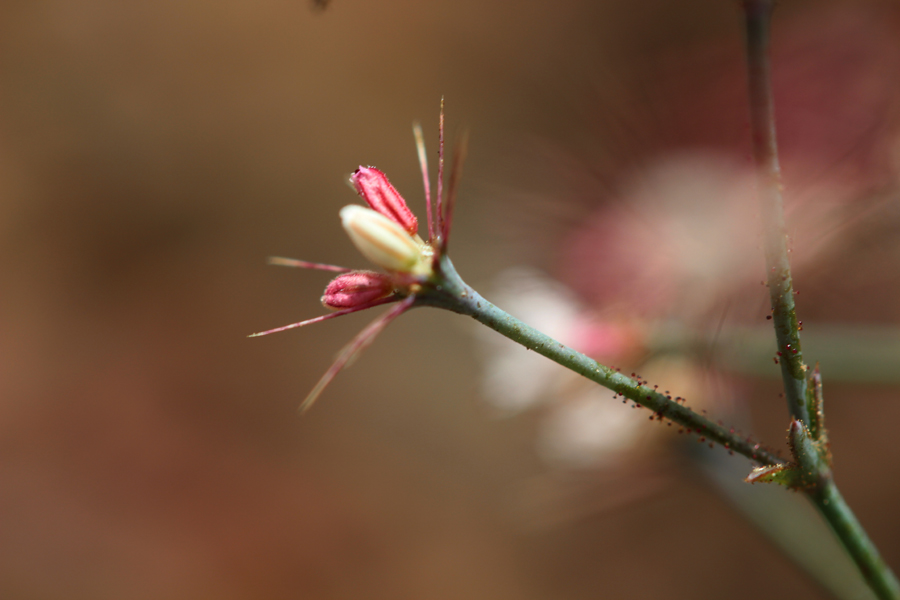
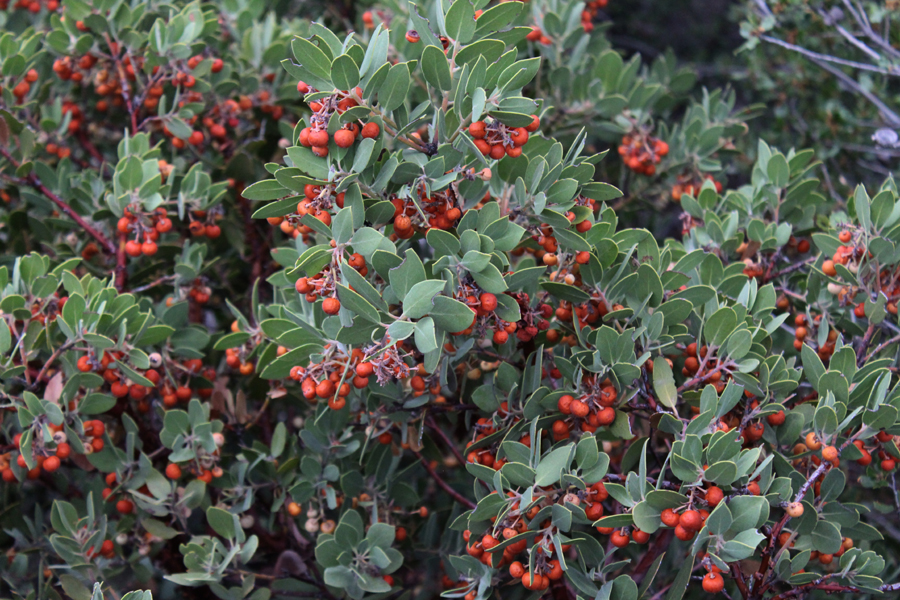
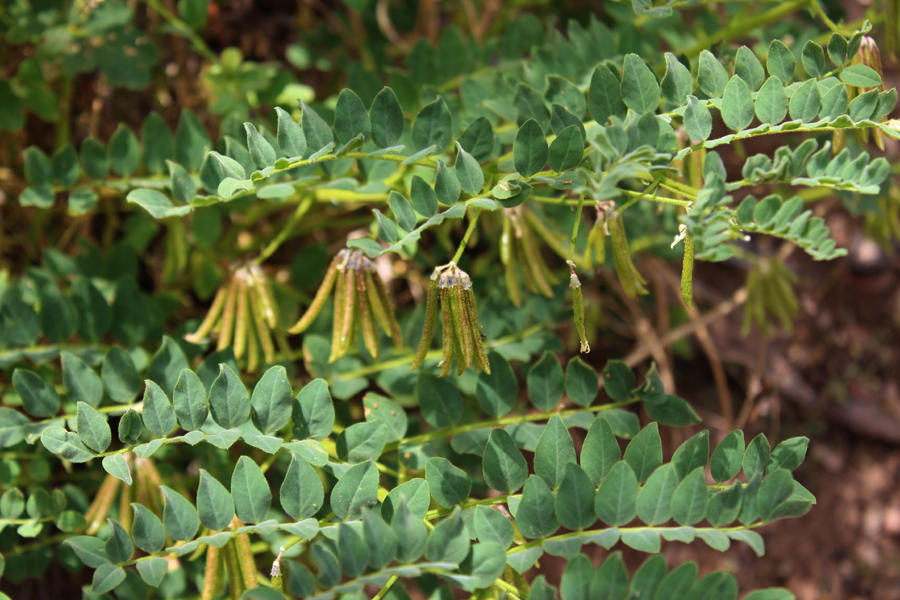
Photos by David L. Magney
|
|
Friday |
19 June 2015 1:00 to 2:00 PM
Talk/Meeting |
Santa Barbara County
New Phylogenetic Approaches to Biodiversity Assessment and Conservation
|
Speaker: Brent Mishler, PhD, Director of the Jepson Herbarium at UC Berkeley. Biodiversity is usually measured by examining changes in the number of species across a region to identify areas of particularly high species diversity and endemism. Beta-diversity, or turn-over on the landscape, is likewise usually measured by comparing proportions of species shared among subareas. However, investigations based on species distributions alone miss the full richness of analyses that can result from taking a phylogenetic approach. Our research group is applying a novel suite of phylogenetic tools including two new metrics, Relative Phylogenetic Diversity and Relative Phylogenetic Endemism, and new methods called Categorical Analysis of Neo- And Paleo-Endemism (CANAPE), Range Weighted Branch Length Difference (RWiBaLD), and phylogenetic range-weighted turnover (PhyloRWT). CANAPE and RWiBaLD are tested statistically with the same spatial randomization of terminal taxa on the map. These methods are rank-free since it does not matter what taxonomic levels the terminals represent, as long as they are monophyletic and their geographic distribution can be characterized, and are thus relatively robust to lumping and splitting decisions by taxonomists. Understanding such evolutionary patterns of biodiversity on the landscape is important for conservation planning, given the need to prioritize efforts in the face of rapid habitat loss and human-induced climate change. These new phylogenetic methods can identify complementary areas of biodiversity that have unique evolutionary histories in need of conservation. The Santa Barbara Botanic Garden and CNPS will be working with Brent in the future to apply this technique to the Channel Islands as we begin work on a unified Channel Island flora in the next year or 2, and we thought that you might be interested in hearing about it as well. This is a very interesting volunteer opportunity for CNPS members who are interested in the flora of the Channel Islands. Please contact Matt Guillliams (mguilliams@sbbg.org) if you are interested in helping with this project.
|
Sunday |
14 June 2015 12:00 Noon - 4:00 PM
Gathering |
50th Anniversary Chapter Picnic Toro Canyon Park, Summerland
Half Century Celebration Potluck Picnic
|
Chapter Membership Gathering. A group of members came to this beautiful, oak tree-shaded park to enjoy a celebration of CNPS's 50th year as a conservation organization. The chapter hosted a picnic for the members to celebrate what CNPS is about by breaking bread together in a family style old fashioned picnic in the park. There was a shady area for eating. There was play equipment nearby for kids and rocks to climb. There was a short trail through some nice chaparral for anyone who would like to do some botanizing. There were even bryophytes. 
Photo by David L. Magney
|
Sunday |
7 June 2015 12:30 PM - 5:00 PM
Hike |
Sisar Canyon Trail Upper Ojai, California
Botany, Bird, and Butterfly Hike
|
Leaders: Saudamini Sindhar and David Torfeh. A nice group of people enjoyed the beautiful, tree-shaded, upper Sisar Canyon and a number of plants in bloom. Plenty of water was flowing in the creek, wildflowers were blooming in large numbers, and birds were singing. Elevation gain will only be about 500 feet (from about 2,000 feet to roughly 2,500 feet above mean sea level) and the climb is gradual. There were many stops to view and learn the vascular plants of Sisar Canyon. The local birds and butterflies were also identified. This canyon is at the base of the Topatopa Mountains (Topatopa Bluffs). David Magney has developed a preliminary checklist of the plants along the Sisar Creek Trail that can be downloaded from the Plant Checklists webpage. See if you can add to the list. 


Photos by David L. Magney Directions: (1) From Ventura, take Hwy. 126 east to 10th St. (Hwy. 150) in Santa Paula. Turn left and continue north through Santa Paula, veering right when the road splits. Stay on Hwy. 150 until you see Topa Ln. on the right. Park on Topa Ln. and meet in the parking lot of the small market just west of it. (2) From Ojai, take Hwy. 150 east. Just past Sisar Road on the left, you will see Topa Ln. Park there and walk back to the small market’s parking lot to meet. (3) From Santa Barbara, go east on the 101 Frwy. to Ventura, then follow the “From Ventura…” directions. Alternate routes from Santa Barbara are: (a) 101 Frwy. east to Hwy 150 (starts in Carpinteria) through Ojai or (b) 101 Frwy. east to Hwy 33, then north on Hwy. 33, then right on Hwy. 150 through Ojai. (4) From Fillmore and points east, take Hwy. 126 west to Santa Paula, exit at 10th St. (Hwy. 150), turn right, then follow the directions given for coming from Ventura, starting with “and continue north through Santa Paula…”.
|
Wednesday |
3 June 2015 7:15 to 9:00 PM
Talk |
Ventura County
Flora of Bitter Creek National Wildlife Refuge
|
Speaker: David Magney. A nice group learned about the flora of the U.S. Fish and Wildlife Service's Bitter Creek National Wildlife Refuge (NWR) as a result of the team of botanists David has lead for the USFWS during the winter and spring of 2015 to search for rare and endangered plants, as well as documenting the entire vascular plant flora of the refuge. The Bitter Creek NWR is part of the Hopper Mountain refuge complex for the California Condor with the Bitter Creek NWR located at the western end of the San Emigdio Range in the southwestern corner of Kern County, and a tiny bit in northwestern Ventura County. The Bitter Creek NWR is mostly of grassland habitat, with a number of small seeps and springs, steep canyon slopes with oak and chenopod scrub, and badlands topography dominated by Pinyon-Juniper Woodlands. Even though rainfall for this year is only half of "normal", the annual flora responded very nicely with decent blooms, where almost nothing germinated last year. 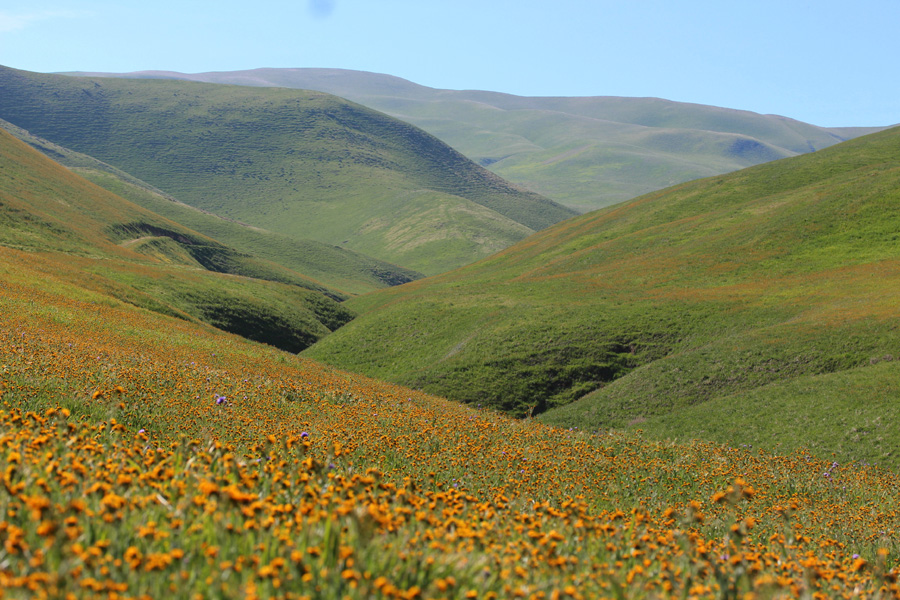
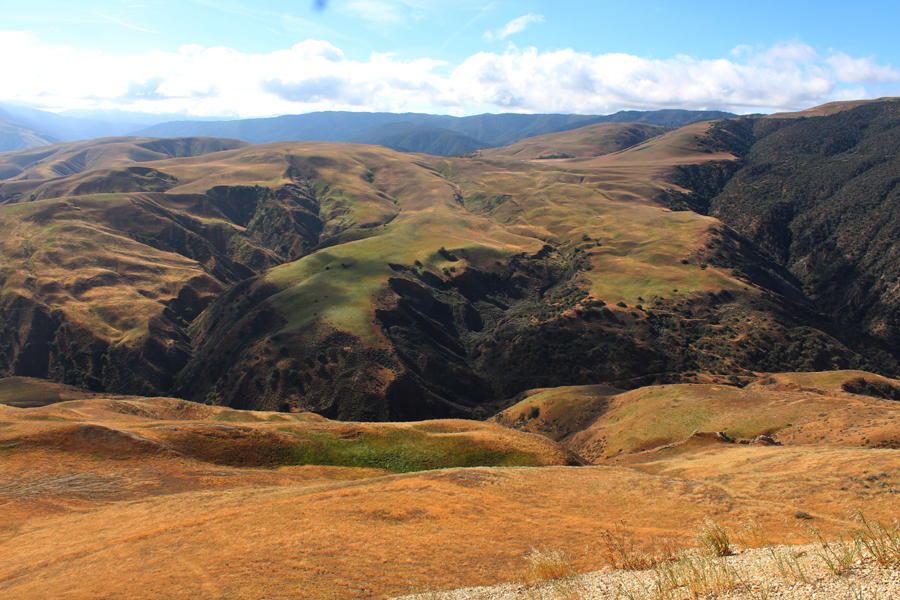
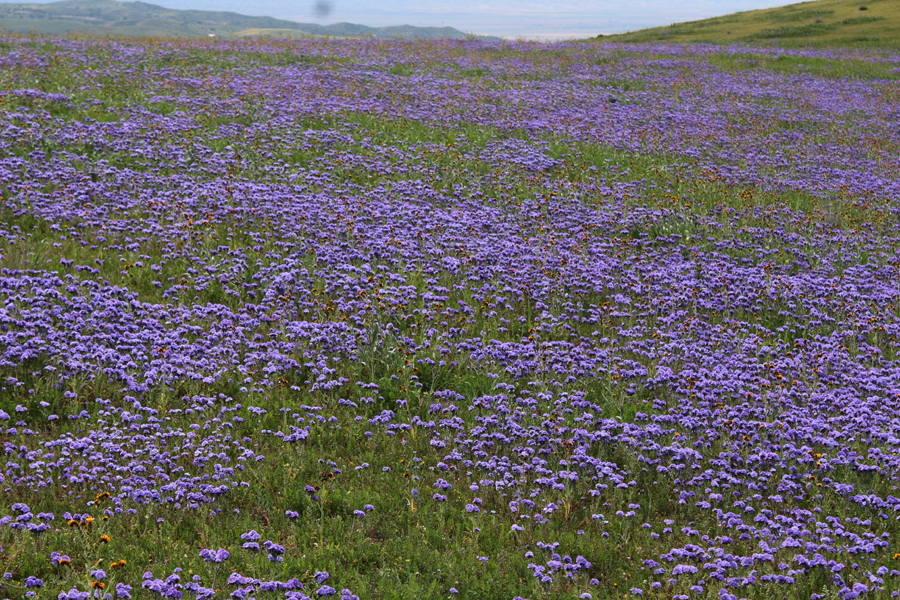
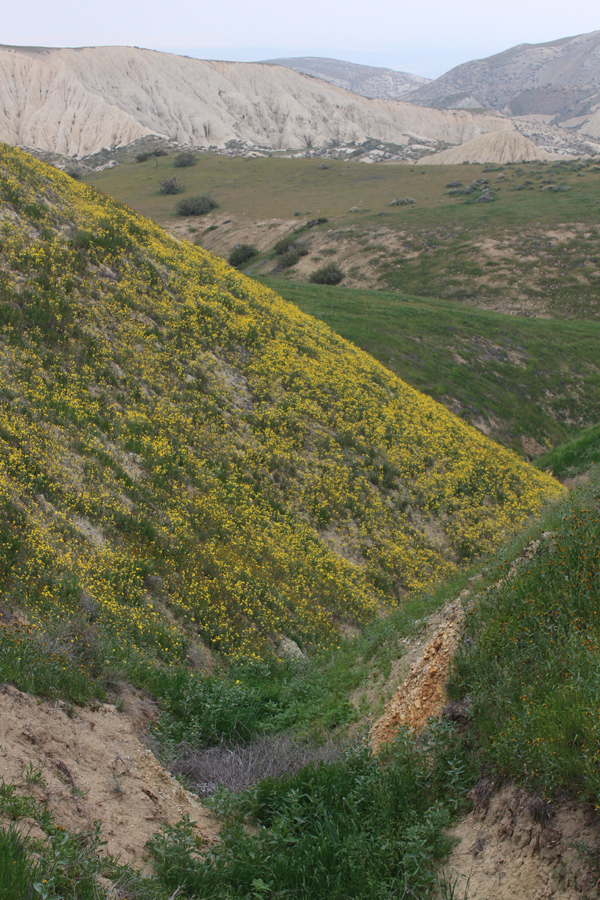
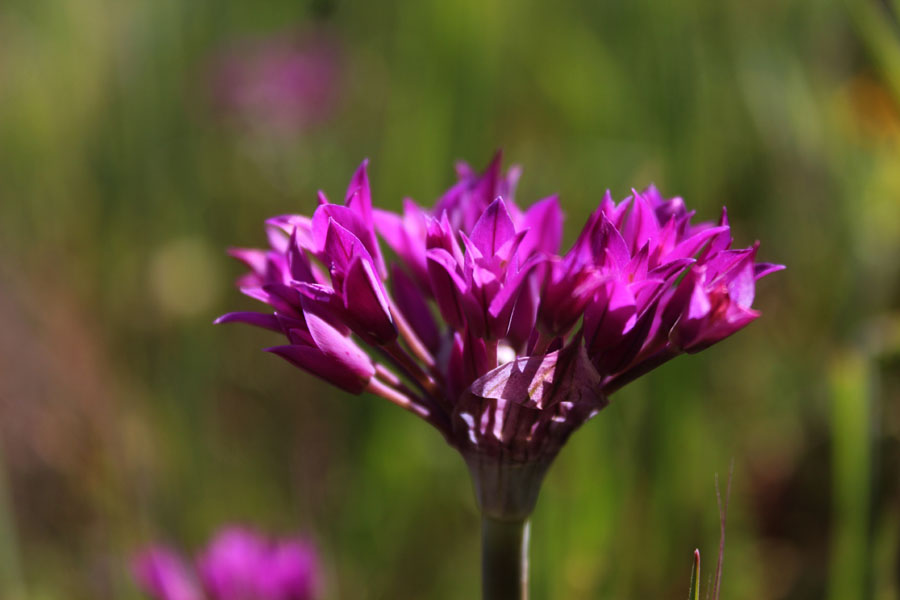
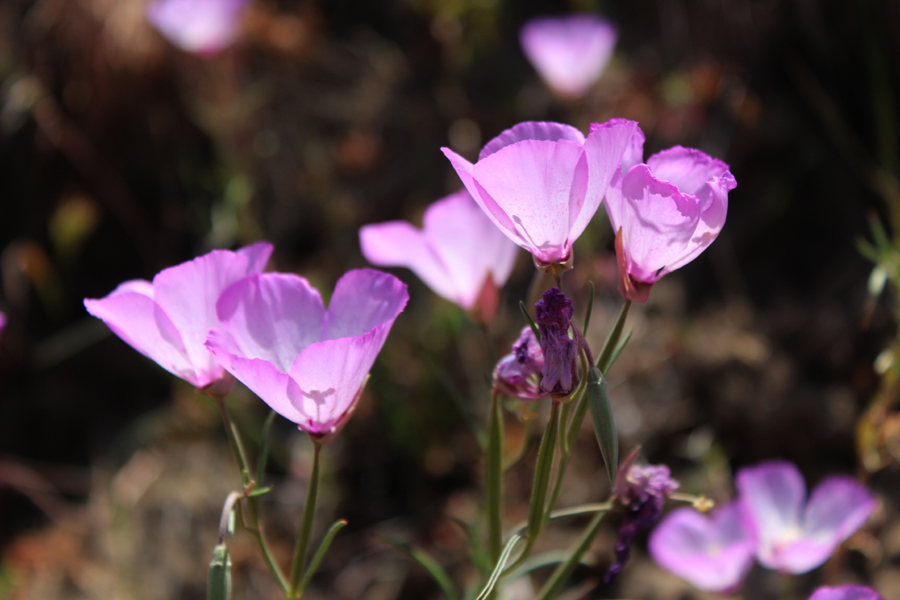 Photos by David Magney from 2015
|
Thursday |
21 May 2015 7:15 to 9:00 PM
Talk |
Santa Barbara County
Baja Vernal Pools
|
Speaker: Matt Guilliams. Matt told us all about the vernal pool habitats of Baja California Norte, which he has been researching over the last few years. There are some species found only in the Baja California vernal pools, and much of the vernal pool habitat has been lost to urban and agricultureal development. The talk was very interesting and well attended.
|
Sunday |
17 May 2015 12:30 PM - 4:30 PM
Hike |
Cozy Dell Trail Ojai, California
Botany, Bird, and Butterfly Hike
|
Leader: David Torfeh. A dozen people had a great time hiking up and down Sheldon Canyon along the Cozy Dell Trail in the Ojai Front Country, just south of the Los Padres National Forest boundary. This will not be a strenuous hike because there will be many stops to view the profusion of plants still (surprisingly) in bloom. However, there will be moderate elevation gain. The majority of wildflowers in most lowland areas of Ventura County have dried up, but the oak and chaparral shaded north-facing slopes of the Cozy Dell area have possibly delayed that. Attendees saw most of the plant species on Magney's checklist, plus ten other species, as well as two birds (and hearing another five species). The prize find was Navarretia ojaiensis at three different spots along the trail, representing new records for this rare annual plant. David Magney had developed a preliminary checklist of the plants along the Cozy Dell Trail that can be downloaded from the Plant Checklists webpage. Additional species where found during the hike, so Magney's list will be updated accordingly. 








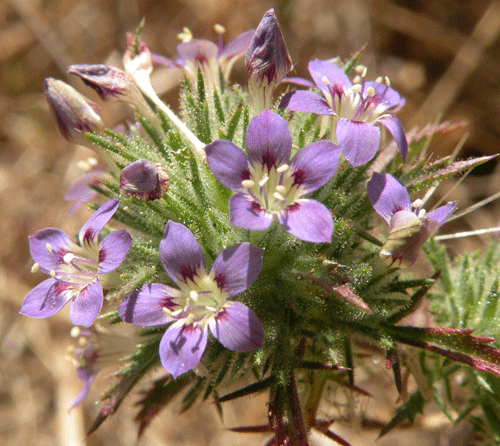
Photos by David L. Magney Directions: From Ventura, take Highway 33 north from the 101 Freeway. Meet at Ojai Rotary Park located just east of the signalized “Y” intersection in Ojai, on the right side of SR 150/Ojai Ave., at 12:15 p.m. to carpool. Otherwise, meet on the wide dirt turn-out (left side) on Hwy. 33 across the road from the Cozy Dell trailhead, by taking Hwy. 33 roughly 4 miles north from the “Y” in Ojai. If you get to the Friends Ranch citrus packing house, you’ve gone about 200 feet too far north. No Adventure Pass is needed because this is not in the National Forest. From Santa Barbara, take the 101 Frwy. to Hwy. 150 to Ojai (or all the way to Hwy. 33 in Ventura) then follow the directions above. From Simi Valley, Conejo Valley, or Camarillo, take the 101 Frwy. to Hwy 33 in Ventura, then follow the directions above.
|
Wednesday & Thursday |
6-7 May 2015 8:30 AM - 5:00 PM
Plant Families ID Workshop |
Center for Earth Concerns Ojai, California
Introduction to Native Plant Families Identification Workshop
|
The CNPS Education Program presented the second class/workshop focusing on identification of native plant familes, focusing on the 25 plant families that have the most representatives in the Southwest Region of California. The course was taught by local botanist David L. Magney, assisted by Joe Broberg, Saudamini Sindhar, and David Torfeh, focusing on plants native to Santa Barbara, Ventura, and western Los Angeles Counties. The workshop benefited those who wanted to learn some simple and clear features of the 25 plant families. The workshop covered terminology, physical characteristics, smells, feel, and looks of local representatives of the 25 plant families covered. There were many photographs shown, as well as walks in the planted gardens of the venue (it is a fabulous garden) and Mother Nature's garden on the property. Mother Nature even provided a thunder storm at the end to celebrate. Students who passed the written test received a certificate of completion. This workshop was held in the same location in 2014 and everyone was very pleased and satisfied with what they learned. 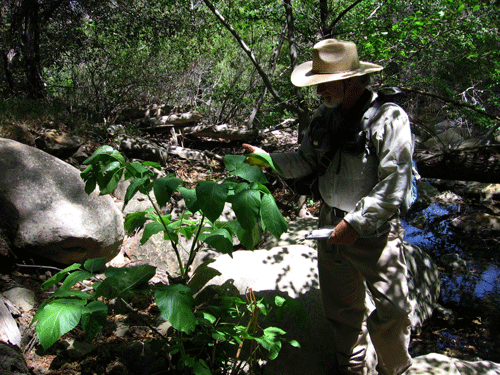
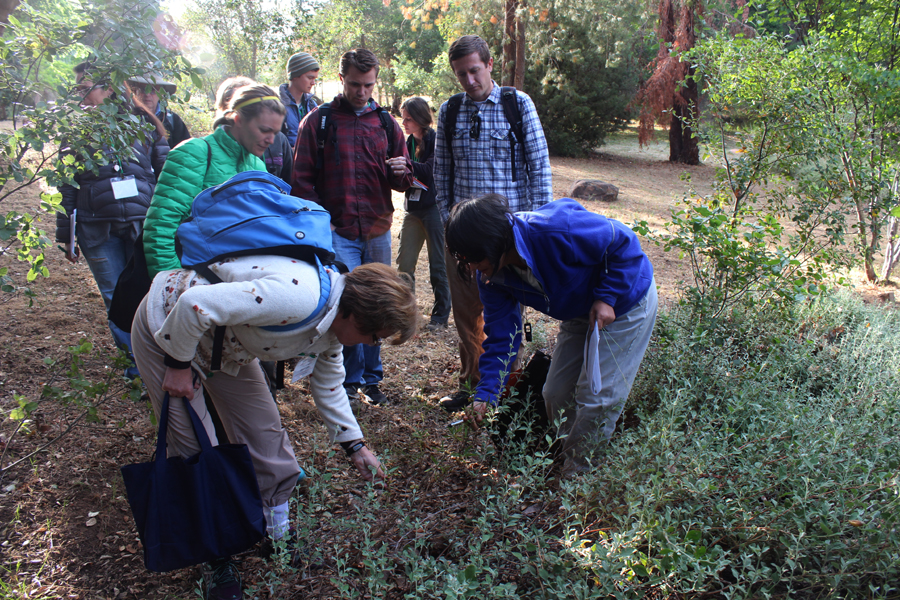
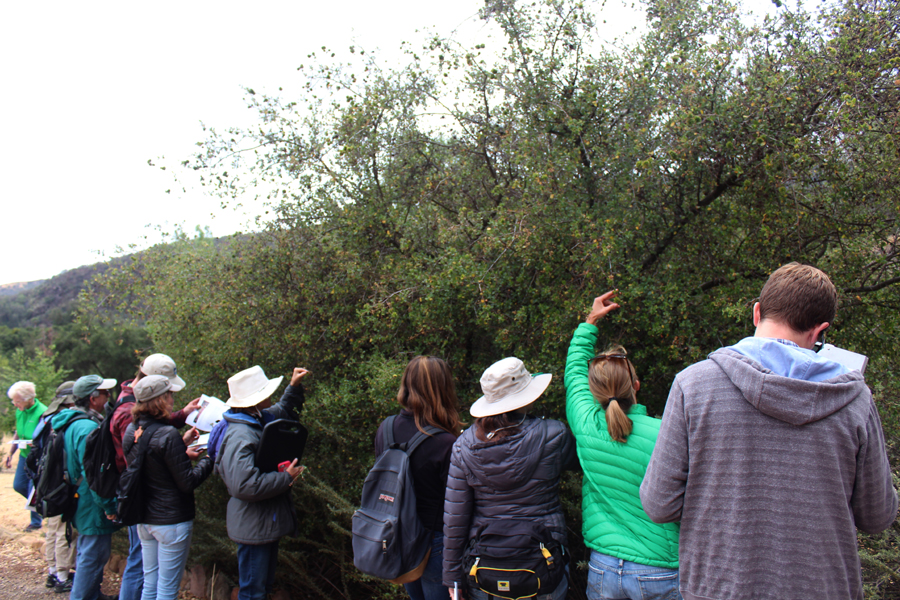 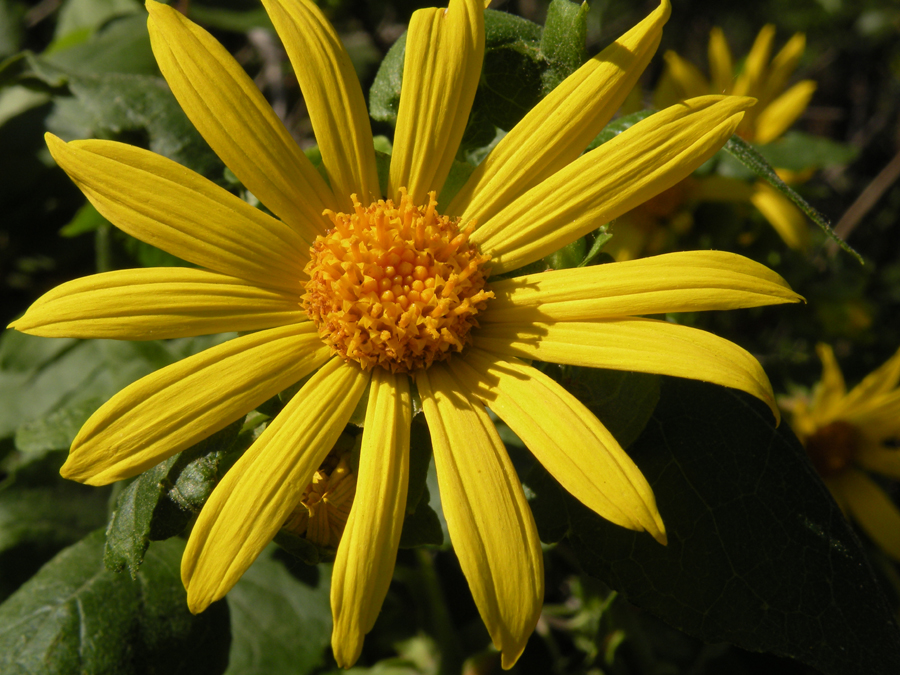
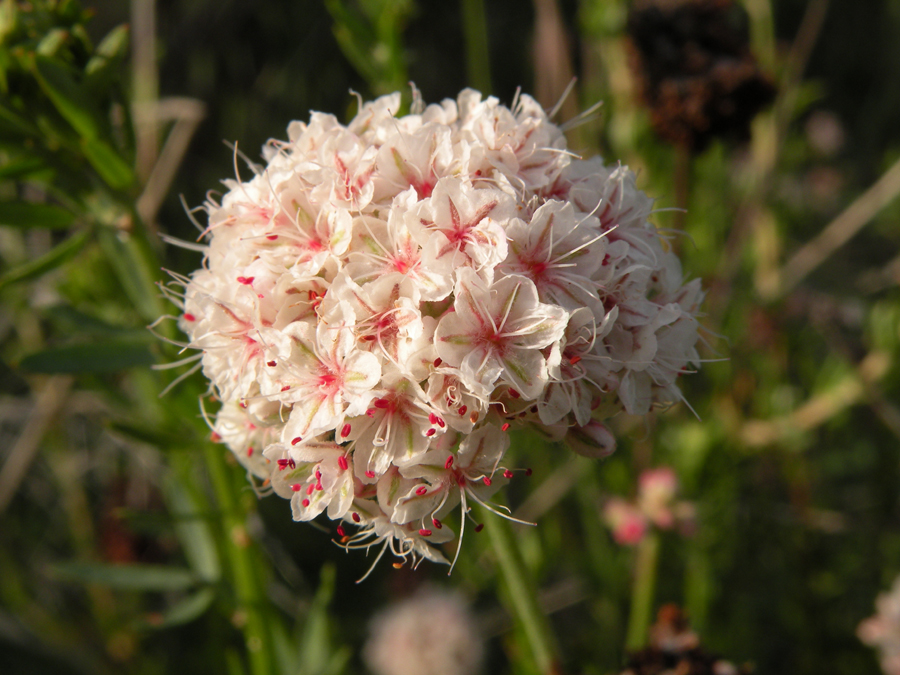
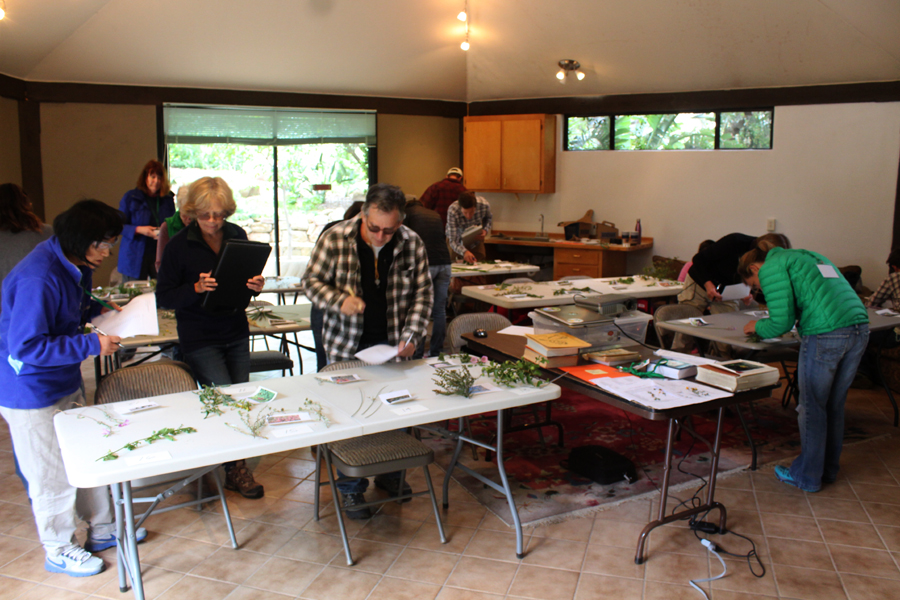 Cost: $310 for CNPS members, $345 for General Public/non-members (these are last year's prices and are subject to change). Registration open until first day; however, it is filling, so register now, there is still room. Print out the Introduction to Plant Families Identification workshop flyer.
|
Monday |
16 March 2015 7:15 to 9:00 PM
Talk/Slide Show |
Santa Barbara County
The Best Spring Wildflower Spots
|
Speaker: Spencer Westbrook. Spencer, an outstanding nature photographer, will shared his knowledge of where the best places to find spring wilflower spots in California. His talk and slide show was just in time for us to experience a great wildflower display in the spring of 2015 because of all the rain we will get (fingers crossed). Venue: Santa Barbara Botanic Garden, Library, 1212 Mission Canyon Road, Santa Barbara, California.
|
Saturday |
14 March 2015 9:00 AM to 1:30 PM
Nature Hike |
Ventura County
Nature Hike to Rancho Sierra Vista Satwiwa, Santa Monica Mountains National Recreation Area
|
Leader: David Torfeh. A nice group joined David and CNPS for this hike of easy to moderate difficulty through rolling grasslands, coastal sage scrub, chaparral-covered slopes, and riparian areas to look for fire-following annuals along with the regularly occurring flora. Directions: Ventura and Santa Barbara, take the 101 freeway east over the Conejo Grade to the Wendy Drive exit. Proceed straight (west) through the signalized Wendy intersection onto Old Conejo Road, paralleling the 101 freeway, until you get to Reino Road (signalized). Turn left on Reino Road. Continue south to Lynn Road, where you turn right. At Via Goleta, turn left and drive about 1/2 mile, to the largest parking lot, where we will meet at 9 a.m. If you are travelling from the Ojai area, take Hwy. 33 south to the 101 freeway and follow the directions above or below. Alternate route (scenic and curving): Take the 101 freeway east from Ventura to the Las Posas Road exit and turn right, driving about 4 miles. Turn left on Hueneme Road. Turn right on Potrero Road. Proceed about 5 miles to Via Goleta and turn right. Continue roughly 1/2 mile to a large parking lot.
|
Saturday |
14 February 2015 9:00 AM to 1:30 PM
Hike |
Ventura County
Sulphur Mountain Hike and Bird Walk
| Leader: David Torfeh and Saudamini Sindhar. David and Saudamini led a good-sized group on a gentle hike up Sulphur Moutain to see what has bloomed this winter after the "normal" rainfall so far. The participants experienced a pleasant hike on Valentine's Day and learned the plants and birds of Sulphur Mountain. David Magney has previously prepared a checklist of the plants found on this hike, which is available on the Plant Checklists page of this website. 




 Photos by David Magney from May 2011 Venue: Sulphur Mountain, west end, along Sulphur Mountain Road. Meet at the west end of Sulphur Mountain Road off State Route 33. No restrooms available (except behind that bush). Directions: From the 101 Freeway in Ventura, take Highway 33 north (toward the mountains). After roughly 6 miles on SR 33 (just after passing through the town of Casitas Springs), turn right on Sulphur Mountain Road, and park along the road near the Girl Scout Camp.
|
Saturday |
24 January 2015 9:00 AM to Noon
Hike |
Santa Barbara County
Franklin Canyon Hike
| Leader: Andrea Adams-Morden. Andrea lead a small group up the lower portion of the new Franklin Canyon Trail just north of Carpinteria. A total of 127 plant taxa were observed, with a good number in bloom. Most of the plants (70%) were native taxa, and one represents the first and only known occurrence of it in Santa Barbara County, Gamochaeta ustulata, Purple Cudweed, in the Asteraceae. For more information call Andrea at 684-8077. Venue: Franklin Canyon, private property and Los Padres National Forest. Meet at the end of Meadow View Lane in Carpinteria. Directions: From the north, leave U.S. 101 at Linden Avenue, then turn left and go to the third street on the left, which is next to the Church of the Later Day Saints, and park near the end. From the south (Ventura), exit at Casitas Pass Road, turn left to Ogan Lane, which is the second street on the left. Take Ogan until Linden Avenue then turn right and follow the previous instructions. We will meet at the end of Meadow View Lane in Carpinteria.
|
Thursday |
8 January 2015 7:15 to 9:00 PM
Talk |
Santa Barbara County
Ceanothus of the Channel Islands
|
Speaker: Dylan Burge, PhD. Dr. Burge is a leader in studying the genus Ceanothus, with many changes in our understanding of this iconic California shrub. He focused on those Ceanothus of the Channel Islands, but went into some detail about the distinctness of the two subgenera: Ceanothus and Cerastes, which he believes are distict enough to warrant elevation to full genus status. Those clear differences are evident in the leaves and leaf arrangement on the stems. The Cerastes "genus" includes those primarily with white flowers and thick leaves with only one main vein that are almost always arranged opposite on the stems. The Ceanothus "genus" includes those primarily with bluish flowers and thin leaves with three main veins that are almost always arranged alternately on the stems. The two groups also generally occupy different habitats, with the Cerastes species occuring on the drier, hotter, more exposed sites while the Ceanothus species occurring in more mesic situations. We had a great turnout, with all seats taken. Channel Islands Chapter Board met before the talk. 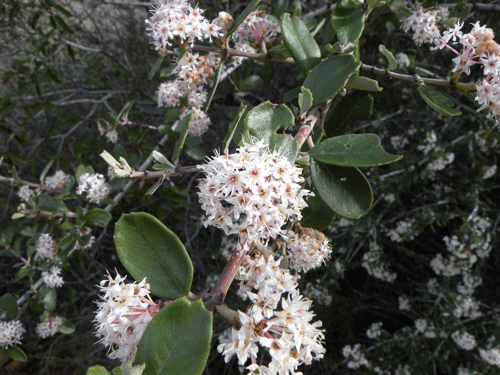
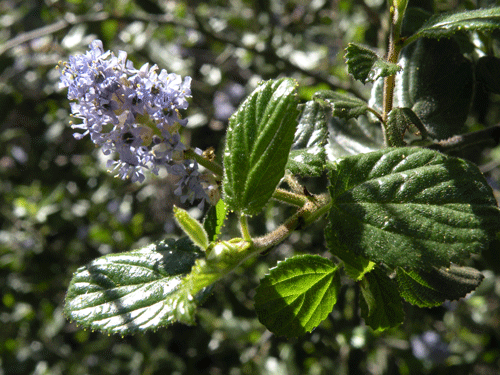
Left is a Cerastes example - Ceanothus crassifolius, right is a Ceanothus example - Ceanothus oliganthus. Photos by David L. Magney
|
Saturday |
20 December 2014 9:00 AM to 11:30 AM
Plant/Birk Hike |
Ventura County
Arroyo Verde Park
| Leader: David Torfeh. David lead a botany and bird hike in the Ventura Hills. Folks learned to identify the common plants and birds of the Ventura foothills. Eleven people, including the leader, David Torfeh, and two toddlers belonging to Heather, participated in the chapter’s Arroyo Verde Park Botany and Bird Hike on Saturday, December 20, 2014. Although it was a cloudy day, it did not rain. The weather was cool, affording a pleasant hike with many stops through the coastal sage scrub and chaparral habitats. The most interesting plants we spotted were the tall spikey native Artemisia dracunculus (Tarragon) – not flowering, the pale lavender-blossomed native Corethrogyne filaginifolia (Cudweed Aster) - flowering, both common native species of Solanum douglasii and S. xanti (both poisonous nightshades) -- flowering, and Epilobium canum (California Fuchsia) – flowering. Because it was December, most flowering plants were not blooming and many plants were dried up or had lost leaves, so we had the opportunity to practice some forensic botany. At least some plants were sparsely flowering. Participants learned which plants were edible and which were not. We either saw or heard many common bird species in the Park, including the California Thrasher (a Robin-sized brown bird with a large curved bill that sounds almost like a Northern Mockingbird), the raucous, clown-faced, medium-sized Acorn Woodpecker, the Northern Flicker (a large, mustachioed woodpecker), and the Wrentit ( a small, long-tailed brown bird with a bouncing ball-type call). We had striking views of the iridescent magenta facial feathers of at least one male Anna’s Hummingbird. Toward the end of the hike, the elaborate trilling calls of the Bewick’s Wren rang from the western hillside. Directions: From the 101 Freeway in Ventura, exit at Victoria Avenue and go north (toward the foothills). Turn left on Foothill Road, and right on Day Road at the entrance to the Park.
|
Thursday |
20 November 2014 7:15 to 9:00 PM
Talk |
Santa Barbara County
Phenology: How You Can Help the Study of Climate Change by Watching Plant Behavior
|
Speaker: Susan Mazar, PhD. Dr. Mazar is a leader in studying changes in plant phenology (when they bud, leaf out, bloom, set fruit, etc.) and using citizen scientists to provide most of the field observations. A select number of species are targeted for this monitoring, monitoring specific plants in the neighborhood, or even your back yard. Learn how to make the observations and contribute to science. Channel Islands Chapter Board met before the talk beginning at 6PM. Venue: Santa Barbara Botanic Garden, Library, 1212 Mission Canyon Road, Santa Barbara, California.
|
Saturday |
25 October 2014 9:30 AM to ~Noon
Plant Hike/Survey |
Ventura County
McGrath Lake/McGrath State Beach
| Leader: Wayne Ferren, Jr. Wayne lead a hike around McGrath Lake looking for rare wetland plants and documenting occurrences of both rare and invasive exotic plant species. A number of new plants were found, adding to our knowledge of the flora of McGrath State Beach.
|
Saturday |
27 September 2014 9:00 AM to 11:30 AM
Hike |
Santa Barbara County
Carpinteria Bluffs Botany Hike
| Leaders: Andrea Adams-Morden and David Torfeh, lead an easy hike along the bluffs and beach from Carpinteria Bluffs Nature Preserve to Rincon Point and back. Attendees learned about the local plants and birds from experienced naturalists Andrea Adams-Morden and David Torfeh. The Carpinteria Bluffs hike was attended by 14 people including the two hike co-leaders. The rare Suaeda taxifolia (Wooly Sea Blite) was found near seeps at the base of the bluffs between the seal rookery (next to the private pier) and Rincon Beach. It is a member of the Goosefoot family, Chenopodiaceae. A Merlin (an uncommon falcon) being harassed by American Crows was spotted sallying back and forth in a Eucalyptus grove on top of the bluffs north of the private pier. Although the weather became hot as we got near Rincon Beach and we hiked an extra hour, we enjoyed looking at the plants on the bluffs and the shorebirds as we walked on the beach.
|
Sunday |
21 September 2014 2:00 PM to 4:00 PM
Tour |
Santa Barbara County
Five California Native Gardens of Carpinteria
| Leader: Andrea Adams-Morden guided members to see five different gardens in Carpinteria that use California native plants, including looking at the use of native plants in three home gardens and two city parks.
|
Saturday |
20 September 2014 9:00 AM to Noon
Walk |
Santa Barbara County
Carpinteria Salt Marsh Nature Park Walk
| Leader Andrea Adams-Morden led CNPS members to look at six different plant communities in the Carpinteria Salt Marsh, as well as the Federally and State-endangered Salt Marsh Bird's Beak (Chloropyron maritimum) will be blooming. 

Photos by David L. Magney
|
Thursday |
18 September 2014 7:15 to 9:00 PM
Talk |
Santa Barbara County
Replacing Your Lawn with California Natives
|
Speaker: Kimberly True. Attendees learned how you can replace your water-hungry lawn with attactive California native plants at the Santa Barbara Botanic Garden. Channel Islands Chapter Board meeting preceeded the talk.
|
Saturday |
28 June 2014 9:00 AM to 1:30 PM
Hike |
Ventura County
Rose Valley Plant and Bird Hike
| Leader: David Torfeh. A small group of very interested participants braved high temperatures in Rose Valley north of Ojai for this non-strenuous botanical and bird hike. We carpooled in two vehicles from Ojai then were greeted by multitudes of California Treefrogs crossing the road at the Lower Lake after we parked. We spotted 80 taxa of plants in all, including about 15 in flower. We briefly explored the Upper Lake area (dry), then hiked past the Campground to Rose Valley Falls. Between the Campground and the falls, we heard the calls of Cassin’s Vireo (uncommon) and a Purple Finch. Later we had a great view of two Lawrence’s Goldfinches (uncommon). At the Falls, there was plenty of water, with Columbine and Boykinia blooming. Venue: Rose Valley, Los Padres National Forest. Meet at the parking area of Ojai Rotary Park or at the Lower Rose Lake in Rose Valley. Directions: From Ventura, take State Route 33 north from the 101 Frwy. Meet at Ojai Rotary Park located just east of the signalized Y intersection in Ojai, on the right side of SR 150/Ojai Ave. at 9:00 a.m. to carpool. Otherwise, meet at Rose Valley, by taking SR 33 about 15 miles north from the Y in Ojai, turning right on Rose Valley Rd., going 3.1 miles, and turning left to the Lower Lake. We will park in the Lower Lake parking area on the west side of the Lower Lake. No Adventure Pass is needed at the Lower Lake because there are no recreational facilities there. From Santa Barbara, take the 101 Frwy to SR 150 to Ojai (or all the way to the SR 33 in Ventura) then follow the directions above.
|
Saturday |
3 May 2014 9:00 AM to 4:00 PM
Hard Hike |
Ventura County
Dry Lakes Ridge Botanical Area Native Plant Hike
| Leader: David Magney. Over a dozen hikers joined David on an difficult but rewarding hike up to the top of Dry Lakes Ridge, which is a U.S. Forest Service Botanical Area. We explored this nearly 5,000-foot-high mountain in the middle of northern Ventura County with the author of the Flora of Dry Lakes Ridge. There are four large depression ("lakes") on the very top, which contain a relictual stand of Ponderosa Pine, left behind from the Pleistocene. A good number of plants were blooming, and we saw lots of evidence of the resident Black Bear. We actually found a few plants that had not previously been documented on the ridge top before. Bring your camera, water, lunch, sturdy hiking boots/shoes, and hat, and you never know, it may be cold, so bring warm cloths, or it could be hot (most likely), we just can't tell anymore. The first (and last) part of the hike goes straight up(down) an old fire break, which serves as the only trail to the top. We will go up, very slowly, to the spine of the ridge, then hike up the spine (easy walking) through Eastwood Manzanita Chaparral until we reach the easternmost "dry lake" where we will find the Ponderosa Pines and Great Basin Sagebrush. RSVP to David at david@magney.org or 805/646-6045. 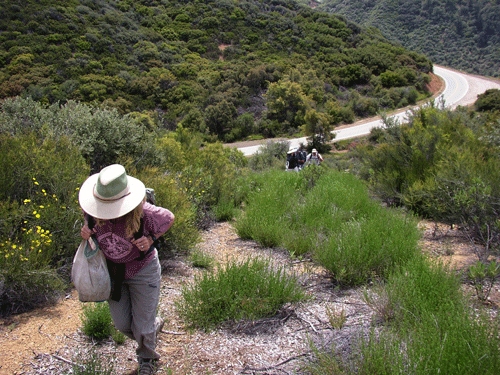
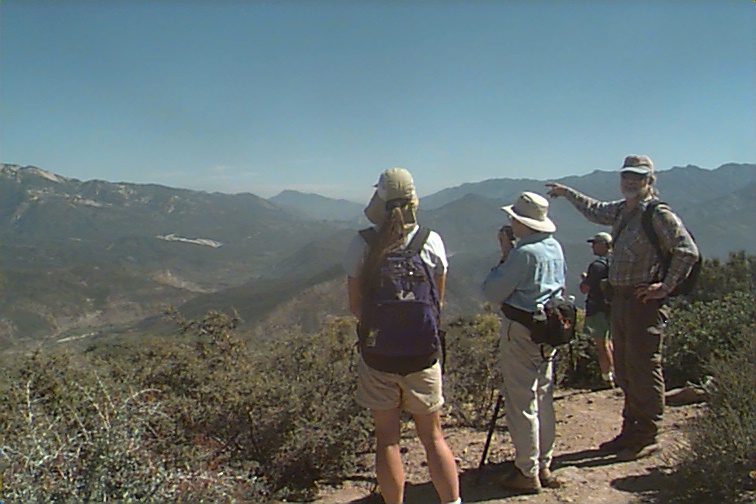
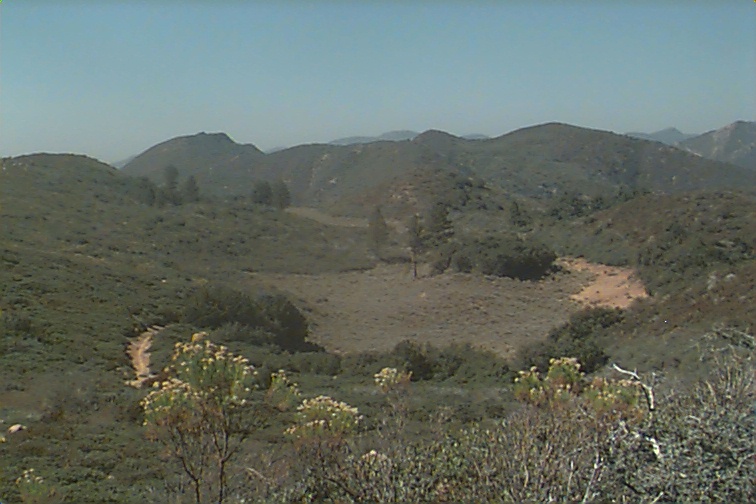
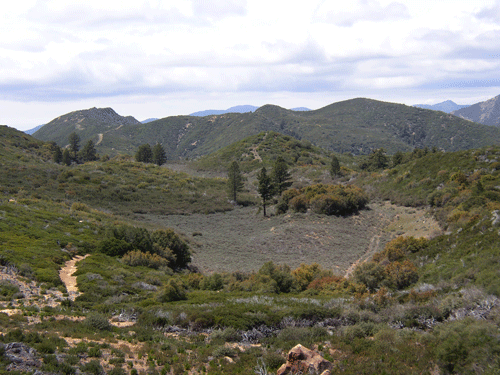

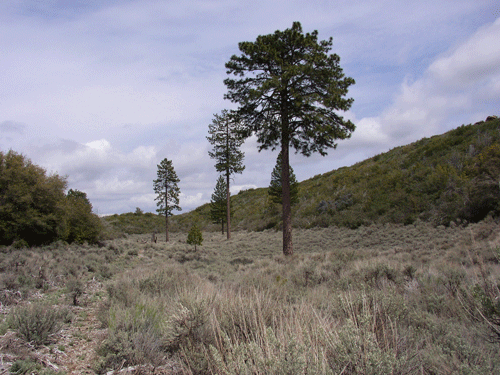
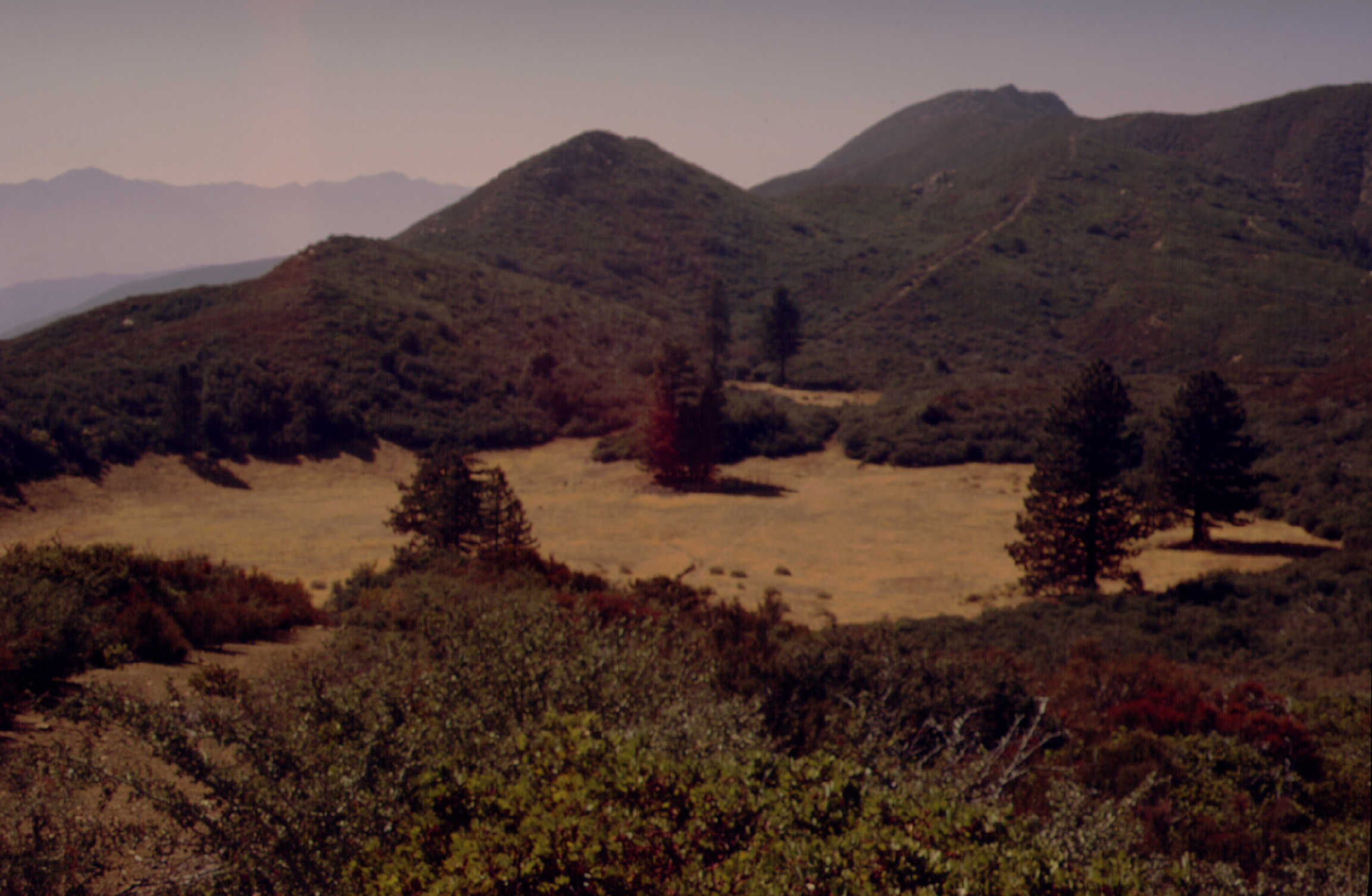
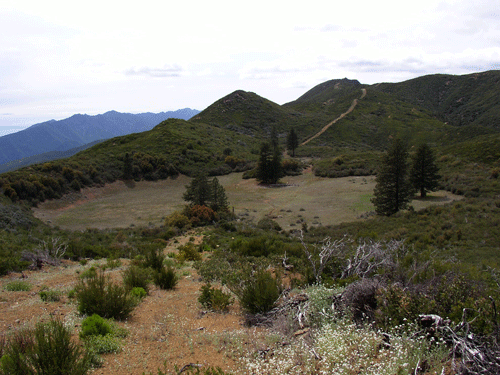
|
Sunday |
9 March 2014 9:00 AM to 11:00 AM
Walk |
Ventura County
Santa Clara River Native Plant Hike
|
Leader: David Torfeh. David lead an easy walk around The Nature Conservancy's Hanson Property on the Santa Clara River near Santa Paula. They explored the broad river floodplain riparian and riverine habitats. The recent rains brought out many plants. A number of plants were blooming, and there was a good assortment of late-winter birds.
|
Saturday |
8 February 2014 9:00 AM to 11:30 AM
Walk |
Ventura County
Foster Park Native Plant and Bird Walk
|
Leader: David Torfeh. David lead an easy to moderate walk around Foster Park, most of the time in the Ventura River bed. Sixty-six plant species were found and 20 different birds observed. Venue: Foster County Park, near Castias Springs (mouth of the Ojai Valley. Drive into the park ($4 parking fee) before crossing over the Ventura River.
|
Saturday |
25 January 2014 10:00 AM to about Noon
Walk |
Santa Barbara County
Botanic Tour of Carpinteria Salt Marsh Nature Park
|
Leader: Allen Braithwaite lead an easy walk around the Carpinteria Salt Marsh Nature Park. A number of plants were blooming.
|
Thursday |
16 January 2014 6:30 to 8:30 PM
Talk |
Santa Barbara County
Plant Communities of the Channel Islands
|
Speaker: Ken Owen. talked about the Plant Communities of the California Channel Islands. Ken Owen, Executive Director of Channel Islands Restoration (a nonprofit corporation dedicated to habitat restoration), spoke on the plant communities of 8 channel islands. He has been exploring them since he was a young boy and later started restoring these islands.
|
Sunday |
15 December 2013 9:00 AM to 1:00 PM
Walk |
Ventura County
Plants and Birds of Matilija Creek, Los Padres National Forest
|
Leader: David Torfeh lead an easy to moderate hike along Matilija Creek in Matilija Canyon in the Ojai District of the Los Padres National Forest to see the fall color of the cottonwood and willow trees, and birds of the canyon. A good number of members and the public had a great time in nature on a crisp December day to see the plants and birds of the Matilija Creek area at the west end of Matilija Canyon north of Ojai. A number of plants were blooming or in fruit. A checklist of all the plants known to occur in Matilija Canyon, developed by botanist David Magney, can be downloaded from the "Plant Checklists" webpage. Over 250 taxa of plants have been inventoried for the canyon.
|
Sunday |
17 November 2013 9:00 AM to 2:30 PM
Walk |
Ventura County
Fall Colors of Lion Canyon, Los Padres National Forest
|
Leader: Andrea Adams-Morden lead an easy to moderate hike up Lion Canyon out of Middle Lion Camp in the Ojai District of the Los Padres National Forest to see the fall color of the cottonwood and willow trees. A number of plants were blooming, and more were in fruit, on this informative hike along a nice mountain riparian forest, surrounded by chaparral communities. A checklist of all the plants known to occur along this trail, developed by botanist David Magney, can be downloaded from the "Plant Checklists" webpage.
|
Thursday |
21 November 2013 6:30 to 8:30 PM
Talk |
Santa Barbara County
About Dudleyas
|
Speaker: Tom Mulroy, PhD. CNPS members enjoyed Tom's talk: Interesting Things I Have Learned From Dudleyas. Dudleya is the genus for the small succulents from mostly California. There are a number of Dudleya species that are quite rare, and some that are common. The common name for the genus is Live-forever.
Saturday |
28 September 2013 9:00 to 11:30 AM
Walk |
Ventura County
Plants and Birds of Emma Wood State Beach
|
Leader: David Torfeh. Ten people joined CNPS and David in the exploration of the plants and birds of Emma Wood State Beach and the Ventura River mouth/estuary. 57 taxa of plants, some flowering, were seen on this informative tour of riparian forest, coastal salt marsh, and coastal scrub communities. When hike leader David Torfeh was not certain of some plants' identities, very knowledgeable participant Jay Sullivan (who may lead a spring 2014 fire-following plant hike at La Jolla Canyon) helped with identification. Chapter Treasurer, Stuart Bloom, read the hikers descriptions of each plant's characteristics and uses. We noticed sensitive salt marsh species Fleshy Jaumea (Jaumea carnosa), with attractive yellow flowers, Marsh Cinquefoil (Argentina egedii ssp. egedii), with serrate-edged leaves, and Pacific Pickleweed (Salicornia virginica) along the trail from the campgrounds to the Ventura River. Arroyo Willow (Salix lasiolepis) and highly invasive Cape Ivy (Delairea odorata) mostly populated the riparian forest portions of Emma Wood. Coastal scrub areas were dominated by Coyote Brush (Baccharis pilularis ssp. consanguinea). Some uncommon bird species were spotted along the way. A Sharp-shinned Hawk (a small, long-tailed raptor) flew over the forested area. Nearby, a White-tailed Kite (a small white and gray raptor that hovers to forage) was being repeatedly harassed by an American Crow in the air. Finally, along the beach, an Osprey (a large raptor that feeds on fish) coasted eastward as we looked on. Not uncommon was a boldly patterned slate blue Belted Kingfisher which caught everyone's attention at the estuary. Venue: Mother Nature's creation, Emma Wood State Beach, West Main Street, Ventura, CA 93001. Directions: From points South of Ventura: Take U.S. Highway 101 N to the California Street exit. From California Street, turn left onto Thompson Boulevard and take it to its end as it turns into Garden Street. Turn left onto W. Main Street, and head west under the freeway (SR33) and across the river bridge. Park along Main Street or go into Emma Wood State Beach (parking fee required - but for a worthy cause). From point North, take U.S. 101 S and take the Main Street exit, which will take you right to Emma Wood State Beach after you cross under the freeway (U.S. 101). From the Ojai Valley, take SR33 South to the Main Street exit and turn right at the Garden Street stopsign, and right again on W. Main Street.
|
Saturday |
25 May 2013 9:00 AM to ~2:00 PM
Nature Hike |
Ventura County
Nature Hike on Circle X Ranch, Santa Monica Mountains
|
Leader: Tony Valois. Tony, author of the online guide to the flora of the Santa Monica Mountains, lead a hike to look at the botanic beauty of Circle X Ranch. Circle X Ranch has trails through chaparral, coastal sage scrub, and riparian habitats, with high species richness and diversity. Tony is a vegetation ecologist with the Santa Monica Mountains National Recreation Area. The hike lead by Tony was a real treat! Tony led six participants on the scenic, partially shaded Grotto Trail through chaparral and riparian zones. We saw about 135 taxa of plants, of which 55 were flowering. Three Dudleya species, including the CNPS 1B listed Dudleya cymosa ssp. marescens, grow there. Madia gracilis, Polygala cornuta var. fishae, Allium haematochitom, and Clarkia unguiculata made pretty displays. We also saw two Side-blotched Lizards, a Western Whiptail [lizard], and a Variable Checkerspot [butterfly]. Surprisingly, this area just east of Yerba Buena Road in the western Santa Monica Mountains did not burn in the Springs Fire of April 2013. Furthermore, there was water flowing from springs into the rocky "grotto" riparian area, a rare occurence for this time of year in other parts of the Santa Monica Mountains.
|
Saturday & Sunday |
18-19 May 2013 9:00 AM to 3:00 PM
Rare Plant Hunt |
Santa Barbara County
Rare Plant Treasure Hunt for Ribes amarum var. hoffmannii
|
Leader: David Magney. David led a hunt to track down the rare Hoffmann's Gooseberry, Ribes amarum var. hoffmannii, a shrub that flowers in the late spring that is quite rare. It is endemic to westernmost Ventura County and Santa Barbara County. The taxonomy of Ribes amarum var. hoffmannii has been questioned, so we will examine as many plants as we can and gather data on each one. Phillip Munz formally described this variety in 1932 based on a collection from Gaviota Canyon by M.E. Jones. It was named in honor of Ralph Hoffmann, a botanist from Santa Barbara that collected extensively. The formal description, in Latin, is "Bacca manifesta pubescens, cum spinis non confertis, inaequalibus, 1-3.5 mm. longis", which basically means that the spines on the fruit are unequal in length, 1-3.5 millimeters long. This variety, as reported by Munz, ranges from Gaviota to Carpinteria. Clif Smith collected it from along Rincon Creek in Ventura County as well (which is close to Carpinteria). Historical occurrences include: Gaviota Canyon, Santa Barbara, Mountain Drive (Santa Barbara), and Carpinteria. We found a large population of a natural occurrence at the Santa Barbara Botanic Garden, then headed out to five other reported sites (Rattlesnake Canyon, Cold Spring Canyon, north edge of Carpinteria Salt Marsh, along Carpinteria Creek, Franklin Canyon Creek, Rincon Creek, and Casitas Creek. We found it at all but the salt marsh, Franklin Canyon, and Rincon Creek areas. We formally documented our findings, and turned in our reports to the CNPS Rare Plant Program and the California Department of Fish and Wildlife's Natural Diversity Database. It had been many years since anyone has reported on this variety, and there is a good likelihood that there are more, we just need to keep looking. It appears that it favors shaded sites, usually under Coast Live Oak and California Bay, so keep your eye out for it. 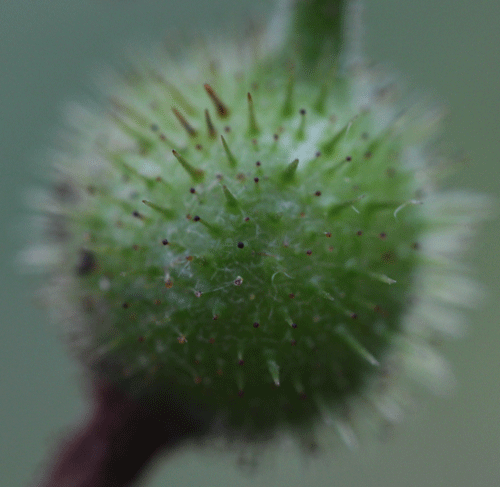
|
Thursday |
16 May 2013 6:30 to 9:00 PM
Talk |
Santa Barbara County
Management Considerations for Protecting and Enhancing Populations of Annual Species: The Southern Tarplant Case Study
|
Speaker: David Harris, with UCSB. David discussed details on of how to protect and manage a rare annual wildlflower. It was a fascinating discussion as all kinds o f interesting things we learned about California native plants when we try to grow them in the wild and "manage" them. The wildflower that was the focus of this talk is Centromadia parryi ssp. australis (Keck) B.G. Baldwin, the Southern Tarplant, an annual wildflower in the Sunflower family with yellow flowers and sharp, needle-like leaves. 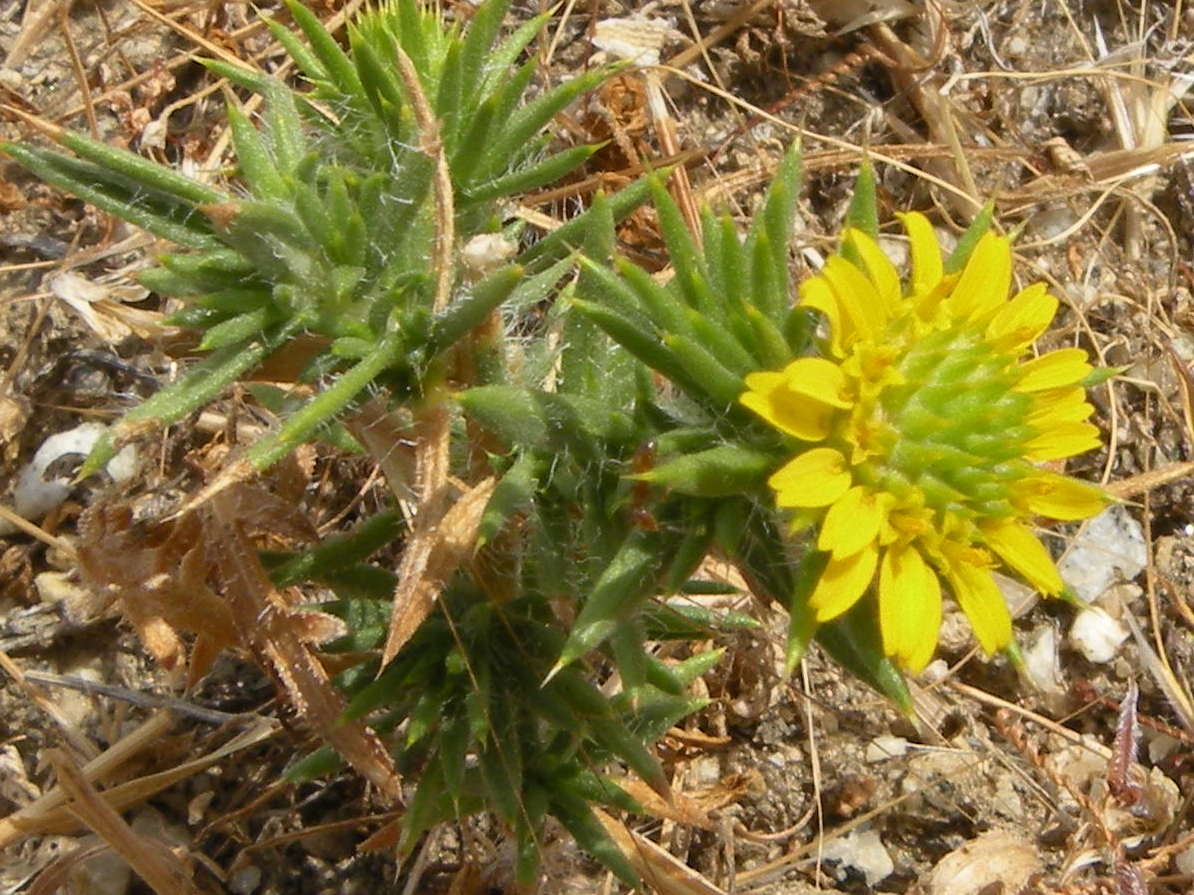
|
Saturday |
20 April 2013 10:00 AM to 3:00 PM
Plant Sale |
Thousand Oaks
SPRING PLANT SALE |
The Chapter held its regular Spring Plant Sale again in eastern Ventura County, at the Calleguas Municipal Water District headquarters between Thousand Oaks, Moorpark, and Simi Valley. The plants for the Spring Native Plant Sale was provided by Matilija Nursery and El Nativo Growers. There was a nice selection of local native plants to choose from. Calleguas Municipal Water District really helped out tremendously with both the venue and publicity. CNPS members received a 10 percent discount on all items for sale. See a flyer/brochure here. We had two presentations by landscape designers for some great ideas on using natives in your landscaping.
|
Saturday & Sunday |
6-7 April 2013 9:00 AM to 5:00 PM
Rare Plant Hunt |
Ventura and Santa Barbara Counties
Rare Plant Treasure Hunt for Fritillaria ojaiensis
|
Leader: David Magney. David tried to track down the elusive Ojai Fritillary, Fritillaria ojaiensis, a spring-flowering wildflower that is quite rare at two locations. It is endemic to Ventura, Santa Barbara, and possibly San Luis Obispo County. A long and hard hike up Kennedy Ridge to East Camino Cielo in the Santa Ynez Mountains of Ventura County on Saturday did not find the target. Suitable habitat was examined, but the historic population was likely another mile west up the mountain. However, several occurrences of the rare plants, Catalina Mariposa Lily (Calochortus catalinae) and one new occurrence of Plummer's Baccharis (Baccharis plummerae) were documents, along with the locally rare Globose Sedge (Carex globosa). On Sunday, a drive up Tequepis Canyon from State Route 154 and Lake Cachuma found suitable habitat and an overgrown Forest Service road, preventing a drive further up the canyon to the known population. Again, suitable habitat was observed, but no plants found. However, one small population of Plummer's Bacchris was found, along with a nice garden of flowering wildflowers, such as Fairly Lantern, Hummingbird Sage, and Fiesta Flower. 
Photo by David Magney We last revisited Ventura County occurrences of this bulb plant in 2010.
|
Saturday |
30 March 2013 9:00 AM to 12:30 PM
Nature Hike |
Ventura County
Native Plant Hike up Sulphur Mountain
|
Leader: David Torfeh. A good group of CNPS members and others joined David on a hike to see Spring wildflowers and be shown common native plants on this easy to moderate hike up Sulphur Mountain Road from near Rancho Arnaz in the Ojai Valley. They hiked up a wide, often shaded dirt road through Coast Live Oak Woodland, chaparral, Coastal Sage Scrub, and grassland habitats. There were views of San Antonio Creek, Oak View, Canada Larga, and Lake Casitas, not to mention all. . The hike had 16 participants and it was a very pleasant day with sun and moderate temperatures. . The group saw 67 plant taxa, and 36 were flowering, nearly 54 percent. . All the wildflowers Torfeh predicted to be in bloom were, except Calandrinia ciliata, Redmaids. . People were really pleased to learn what's out there. . Attendees were so interested they took copious notes on Magney's plant checklist that was provided and/or on notepads. . Early bloomers will include: California Buttercup, California Poppy, Fiesta Flower, several species of lupine, larkspur, Redmaids, amount many others. Rare plants along the hike include: Plummer's Baccharis, Fish's Milkwort, Catalina and Mariposa Lily. Please contact David Torfeh at 805/794-5334 for further information or if you have any questions. David Magney previously prepared a detailed list of all plants known to grow on Sulphur Mountain. A copy is available on this website (cnpsci.org) under "Checklists" or Magney's "Flora of Ventura County" website under "Checklists". 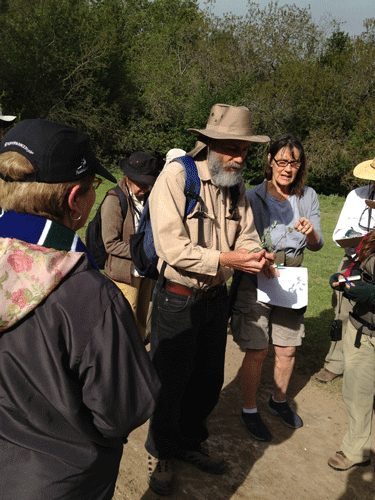
|
Thursday |
21 March 2013 6:30 to 9:00 PM
Talk |
Santa Barbara County
What's Blooming
|
Speaker: Lynn Watson. A nice group of CNPS members joined renowned photographer Lynn Watson at Santa Barbara Botanic Garden on an informative presentation on her on-line website that describes and shows What's Blooming, When, and Where along Figueroa Mountain Road. Figueroa Mountain is very interesting botanically and geologically, and the geology and geographic location of the mountain, located in the Los Padres National Forest in Santa Barbara County, provides wonderful botanical displays and interesting plants. See the Figueroa Mountains plants on Watson's Plant Blog/Website.
|
Saturday & Sunday |
23-24 March 2013 8:45 AM to 5:00 PM (2 PM on Sunday)
Vegetation Mapping Training |
Santa Barbara County
Rare Vegetation Sampling/Mapping Workshop at Carpinteria Salt Marsh
|
Leaders: CNPS Vegetation Program Staff Deborah Stout & David Magney. About 8 people, mostly CNPS members, signed up for this CNPS Chapter-based workshop to learn how to sample and map rare vegetation communities. We conducted a field-based sampling/mapping workshop at the Carpinteria Salt Marsh Reserve in southeastern Santa Barbara County. This workshop focused on techniques to identify and survey rare natural communities using our combined CNPS/Calif. Dept. of Fish and Wildlife protocols. The overall goals of the workshop was to learn about the diversity of salt marsh vegetation, learn to identify discrete stands of vegetation and estimate percent covers, and become familiar with the Rapid Assessment method for sampling vegetation. We also discussed low-tech options for contributing to vegetation mapping efforts. While the Reserve is diverse, each of our sample plots, 10 x 10 m, had low species richness. This was a function of purposefully choosing one plant association to fill the plot and the fact that low areas of a saltmarsh have only a few species that can survive in a saline/tidally flooded habitat. We sampled in Pickleweed/Saltgrass, Pickleweed-Glasswort/Jaumea-Saltgrass, and other vegetation alliances. For more information on the Reserve visit Reserve Website. Participants learned quickly and obtained a useful skill, how to conduct a releve survey as well as a Rapid Assessment. Visit the chapter's Facebook page to see some photos from the workshop.
|
Sunday |
24 Febranuary 2013 9:00 AM to 12:30 PM
Nature Hike |
Ventura County
Nature Hike to La Jolla Canyon and Mugu Peak
|
Leader: David Torfeh. David led a hike to see pre-Spring wildflowers and be shown common native plants on this moderate difficulty hike from the mouth of La Jolla Canyon to Mugu Peak in Point Mugu State Park, Santa Monica Mountains. The La Jolla Canyon to Mugu Peak botany hike on February 24, 2013 was enjoyed by all 10 people who attended, except for the strong winds at the Peak that made us limit our time spent at that upper elevation. Fortunately the Canyon (where we did most of our stopping and looking) was sheltered from the wind. Eighty-five taxa of plants were found, and about 30 taxa were flowering. Most conspicuous were Giant Coreopsis (Leptosyne gigantea) and two species of Ceanothus (spinosus with prolific light blue blossoms, and megacarpus with white blossoms) growing on the hillsides of the Canyon. Scattered populations of eye-catching Ground Pink (Linanthus dianthiflorus), California Poppies (Eschsholzia californica var. californica) and Southern Padre Shooting Star (Dodecatheon clevelandii ssp. sanctarum) were observed at the 900 to 1250 foot elevation range. At the top, we had a mostly clear 270 degree panoramic view of the Palos Verdes Peninsula and Catalina Island to the southeast, Santa Barbara Island and Mugu Naval Base to the south, Anacapa and Santa Cruz Islands to the southwest, the checkerboard of the Oxnard Plain to the west, the Santa Ynez Range to the northwest, and the prominent Topa Topas and Thousand Oaks to the north. Along the way, hike leader David Torfeh familiarized participants with the recent changes in botanical [scientific] names brought about by the second edition of the Jepson Manual, which was published in 2012, and hiker Jay Sullivan helped quite a bit. Some recurring examples were Bladder Pod (from Isomeris arborea to Peritoma arborea) and Deerweed (Lotus scoparius to Acmispon glaber). Most of us agreed that we are having a little difficulty getting used to these changes. Directions: From Ventura, take the 101 freeway to the Las Posas Road exit. Turn right and drive about 7 miles to State Route 1 (PCH). Get on PCH heading south toward Los Angeles and proceed 4.2 miles. La Jolla Canyon will be on the left. From Malibu, start at Kanan/Dume Road's intersection with PCH and head north toward Oxnard. Proceed 15 miles to La Jolla Canyon, which will be on the right. It is about 1.6 miles north of the more well-known Sycamore Canyon.
|
Saturday |
20 October 2012 9:00 AM to Noon
Nature Hike |
Santa Barbara County
Nature Hike up Hot Springs Trail
|
Leader: Wayne Ferren, Jr., an extremely knowledgable botanist, led a hike up Hot Springs Trail in Montecito, through private property that has been closed for years. It was an extraordinary walk. Directions to Trailhead: From points North, take U.S. Highway 101 S to the Hot Springs exit. Follow it to the juction with Olive Mill Road where it makes a hard left toward the mountains. Go to Mountain Drive. Turn left and go 0.2 mile to the trailhead on the right. From points south of Santa Barbara, take U.S. Highway 101 N to the Olive Mill Road exit. Turn right up Olive Mill Road and stay on this road until you get to Mountain Drive, then follow the directions for the North.
|
Tuesday |
16 October 2012 9:00 AM to Noon
Public Hearing |
Santa Barbara County
Public Hearing of CNPS Appeal of Planning Commission Decision
|
California Native Plant Society, Channel Islands Chapter and the San Antonio Creek Homeowners Association filed an appeal of the Santa Barbara County Planning Commission's decision to allow destruction of native grassland habitat at the Park Hill Estates site in the Goleta Valley. CNPS and the neighbors have been trying very hard over the last couple of years to get the County of Santa Barbara comply with the California Environmental Quality Act (CEQA) to be sure that all the environmental issues are properly addressed, and that project-related impacts are actually, first, identified, then avoided, and if not avoided, then feasibly mitigated (onsite first, offsite second). Chapter President was previously hired by the neighbors to critically review the Negative Declaration CEQA document the County prepared, and found it severly wanting. Now we have to convince the County Board of Supervisors that we are correctly, that an EIR is needed for this destructive project. The BOS "heard" our arguments but they fell on deaf ears, except for Supervisor Carbihol, the vote was 3:1 against our appeal. Please contact David Magney, president@cnpsci.org or call 805/646-6045 for further information. Go to CNPSCI Park Hill Estates Appeal webpage for details and links to downloadable documents on the project.
|
Sunday |
19 August 2012 9:00 AM to Noon
Native Plant Hike |
Santa Barbara County
San Ysidro Trail Hike, Santa Ynez Mountains
|
Leaders: Andrea Adams-Morden and David Torfeh. Andrea and David lead an enjoyable hike along the creek to a waterfall, mostly in the shade, with about 15 people attending. Interesting wetland plants to see will included Lobelia dunnii var. serrata (Ojai Lobelia) and Mimulus cardinalis (Scarlet Monkeyflower). Directions to trailhead: Take U.S. Highway 101 to the San Ysidro offramp in Montecito. Head northward (towards the mountains) on San Ysidro for 1.1 miles. Turn right on East Valley Road/State Route 192 and go 0.9 mile, and turn Left on Park Lane. On Park Lane drive 0.4 mile and bear left on East Mountain Drive. Bear left to the end of the block and park wherever there is space off the road and not blocking someone's driveway.
|
Thursday |
20 September 2012 6:30 PM to 9:00 PM
Native Plant Talk |
Santa Barbara County
Planting the Right Natives
|
Presenter: Greg Richardson, Plant Right Program. Mr. Richardson talked about their spring nursery survey of invasive plants. He discussed the importance of removing these plants from the market to prevent their intrusion into the native environment. Many of us like to include native plants in our gardens for a variety of reasons. However, some plant species available at our local nursery may not be suitable do to their invasive nature, particularily if they are not native to the area in which you live. These "invasive exotics" are troublesome because they have been escaping the garden landscapes and invading the natural enirons and outcompeting the native species. This can be a problem because many wildlife species are dependent on the native species and can't survive on the nonnatives, as just one example as to why we need to be very careful with planting nonnatives. Venue: Santa Barbara Botanic Garden, 1212 Mission Canyon Road, Santa Barbara, CA 93105. Directions: Take U.S. Highway 101 to the Mission Street exit. Head northward (towards the mountains) on Mission Street to Laguna Street. Turn left on Laguna, then turn right at the stop sign (just below the Santa Barbara Mission) onto E. Los Olivos Street. Take E. Los Olivos Street north for about a half mile to Foothill Road/State Route 192. Turn right onto Foothill Road, then turn left onto Mission Canyon Road. Stay right (on Mission Canyon Road) at the Y intersection and head up the hill to the botanic garden parking lot. The talk was in the garden library.
|
Sunday |
25 September 2011 9:00 AM - 2:00 PM
Native Plant Hike - Wildwood Mesa |
Thousand Oaks Ventura County
Hike to see native plants at Wildwood Mesa, Thousand Oaks, California.
|
David Torfeh and Debbie Prince led a hike at Wildwood Mesa (Wildwood Regional Park) for a small group of members (including Jay Sullivan who helped with plant ID) and nonmembers. They saw 96 species of plants, with roughly 35 actually in bloom, most of which were in the Sunflower family (Asteraceae). The rocky hillsides had Coastal Prickly Pear (Opuntia littoralis) to the north, flatter open areas with scattered brush, and a stream canyon (Arroyo Conejo) with lush riparian vegetation. There are 3 species of cactus on the mesa. Debbie gave tips on nature photography as well (see some of her work from the last hike she and David T. led). 
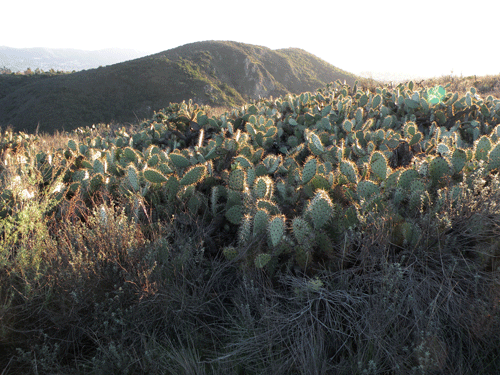 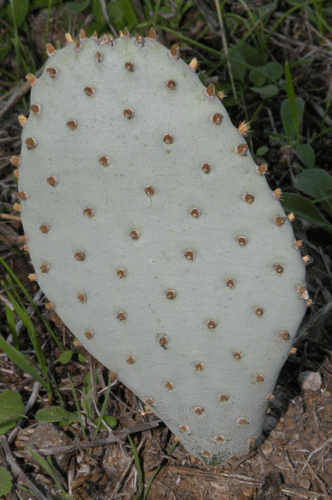
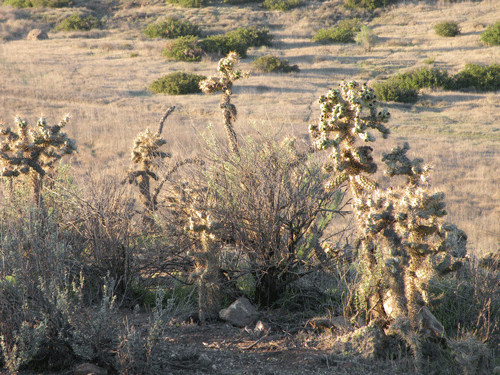 Photos by David Magney
|
Saturday |
24 September 2011 9:00 AM - 5:00 PM
Garden Tours - Theodore Payne Foundation and Descanso Gardens |
Sunland/La Canada Los Angeles County
Tour Native Plant Landsaping at the Theodore Payne Foundation and Descanso Gardens, eastern San Fernando Valley, California.
|
Spencer Westbrook will led an expedition to tour two famous gardens focused on native plants: Theodore Payne Foundation gardens in Sunland, and the Descanso Gardens in La Canada. The Theadore Payne Foundation gardens are dedicated solely to California native plants, of course, focusing on those plants from southern California that are well-suited for home landscaping. We were given a guided tour of the Foundation gardens and had time to wander around the gardens, nursery, and visitor's center before heading over to the Descanso Gardens for lunch and tour there. The guided tour of Descanso Gardens lasted for an hour and a half. There was an entrance fee for Descanso Gardens. There was a good turnout, about 20, mostly members of the Ventura Master Gardeners.
|
Mon-Wed |
11-13 July 2011 4:30-6:00 PM
Movie Screening |
Ojai Playhouse
Queen of the Sun, Ojai, California.
|
CNPS sponsored the documentary film "Queen of the Sun", focusing on the importance of bees, including native bees. QUEEN OF THE SUN: What are the Bees Telling Us? is a profound, alternative look at the global bee crisis from Taggart Siegel, acclaimed director of the grass-roots hit THE REAL DIRT ON FARMER JOHN. Taking us on a journey through the catastrophic disappearance of bees and the mysterious world of the beehive, this engaging and ultimately uplifting film weaves an unusual and dramatic story of the heartfelt struggles of beekeepers, scientists and philosophers from around the world including Michael Pollan, Gunther Hauk, and Vandana Shiva. Together they reveal both the problems and the solutions in renewing a culture in balance with nature. The film was full of fascinating and troubling facts, viewpoints, and considerations. It should be available through Netflix in the near future if you missed it. It has been reviewed as: The new Critic's Choice documentary the New York Times calls "Revelatory!" “Queen of the Sun: What are the bees telling us?” QUEEN OF THE SUN: What are the Bees Telling Us? is a profound, alternative look at the global bee crisis from Taggart Siegel, acclaimed director of the grass-roots hit THE REAL DIRT ON FARMER JOHN. FOR MORE INFORMATION WWW.QUEENOFTHESUN.COM "Revelatory...honey has never looked so delicious. Or so precious." New York Times- Critics Choice "A remarkable documentary that's also one of the most beautiful nature films I've seen." -Roger Ebert “The feel-good advocacy movie of the year.” -Box Office Magazine "A hymn to nature's under-appreciated pollinators." - NPR.org
|
Sunday |
26 June 2011 9:00 AM - 2:00 PM
Native Plant Hike |
Ventura County
Hike to see native plants at Los Robles Open Space, Thousand Oaks, California.
|
David Torfeh and Debbie Prince lead a hike at Los Robles Open Space. A nice group of about 15 showed up and a good time was had by all, and a number of native plants were in full bloom. If you missed this one, watch for the next opportunity and have some fun. 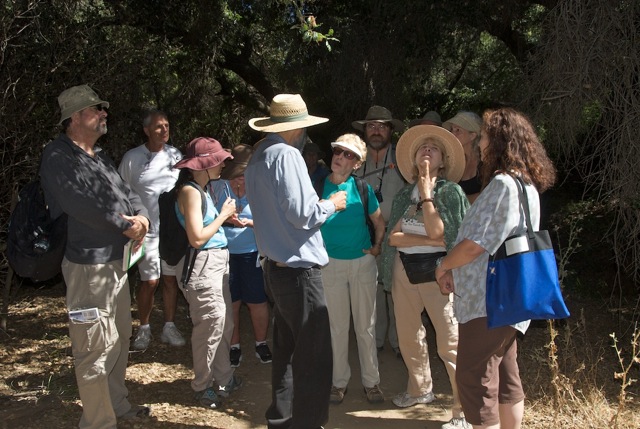
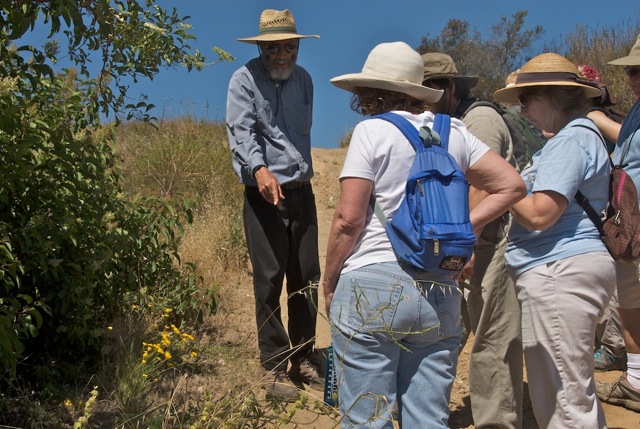
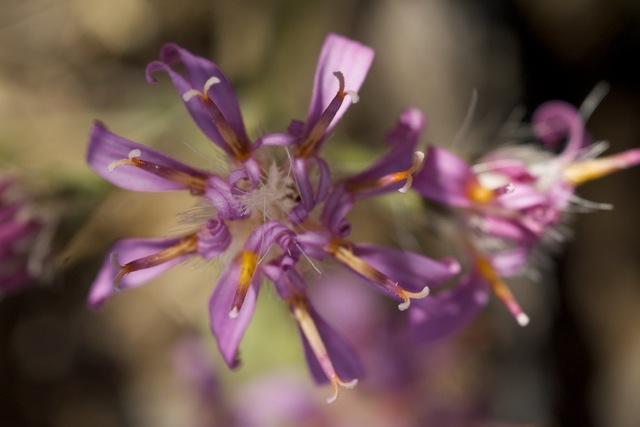

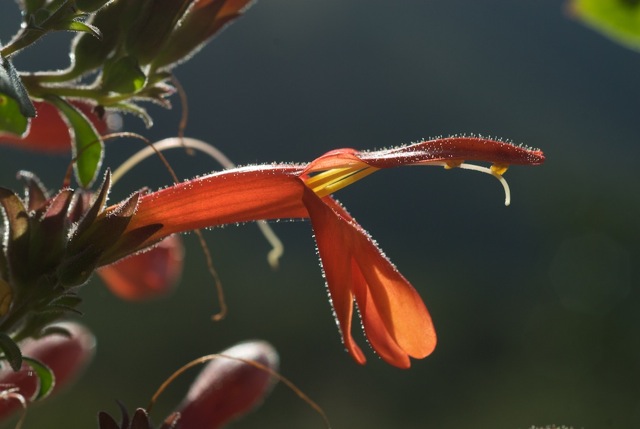


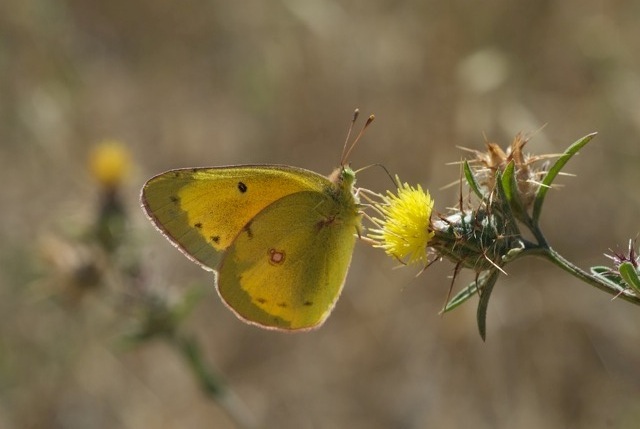
Photography by Debbie Prince of Imageprince.com Directions: From Ventura, take the US101 Freeway to Moorpark Road in Thousand Oaks. Turn right (toward the Santa Monica Mountains). Continue to Greenmeadow Avenue and turn right. Go all the way to the end of the paved road and meet in the parking lot near the restrooms. There are at least three trails here. We will select at least one trail. Carpoolers can meet at the Park & Ride parking lot on the southeast corner of the 101 Freeway and Las Posas Road in Camarillo at 8:30 a.m. (for those coming from points North, that is).
|
Tuesday & Wednesday |
3-4 May 2011 8:30 AM - 4:45 PM
Wetland Plant ID Class |
Casitas Springs Community Center Casitas Springs, California
Riparian and Wetland Plant Identification Class
|
The CNPS Education Program put on a second class/workshop focusing on identification and ecology of riparian wetland plants, focusing on species in the Southwest Region of California. The course was taught by local botanist David L. Magney, assisted by Cher Batchelor and David M. Brown, focusing on plants native to Santa Barbara, Ventura, and western Los Angeles Counties. The class was full, mostly with local County staff and environmental consultants, with one fellow coming all the way from Illinois. Emphasis was placed on the common trees and shrubs that form the riparian canopy. 
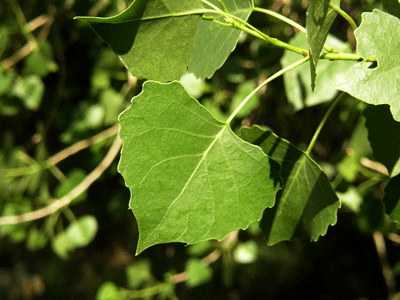 Cost: $295 for CNPS members, $320 for General Public/non-members. Registration open until first day; however, it is filling, so register now. Print out the Riparian/Wetland Plant ID Class flyer.
|
Saturday |
26 March 2010 9:00 AM - Noon, 1:00 - 4:00 PM
Rare Plant Search/Treasure Hunt |
Ventura County
Search/Hike for Fritillaria ojaiensis and other Rare Plants
|
David Magney and David Brown lead another expedition to document/monitor known populations of the endangered lily, Fritillaria ojaiensis (Ojai Fritillary), and hunted for new ones. It is known to occur in Santa Paula Canyon, upper Sisar Canyon, Horn Canyon, Senior Canyon, Gridley Canyon, Stewart Canyon, Wheeler Gorge, the Rincon Creek watershed and on the Ocean View Trail on the top of the Santa Ynez Mountains on the Ventura-Santa Barbara County line, a couple of canyons in the Santa Barbara County portion of the Santa Ynez Mountains, Los Osos Canyon (on Little Pine Mountain), and possibly in San Luis Obispo Canyon. As part of the chapter's new Biodiversity Hotspot program and CNPS' Rare Plant Treasure Hunt program, this expedition was the first this year to research, document, monitor, and report on the unique plants of this region. Hiking was easy to moderate. The search/survey was split into morning and afternnoon sessions with the morning spent hiking up the Gridley Canyon Trail to the first of 2 populations. The afternoon session found us monitoring one of the Wheeler Gorge populations along SR33. We searched on the west side of Wheeler Gorge Campground; however, we didn't find any more there. This year we found hundreds of the broad basal/seed leaves (one per plant) and many in full bloom as well. 
Photo by David Magney In 2010 we visited and monitored four populations in upper Sisar Canyon, two of which are on Boyd and Karin Dron's property below Topatopa Bluffs. Each population had over 200 plants, and each seems very healthy and robust. Many other plants were in bloom as well, and the weather was perfect. We expect that things will be just as good this year, but will visit different populations. 25-Mar-2011: the plants in Wheeler Gorge are in full bloom!
|
Saturday |
16 April 2011 9:00 AM - 5:00 PM
Garden Tour |
Santa Barbara and Ventura Counties
Native Plant Home Garden Tour
|
The Channel Islands Chapter, in coordination with the Santa Barbara Botanic Garden, put on its first tour of home gardens landscaped exclusively, or mostly, with California native plants. The self-guided tour allowed access to see beautiful native plant gardens from Goleta , Santa Barbara, Montecito, Carpinteria, Ventura , Thousand Oaks , and more. Experiencing these beautiful native gardens first hand was a great opportunity to gain inspiration and learn about these amazing plants for all who participated. Andrea Adams-Morden coordinated the tour in coordination with the Santa Barbara Botanic Garden, who handled the registration. Thank you Heather Wehnau at the Garden, and Andrea, for more making the tour a great success. Cost: $15 for CNPS members, $25 for non-members.
|
Sunday |
17 April 2011 1:00 - 4:00 PM
Plant Walk |
Santa Barbara County
Rattlesnake Canyon Native Plant Walk
|
The Santa Barbara Botanic Garden and Channel Islands Chapter sponsoring a walk up Rattlesnake Canyon in Santa Barbara. Andrea Adams-Morden lead the walk in coordination with the Santa Barbara Botanic Garden.
|
Wednesday |
20 April 2011 7:30-9:00 PM
Program |
E.P. Foster Library Ventura
Chasing California's Wild Flowers
|
To help celebrate Native Plant Week, we had Spencer Westbrook, an expert photographer, show the best photographs of the best wildflowers of southern California. He took us on a spectacular journey through our native wildflowers through his spectacular photography, and shared with us many of his techniques. A nice crowd of members and nonmembers had a nice evening with Spencer. 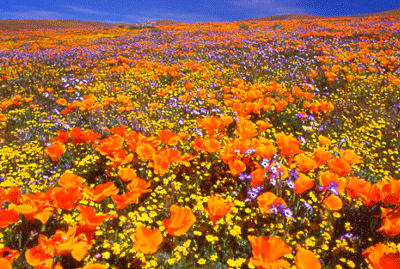
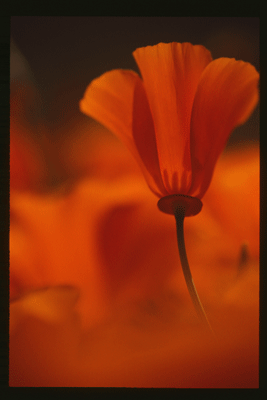
Photos by Spencer Westbrook
|
Saturday |
23 April 2011 10:00 AM - Noonish
Botanic Tour |
Santa Barbara County
Carpinteria Salt Marsh Nature Park Tour
|
Allen Braithewaite gave a botanic tour of the Salt Marsh Nature Park at Carpinteria Salt Marsh.
|
Saturday |
23 April 2011 10:00 AM to 3:00 PM
Plant Sale |
Thousand Oaks
SPRING PLANT SALE |
The Chapter held its Spring Plant Sale for the first time in eastern Ventura County, at the Calleguas Municipal Water District headquarters between Thousand Oaks, Moorpark, and Simi Valley. We had a great turnout and sold most of the plants, and helped get natives planted in the yards of East County residents. The plants for the Spring Native Plant Sale were provided by Matilija Nursery. There was a nice selection of local native plants to choose from. Calleguas Municipal Water District really helped out tremendously with both the venue and publicity. Thank you very much.
|
Saturday |
19 March 2011 9:00-11:30 AM
Botany Hike |
Point Mugu State Park Ventura County
Beginner's Botany/Wildflower Hike/Nature Walk, La Jolla Canyon, Point Mugu State Park, Santa Monica Mountains
|
David Torfeh lead a spring-time beginner's hike along the lower portion of La Jolla Valley at Point Mugu State Park. La Jolla Canyon, below La Jolla Valley is about 3 miles long, stretching between the Pacific Coast Highway (State Route 1) to a nice waterfall, where the trail passes through a narrow canyon of Conejo Volcanics outcrops dominated by chaparral vegetation. La Jolla Valley opens up a short distance beyond, which is dominated by Purple Needlegrass (Stipa pulchra) grasslands. This hike is easy. A list of the plants known to grow in La Jolla Valley/Mugu Peak is available on the Plant Checklists page on this website, prepared by botanist David Magney. So far, 174 different plant species have been identified as growing in the Park. See if you can find a plant species that hasn't been reported from there before. 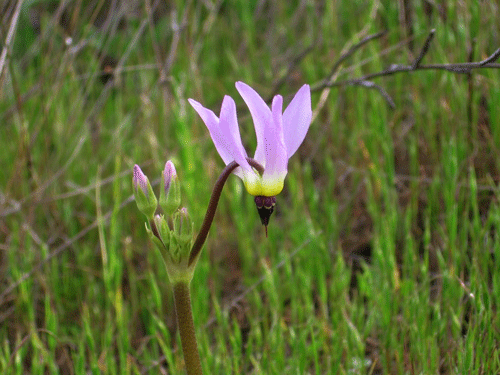
Photo by David Magney An intimate group of 7 joined David on this easy hike up the lower part of La Jolla Canyon, just in time too since now PCH is closed due the heavy rains, causing landslides, at Point Mugu. In bloom was the Giant Coreopsis, Ceanothus, Fuchsia-flowered Gooseberry, Chaparral Currant, and many others. Directions: From points north of Point Mugu, go south on PCH (Las Posas Road south to PCH since the Rice Road offramps are closed at US101) past Mugu Rock and turn left into La Jolla Valley in the Park and park in the parking lot at the end of the road. The beach campground of Thornhill Broome is on the ocean side and a bit south of the entrance to La Jolla Canyon/Valley.
|
Thursday |
17 March 2011 8:30-10:30 AM
Botany Hike |
Ojai Ventura County
Local Botany/Wildflower Hike/Nature Walk, Shelf Road, Ojai Valley
|
Pat Jump and Nancy Eldblom lead a spring-time hike along the nearly level Shelf Road/Valley View Trail in Ojai, for the first time this spring. Shelf Road is about 3 miles long, stretching between Signal Street and Gridley Road, with great views of the Ojai Valley. The road is cut into the south base of Nordhoff Ridge, through Ceanothus Chaparral and California Coastal Sage. This hike is easy. A list of the plants known to grow along Shelf Road is available on the Plant Checklists page on this website, or, the same list organized by flower color is available by clicking here. So far, 141 different plant species have been identified as growing along Shelf Road. See if you can find a plant species that hasn't been reported from there before. Those on the walk in January saw California Peony in full bloom, amoung others, and the lupines where just starting to bloom in mid-February. The white-flowered Ceanothus should be if full bloom, and the blue-flowered Ceanothus should be as well. 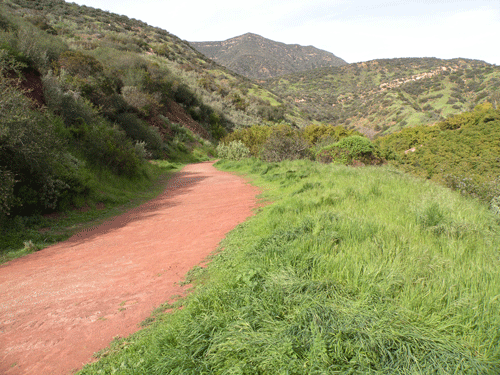
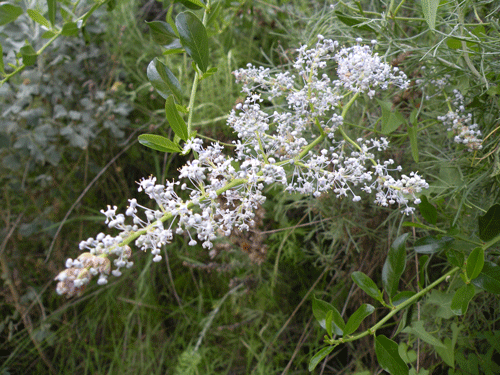
Photos by David Magney A nice group of 6 joined Nancy and Pat. Found still in bloom was a California Peony, which has gone to fruit in most places in the Ojai Valley. As expected, the Ceanothus was in full bloom. Directions: Go north onto Signal Street in downtown Ojai (Ojai Avenue/State Route 150) at the Post Office. Drive all the way to the very end (up a steep hill) and park. You will make a little jog on Signal Street when it intersects with Grand Avenue, but just keep going up hill. The trailhead is at the end (top) of N. Signal St.
|
Saturday |
12 February 2011 8:00 AM - 4:00 PM
Landscape Symposium |
Camarillo Ranch Barn Camarillo, California
Native Plant Landscape Symposium
|
The Channel Islands Chapter held its second annual workshop on the use of native plants in the landscape. We had new great speakers that provided guidance and ideas about plant selection, care, and maintenance all focusing on plants native to Santa Barbara, Ventura, and western Los Angeles Counties. Lili Singer, Horticulturist, garden consultant and freelance garden writer for the Los Angeles Times, Special Projects Coordinator for the Theodore Payne Foundation for Wildflowers and Native Plants, and one of the best known speakers on gardening with natives, talked about a wide variety of written resources available on the use of native plants in the landscape. John Greenlee, Horticulturalist, author, and garden designer specializing in meadows and grass ecologies, talked about the sins of the traditional lawn and gave lots of examples of alternatives to the traditional lawn that all require far less irrigation, all using native species. Pamela Berstler, an award-winning sustainable exterior designer and landscape water management expert, has collaborated closely with Surfrider Foundation, developing homeowner classes for its Ocean Friendly Gardens Program. Berstler brought to us innovative techniques for water conservation, permeability, and retention to integrate with native landscapes. Bob Perry, Professor Emeritus Cal Poly Pomona, Landscape Architect, and author, talked about the Alchemy of native plants; source of life and sustainability. David Magney, Botanist and Certified Arborist, talked about using trees that are native to southern California, discussing 12 of the 77 native trees found in this part of the state. Over 100 people attended the symposium and seemed to enjoy it very much. Thank you all that attended, and we hope to you, including those that didn't make it, at our next symposium, most likely in February 2012. Contact Janet Takara at jntakara@yahoo.com or 909/815-2519 for more information. Lunch delectably designed by Chef Carrie Clough, from 90% locally-grown organic produce, was enjoyed by all. Late Registration (after 2/5) Cost $50 for CNPS members and $65 for General Public/non-members.
|
Thursday |
20 January 2011 9:00-11:00 AM
Botany Hike |
Ojai Ventura County
Local Botany/Wildflower Hike/Nature Walk, Shelf Road, Ojai Valley
|
Pat Jump lead a hike along the nearly level Shelf Road/Valley View Trail in Ojai, for the first time this winter, and about 8 people joined her. Shelf Road is about 3 miles long, stretching between Signal Street and Gridley Road, with great views of the Ojai Valley. The road is cut into the south base of Nordhoff Ridge, through Ceanothus Chaparral and California Coastal Sage. This hike is easy. A list of the plants known to grow along Shelf Road is available on the Plant Checklists page on this website, or, the same list organized by flower color is available by clicking here. So far, 141 different plant species have been identified as growing along Shelf Road. See if you can find a plant species that hasn't been reported from there before. Those on the walk saw California Peony in full bloom, amoung others. Directions: Go north onto Signal Street in downtown Ojai (Ojai Avenue/State Route 150) at the Post Office. Drive all the way to the very end (up a steep hill) and park. You will make a little jog on Signal Street when it intersects with Grand Avenue, but just keep going up hill. The trailhead is at the end (top) of N. Signal St.
|
Wednesday |
19 January 2011 7:30-9:00 PM
Program |
E.P. Foster Library Ventura
Earthquakes and Plants
|
Dieter Wilken, Ph.D., of the Santa Barbara Botanic Garden, will explain the relationships and patterns of plants and earthquakes. Earthquakes and the distribution of some plants are related to each other by the occurrence of geological faults. However, the science of seismology, especially in California, has also benefitted from work conducted by geologists using plants, in very different ways, to confirm the history, location, and points of propagation of earthquakes. Have plants assisted seismologists in determining where and when the next great California earthquake? Attend and decide for yourself. Who would have thought that the two are related, but they are. Location: Topping Room of the E.P. Foster Library in downtown Ventura. Address: 651 East Main Street, Ventura, between Fir and Chestnut Streets. The Topping Room is on the left side of the library building (when looking at the building from Main Street), with its own entrance.
|
Saturday |
18 December 2010 9:00 AM-3:00 PM
Botany Hike |
Montecito Santa Barbara County
Local Botany/Wildflower Hike/Nature Walk, Romero Canyon, Santa Ynez Mountains
|
Leader: Frank Sovich. Enjoy a six-mile loop through chaparral and riparian communities. It is most easterly of the trails of the Santa Ynez Mountains, behind Montecito. Enjoy the fresh and clear are of the late fall, maybe so fall color on the deciduous trees and shrubs, and possible late-flowering Asteraceae plants. Plants that have been reported from Romero Canyon include: Ageratina adenophora, Apiastrum angustifolium, Brickellia nevinii, Cardamine californica, Geranium carolinianum, and Senecio mikanioides (a nasty invasive exotic). You will also see Quercus agrifolia, Platanus racemosa, Umbellularia californica, and one or more species of Salix, not to mention many species of chaparral shrubs. A good description of the trail is found at the VC Trails website, where you can also download a GPS track for the trail. Directions: Go north or south on U.S. 101 to Montecito. Take the Sheffield Drive off-ramp. Turn right onto Sheffield then follow it sharply left for 1.5 miles East Valley Road. Turn left, go 50 yards/meters then turn right on Romero Canyon Road. In a half mile, veer right and continue another mile to Bella Vista Road. Continue right a quarter mile until you see a steel gate on the left side of the road. Park in a safe manner along Bella Vista. Meet at the gate. Contact Frank at 684-8822 if you have any questions.
|
Saturday |
13 November 2010 9:00 AM - 4:00 PM
Nature Plant Sale |
Nopalito Nursery Ventura, California
Native Plant Sale
|
Nopalito Nursery will host a benefit plant sale for the Channel Islands Chapter, assisted by knowledgeable members of the chapter. A majority of the proceeds from all plant sales during the day will go to the Channel Islands Chapter. Nopalito Nursery specialized in California natives, and cutivars of them, and has a wide selection of locally grown natives. Instead of having Nopalito Nursery truck their plants to our usual plant sale site at Plaza Park, we are going to their retail location next to Lassen's on E. Main Street. Contact Lynne Kada at lynnekada@gmail.com for more information. Click Here for a great looking flyer about the plant sale and talk. Location: Meet at Nopalito Nursery at 4701 E. Main Street in Ventura. Directions: From Santa Barbara, get off US101 at the Main Street exit (Exit 65) and turn Right, then Right at the driveway to Lassen's and Nopalito's, and drive to the back, to the nursery. From Oxnard get off US101 at Telephone Road. Turn Left onto Telephone and then Right onto E. Main Street, then Right into the driveway just past the fire station.
|
Saturday |
13 November 2010 10:00 - 11:00 AM
Program |
Calvary Christian Fellowship Church Ventura, California
Creating a Sustainable Garden with Native Plants - $10 entrance fee
|
For just $10, you will be able to hear Professional garden designer Lisa Burton's 12-Step Program for a Sustainable Garden that she incorporates in all the garden designs she creates for her clients. Her program includes considerations for being climate-appropriate, ocean-friendly, and supportive of our local wildlife including birds, butterflies, beneficial insects, and bees. She will talk about the important role native plants play in accomplishing her goals and will share with us some of her favorite natives she utilizes in the gardens she creates. As a professional garden designer for the last 10 years, Lisa Burton is the owner of Nature by Design. In that capacity, she is committed to creating gardens that contribute to a healthy environment and being responsible stewards of the earth. This year Lisa was recognized by the Ventura County Board of Supervisors for her commitment to "Think Global, Act Local" during their Climate Change Action Awards ceremony. She is also a former Master Gardener. For more information visit her website at www.nbdgardens.com. Location: Calvary Christian Fellowship Church, 4221 East Main Street, next to Nopalito Nursery, in Ventura.
|
Saturday |
24 April 2010 7:00 AM - 5:00 PM
Island Excursion |
Santa Cruz Island Santa Barbara County
Sail over to and Hike around Santa Cruz Island |
Steve Junak led an expedition to explore the botany of Santa Cruz Island, the largest of the eight Channel Islands. Steve is THE expert on the flora of Santa Cruz Island, he wrote the flora for the island. The boat put in at Prisoner's Harbor and Steve led the hike to Pelican Bay. There were opportunities to see many marine mammals, in particular dolphins and whales, while sailing to/from the island. Hiking was easy to moderate. 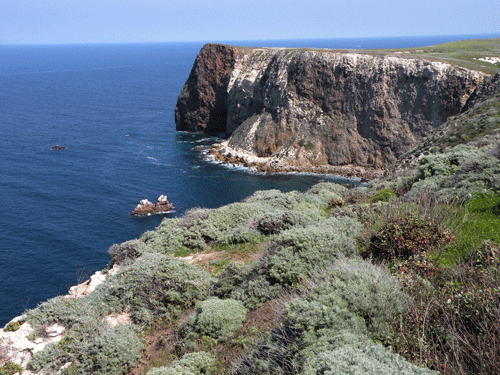
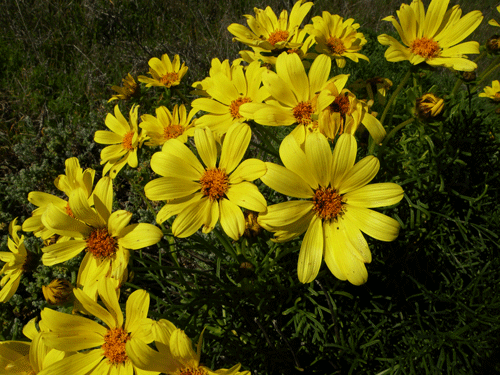
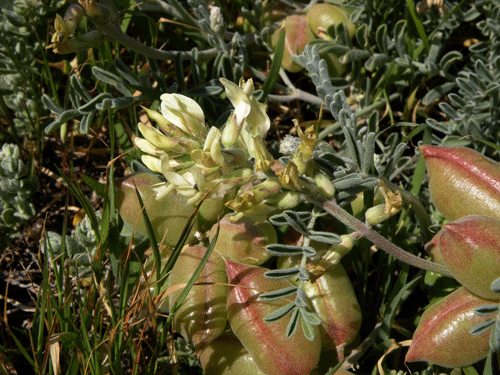
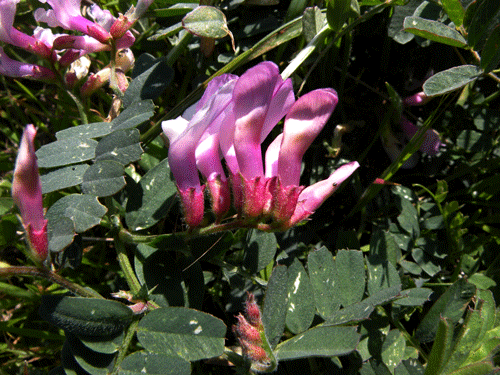
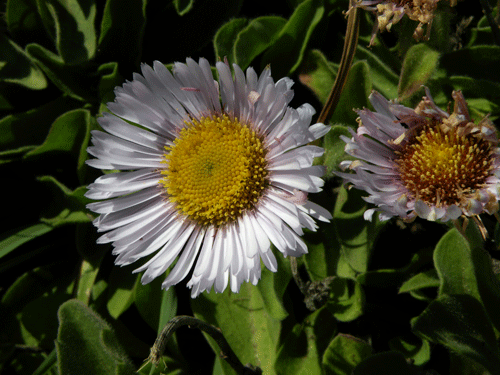
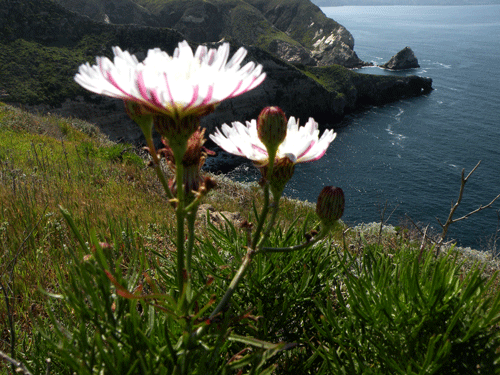
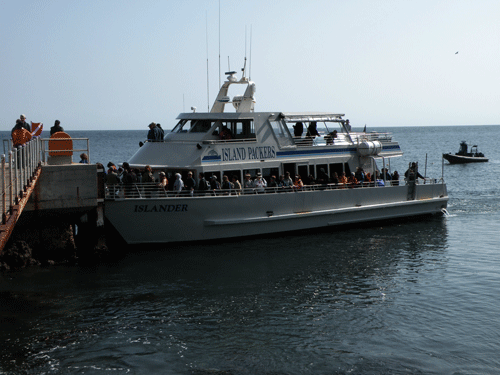
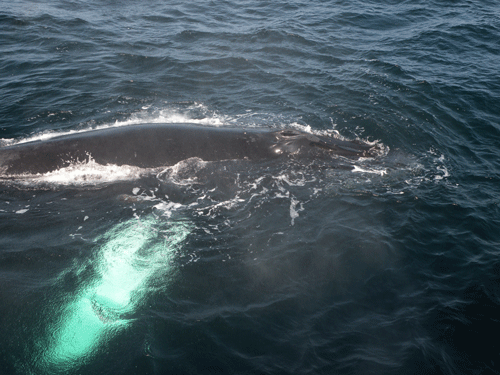
|
Saturday |
17 April 2010 9:00 AM - 3 PM
Earthday Event/Wildflower Walk |
Figueroa Mountain Santa Barbara County
CNPS and Los Padres National Forest Earthday Event and Wildflower Walk
|
CNPS members led a walk through the wildflower fields of Figueroa Mountain, which contains serpentinite rock. This means that there are lots of unique plants, and few invasive exotics to see, and the spring wildflowers of this unique plant community/mountain should be great. This was the 7th annual wildflower weekend event on Figueroa Mountain. This was a "drive and stroll" tour of this year’s spectacular display. Directions: Meet at 9 AM at the Fire Station on Figueroa Mountain Road. Turn left at the SR 154-Figueroa Mountain Road intersection near Los Olivos, and proceed to the Fire Station parking lot at 9 AM. Call Helen Tarbet at 925-9538 ext. 246 or Charles Blair 733-3189 for details.
|
Thursday |
8 April 2010 8:30-11:00 AM
Botany Hike |
Ojai Ventura County
Local Botany/Wildflower Hike/Nature Walk, Shelf Road, Ojai Valley
|
Nancy Eldblom led hikes along the nearly level Shelf Road in Ojai, for the fourth time this spring. Shelf Road is about 3 miles long, stretching between Signal Street and Gridley Road, with great views of the Ojai Valley. The road is cut into the south base of Nordhoff Ridge, through Ceanothus Chaparral and California Coastal Sage. This hike is easy. A list of the plants known to grow along Shelf Road is available on the Plant Checklists page on this website, or, the same list organized by flower color is available by clicking here. So far, 141 different plant species have been identified as growing along Shelf Road. See if you can find a plant species that hasn't been reported from there before. Directions: Go north onto Signal Street in downtown Ojai (Ojai Avenue/State Route 150) at the Post Office. Drive all the way to the very end and park. You will make a little jog on Signal Street when it intersects with Grand Avenue, but just keep going up hill. Meet at the top end of N. Signal Street.
|
Saturday |
20 March, 3 & 10 April 2010 9:00 AM - 5:00 PM
Rare Plant Search |
Ventura County
Search/Hike for Fritillaria ojaiensis and other Rare Plants
|
David Magney and David Brown led a expeditions to document/monitor four known populations of the endangered lily, Fritillaria ojaiensis (Ojai Fritillary). It has been reported as occurring in Santa Paula Canyon, upper Sisar Canyon, Horn Canyon, Senior Canyon, Gridley Canyon, Stewart Canyon, Wheeler Gorge, the Rincon Creek watershed and on the Ocean View Trail on the top of the Santa Ynez Mountains on the Ventura-Santa Barbara County line, a couple of canyons in the Santa Barbara County portion of the Santa Ynez Mountains, Los Osos Canyon (on Little Pine Mountain), and possibly in San Luis Obispo Canyon. As part of the chapter's new Biodiversity Hotspot program, this expedition was the first of many events to research, document, monitor, and report on the unique plants of this region. Hiking will be easy to strenous (due to elevation gains), and we are working on obtaining vehicle access as far in as we can, to reduce the time spent just hiking up the mountain. Call 805/646-6045 or email the chapter president (David Magney) at president(at)cnpsci(dot)org or conservation chair (David Brown) at conservation(at)cnpsci.org for more information. We had four CNPS members join us (Stuart Bloom, Andrea Adams-Morden, Jay Sullivan, and David Torfeh). The Ojai Fritillary was blooming at each of the four populations we examined in upper Sisar Canyon, two of which are on Boyd and Karin Dron's property below Topatopa Bluffs. Each population had over 200 plants, and each seems very healthy and robust. Many other plants were in bloom as well, and the weather was perfect.
|
Saturday |
13 March 2010 8:00 AM - 5:00 PM
Botany Hike |
Pt. Sal Santa Barbara County
Beach Botany & Geology Hike at Pt. Sal
|
Leaders: Elihu Givertz and William Abbott led a hike to Pt Sal -- one of the most rugged and picturesque stretches of coastline in Santa Barbara County. A nice group of half a dozen enthusists trekked to one of the least visited State Parks in California, exploring the geologically unusual corner of Santa Barbara County, and caught glimpses of many rare plants known from the site, possibly even a new population of Castilleja. A review of the rare plants we saw:
Also, the Phacelia growing in the dunes had to be the common P. ramosissima, but how differently is grows there! Due to the closure of the access parking lot at the top of Pt. Sal Road, pedestrian access now begins at the bottom of Brown Road, making for a long hike with variable topography; roundtrip to the beach and back is 12 miles. Anticipate being gone all day, and bring water and lunch. An exhaustive plant list will be provided. Bring water and lunch, and warm clothing, in layers. Level: strenuous, due to distance only. Check out access issues here in case of last-minute closure.
|
Thursday |
February, early March, and 1 April 2010 9:30-11:30 AM
Botany Hike |
Ojai Ventura County
Local Botany/Wildflower Hike/Nature Walk, Shelf Road, Ojai Valley
|
Nancy Eldblom led hikes along the nearly level Shelf Road in Ojai. Shelf Road is about 3 miles long, stretching between Signal Street and Gridley Road, with great views of the Ojai Valley. The road is cut into the south base of Nordhoff Ridge, through Ceanothus Chaparral and California Coastal Sage. This hike is easy. A list of the plants known to grow along Shelf Road is available on the Plant Checklists page on this website, or, the same list organized by flower color is available by clicking here. Directions: Go north onto Signal Street in downtown Ojai (Ojai Avenue/State Route 150) at the Post Office. Drive all the way to the very end and park. You will make a little jog on Signal Street when it intersects with Grand Avenue, but just keep going up hill. Meet at the top end of N. Signal Street.
|
Sunday |
7 March 2010 9:00 AM - Noon
Botany Walk |
Carpinteria Bluffs Santa Barbara County
Beach Botany Walk
|
Leaders: William Abbott and Andrea Adams-Morden led a beach walk at low tide, from the Carpinteria Bluffs to Rincon Creek and back. Those attending learned the names of native halophytic (salt-loving) plants and others that love to cling to the beach bluffs. A plant list was provided.
|
Saturday |
20 February 2010 8:00 AM - 5:00 PM
Landscape Symposium |
Camarillo Ranch House Camarillo
Native Plant Landscape Symposium: Sustainability Through Nature
|
Generously Sponsored by:
Topics discussed included: plant choices for the home landscape, watering, wildland interface, designing for wildlife, landscape design for fire resistance, landscape maintenance, integrating natives with ornamental nonnative plants, cultural uses, landscaping under oak trees, lawn replacements, and permaculture. As you can see, there was something for everyone. Owen Dell spoke on "Sustainable Landscaping: A Visionary Look at the Future of Gardens". Owen is a licensed landscape contractor and landscape architect specializing in sustainable landscapes, firescaping, and native landscaping. Owen's book was availabe for purchase and signing. Richard Halsey spoke on living in the urban/wildlands interface and how to live safely next to and within fire prone natural vegetation. Greg Rubin spoke on "Landscaping Secrets for the Native Garden", bringing practical experience and understading to basic design principles for creating yearround interest, minimizing maintenance, fire resistance, irrigation, and success. Carol Bornstein, one of southern California's most respected native plant horticulture specialists, spoke on the appropriate plants to use in your garden, with landscape design in mind. We had Carol's book (California Native Plants for the Garden) for sale. Michael Inaba, ISA Certified Arborist, spoke on the care of mature trees, in particular native oak trees, and planting/landscaping around and under them. He provided a better understanding of sun/shade requirements, plant growth, and soils. Barbara Eisenstein, blogger, writer, and speaker on gardening with natives talked about "Creating a Wild Suburbia with California Native Plants". She works with gardeners, landscape professionals, and horticulturalists to advance the use of native plants and sustainable gardening practices in homes and parks. Bart O'Brien, editor and horticulturalist, talked about the care and maintenance of native plants in your garden, and he shared a variety of species, and his favorite cultivars, for use in a landscape situation. We had Bart's book (Care and Maintenance of Southern California Native Plant Gardens) for sale, which he gladly autographed. Lunch and snacks were catered by Carrie Clough, of Manzanita Chef, as well as coffee, tea, and good tasting water (imported from the private reserve in northern Sierra Nevada by David Magney). The Western Chapter of the International Society of Arboriculture approved two (2) CEUs for Arborist certification and Treeworker certification for those attending this symposium (Course Code: WE-10-099). Venue: Camarillo Ranch House Barn (newly restored and now hi-tech), 201 Camarillo Ranch Road, Camarillo, CA. 93012. Contact/More Information: chapter horticulture chair, Patt McDaniel, at 805/646-9948. We had over 200 people from all over attending. NEXT YEAR for those who missed this one.
|
Wednesday |
2 December 2009 7:00 PM - Plant ID 7:30 PM - Talk
Presentation |
E.P. Foster Library, Topping Room Ventura
Exploring Our California Biodiversity Hotspot
|
Speaker: David Brown, Biologist Did you know that you live in one of the richest areas of biological diversity on Earth? California is considered to be a Biodiversity Hotspot, one of the Top 25 richest areas of biological diversity on Earth; however, much of this biological diversity is potentially imperiled if we do not make an effort to appreciate, understand, and take appropriate actions to conserve it. The CNPS Channel Islands Chapter is undertaking an initiative to inform the public about the globally significant hotspot of biodiversity that we all live in right here in the Ventura/Santa Barbara County Area, develop opportunities for people to directly contribute to the conservation of this hotspot, and provide local planning authorities and decision makers with data necessary to conserve overlooked but biologically important elements of the California Biodiversity Hotspot. David Brown described the proposed initiative and the opportunities for exploration, celebration, and conservation of our local part of the California Biodiversity Hotspot that it will hopefully provide. David Brown, a California native and biologist with David Magney Environmental Consulting, has been examining and exploring our own local biodiversity, which is in the center of the California Biodiversity Hotspot. He is spearheading a local effort to gather, explore, and teach others about the amazing biodiversity right here in the Ventura/Santa Barbara County area, focusing on native plants and wildlife. David is setting up a program to provide learning and exloring opportunities to the public and children that will result in valuable scientific data that can be used by conservation biologists to help protect our own local biodiversity. He described the program and identify some of the many exploration and learning opportinites that will make a difference. David is also actively working to conserve giraffe species in Africa, and studying their genetics.
|
Saturday |
30 May 2009 9:00 AM - 1:00 PM
Pratt/Foothill Trails |
Ojai
Post-hike Review: Hike/Hunt for Ojai Navarretia, Pratt and Foothill Trails, Ojai Valley, Ventura County.
|
Leader: David Magney, Botanist David led an easy hike to see a population of the newly described species, Navarretia ojaiensis, which was only formally described in 2007. David rediscovered some populations of this small annual in the Phlox family first found by Henry M. Pollard (1886-1973) in 1948 (though called Navarretia jaredii then. Of course, we saw many, many other common and beautiful wildflowers along the way. At the end of the day, we fanned out and found three additional subpopulations along the Foothill Trail west of Stewart Canyon, on the Cozy Dell drainage side of the ridge. This species is basically restricted to Ventura County, an endemic species, with only about eleven populations remaining in the world. David identified plants and wildlife observed along the way, and discussed the ecology of the plant communities occurring on Nordhoff Ridge along the Foothill Trail. A checklist of plants documented as present along the Pratt Trail and Stewart Canyon by botanist David Magney is available on his Ventura County Flora, Pratt Trail webpages. Contact David Magney at 805/646-6045 for more information.
|
Wednesday |
18 March 2009 7:30 PM - Talk
Evening Program |
E.P. Foster Library, Topping Room Ventura
Post-talk Review: Using Native Plants in Your Garden
|
Speaker: Bob Sussman, Nurseryman & Owner of Matilija Nursery Matilija Bob will told about 40 attendees all about the best places to plant natives in your garden, including his favorite, native Iris. He has many years of experience cultivating plants native to Ventura County and southern California, and has been the supplier of plants for the chapter's plant sales for many years. He is very knowledgable and those of you attending benefited from his experience.
|
Saturday |
21 March 2009, Saturday 9:00 AM - 1:00 PM
Hide, Howard Trail |
Nordhoff Ridge/Rose Valley
Post-hike Review: Hike, Howard Creek Trail, Los Padres National Forest, Rose Valley, Ventura County.
|
Leader: Lloyd Simpson, Forest Botanist The Los Padres National Forest botanist led a hike up the Howard Creek Trail along an old Forest Service road (lower part) to the tope of Nordhoff Ridge. Lloyd said the views from the trail would be outstanding; however, the weather didn't cooperate and the ridgetop was shrouded in clouds, and the Hoary Ceanothus (Ceanothus oliganthus var. oliganthus), Snowball Ceanothus (Ceanothus crassifolius), Eastwood Manzanita (Arctostaphylos glandulosa), and Chaparral Currant (Ribes malvaceum) were blooming, but not too much else. Exciting to see was the only occurrence in Ventura County of Sword Fern (Polystichum munitum). Lloyd pointed out the many native shrubs and wildflowers seen along the trail. Those that made it all the way to the top were rewarded with special commemorative lapel pins from the Forest Service. A list of all the plants observed by David Magney is posted on the "Plant Checklists" page found on this website. Thank you Lloyd for a nice interpretive hike.
|
Wednesday |
21 January 2009 7:00 PM - Plant ID 7:30 PM - Talk
Evening Program |
E.P. Foster Library, Topping Room Ventura
Wildflower Trails of the Los Padres National Forest
|
Speaker: Llyod Simpson, Forest Botanist Lloyd told us all about the best places to see wildflowers on local Forest Service trails. We heard about the well-known and little-known trails in the Los Padres National Forest that offer great opportunities to see a wide variety of native wildflowers.
|
Saturday-Monday |
17-19 January 2009 8 AM to 6 PM
CNPS Conservation Conference |
Sacramento, CA
CNPS Conservation Conference 2009: Strategies and Solutions
|
If you didn't go, you missed CNPS' second statewide conservation conference held in January at the Sacramento Convention Center. The last Conservation Conference was way back in 1986. There were many interesting, invigorating, and informative presenations and posters, all about the California flora and how to conserve it. This was a great way to see and learn what is happening in CNPS, conservation botany, and meet lots of professional and amateur botanists from all over California and other states too. Visit the CNPS State website for details. This conference was very exciting.
|
Wednesday |
23 January 2008
Evening Program |
E.P. Foster Library, Topping Room Ventura
Landscape and Flora of Chile
|
Speaker: David Magney Finally, we will actually get an opportunity to see the landscape and flora of central Chile, based on Mr. Magney's visit to the Santiago and Patagonia areas of Chile in December 2004. Magney explored a preserve east of Santiago and the Lake District of southern central Chile, visiting parks and glaciated canyons lush with exotic plants. Take a whirlwind tour of this interesting part of South America with Mr. Magney. You can get a preview by visiting Mr. Magney's Chile website Review: The pictures were beautiful, of lush rainforests, waterfalls, subalpine scrub of the Andes, and even a smoggy city. You missed it, too bad.
|
Saturday |
17 November 2007 9:30 AM - 3:00 PM
Botany Hike |
Fall Color Hike, Lion Canyon, Ventura County Backcountry
|
Leader: David Magney, Botanist Review: Chapter president and botanist David Magney led a leiserly hike up Lion Canyon starting at Middle Lion Campground to see the Fremont and Black Cottonwoods and willows in fall color. The trailhead is at Middle Lion Camp in the Los Padres National Forest, Ventura County. David met 5 members at 9:30 AM at the Los Padres National Forest Wheeler Gorge Visitor Center, on State Route 33 north of Ojai and carpooled, in two Honda Civic Hybrids, both light blue in color. This was an easy to moderate hike up a beautiful canyon with a perennial stream and mature Fremont and Black Cottonwoods and White Alder trees growing in Lion Creek. The canyon walls contain mixed chaparral and Bigcone Spruce, and are quite picturesque. We had lunch under the White Alder trees next to a nice, clear-water pool with fall-color leaves floating on the water, and Carex senta growing along the edge of the creek. Heather brought fresh brownies for desert, and were they ever delicious. Richard saw a young Bobcat, and we flushed a covey of California Quail as we passed through a grove of Bigcone Spruce (Pseudotsuga macrocarpa). Over the years, I have now documented a total of 232 vascular plant taxa in Lion Canyon, almost all native species. Visit the Plant Checklists page on this website for the most current checklist of plants in Lion Canyon, which is titled "Lion Creek-Spruce Falls". On our way driving back to the Visitor's Center, we had to stop to investigate the colony of shrubs with bright red leaves in a small drainage to the northwest of Middle Lion Campground. And it was a good thing too, it was a population of Brown Dogwood (Cornus glabrata), representing a new population for the Ventura County flora (I did notice the red bushes last year but didn't have time to investigate). Well, guess what was growing on both sides of Piedra Blanca-Rose Valley Road west of Rose Valley? More Brown Dogwood. Lion Canyon Fall Color photo Brown Dogwood bushes photo Brown Dogwood leaf photo Directions: From the south (Ventura and points south), take US 101 North to SR 33 North, past Ojai to Wheeler Gorge. From the north (such as from Santa Barbara and points north, take US 101 South through Carpinteria, taking US 101 to Ventura and SR33 or SR 150 over Casitas Pass to SR33 south of Ojai, then stay on SR 33 North to Wheeler Gorge. From Wheeler Gorge, take SR33 North to the Rose Valley/Piedra Blanca Recreation Area turnoff, and drive to the end to Middle Lion Campground and the Lion Canyon Trailhead.
|
Saturday |
14 July 2007
Hike trough Ventura River Preserve, Ojai Valley |
Botany Hike through Ojai Land Conservancy's Ventura River-El Nido Preserve, Ojai Valley, Ventura County.
|
Leaders: Ken Niessen and William Abbott, botanists and active Channel Islands Chapter members Ken and William lead a hike through riparian and wetland habitats, and Coast Live Oak Woodland on the Ojai Valley Land Conservancy's Ventura River-Rancho El Nido Preserve, which was purchase a few years ago. The preserve is located within and west of the Ventura River, near Meiners Oaks, within the Ojai Valley. This preserve has a wide range of natural habitats and many native plants, and a few invasive species too. Ken and William identified plants and wildlife observed along the way, and discussed the ecology of the plant communities occurring on the preserve. A checklist of plants documented as present at the preserve by botanist David Magney is available on the Plant Checklists webpage. Look for Rancho Matilija-Wills Canyon. Hike level: Easy hiking with minor elevation gains (gentle ups and downs). Directions: Meet at the Preserve Riverview trailhead parking area along Rice Road between El Roblar and Lomita Avenue, Meiners Oaks, CA 93023. From the south, take U.S. 101 to State Route 33 (Ojai Freeway), take SR 33 to Baldwin Road/SR 150 towards Carpinteria, then turn Right on Rice Road (northward). After the third stop sign at Lomita, and going up a small hill, turn Left into the parking area.
|
Saturday |
23 June 2007
Horn Canyon Hike, Ojai Valley |
Botany Hike Up Horn Canyon, Ojai Valley/Nordhoff Ridge, Ventura County.
|
Leaders: Cher Batchelor and William Abbott, botanists with David Magney Environmental Consulting (and Channel Islands Chapter Secretary and Newsletter Editor, respectively) Cher and William will lead a hike through Coastal Sage Scrub, Ceanothus Chaparral, riparian and wetland habitats, and Coast Live Oak Woodland, up Horn Canyon. Horn Canyon is located behind Thacher School, at the northeast end of the Ojai Valley and south slope of Nordhoff Ridge. The canyon is rich with wildflowers and flowers shrubs, all along a perennial stream with cool fresh water. Cher and William will identify plants and wildlife observed along the way, and discus the ecology of the plant communities occurring on the canyon. Hike level: Easy hiking with minor elevation gains (gentle ups and downs). Directions: Meet at the Horn Canyon Trailhead behind Thacher School, east of Ojai. From the south, take U.S. 101 to State Route 33 (Ojai Freeway), take SR 33 to SR 150 through downtown Ojai and continue east to Reeves Road and turn left at Boccalli's (do not go up Denison Grade to the right). Take Reeves Road to McAndrew and turn Left. Take McAndrew to its end at Thacher School and stay to the Right, through a parking lot to a dirt road, cross a little creek, and park at the trailhead (there is a sign). If you find yourself at the horse pastures, you have gone too far. Post-hike Review: A nice group of members joined Cher and William for the botany hike along the Morgan Barnes Trail in Horn Canyon. Hiking was relatively easy but it was quite hot. A few new plants were found for Horn Canyon, including: Delphinium cardinale, Monardella hypoleuca ssp. hypoleuca, M. lanceolata (which has such a strong and refreshing mint fragrance), Brickellia nevinii, Allophyllum gilioides ssp. violaceum. Some of these are rare in Ventura County, but none are "unexpected" for the canyon. Regardless, finding them in a new location is exciting!
|
Wednesday |
20 June 2007
Evening Program |
E.P. Foster Library, Topping Room Ventura
Los Padres National Forest Flora
|
Speaker: Lloyd Simpson, Botanist, Los Padres National Forest Lloyd told us about interesting things are happing in the Los Padres National Forest, the largest one in California. Post-talk Review: A nice group showed up to listen to botanist Lloyd Simpson talk about the goings on, botanically, on the Los Padres National Forest. Lloyd gave a "formal" presentation and program focusing on the native trees of the Los Padres, some very rare, like the Abies bracteata (Santa Lucia Fir), and some very common, like the Quercus agrifolia (Coast Live Oak). He also showed photographs of the Day Fire burn, and some of the plants that sprouted after the fire, even though there was basically no rain this last winter and spring. Thank you, Lloyd, for your interesting talk.
|
Saturday |
19 May 2007
Botany Expedition |
Ladybug Creek Canyon, Upper Sespe Creek, Ventura County
|
Leader: David L. Magney, Botanist Intermediate to difficult level hike, with cross-country travel up and down some steep slopes. This is a challenging hike/botanizing expedition into areas of Ventura County that have never been botanized before (at least I have seen no collections from this canyon at any California herbarium). We will be searching for and cataloguing all the plants we find. Ladybug Creek Canyon is a small northward-oriented canyon draining the north slope of Ortega Hill, and a tributary to Sespe Creek. We will meet at the Los Padres National Forest Wheeler Gorge Visitor's Center along State Route 33 across from the Wheeler Gorge Campground entrance. We will then drive out to the Chorro Grande Canyon trailhead along SR33 and hike cross-country to the mouth of Ladybug Creek Canyon to the south. Wear sturdy walking shoes or boots, a hat, and layered clothing that you don't mind getting dirty from some bushwacking, and bring lunch and water. Remember to bring your camera and your Jepson Manual. Click here for a map of Ladybug Creek Canyon. Click here for an aerial photo of Ladybug Creek Canyon. Post-hike Review: Stephen Hoskinson and Richard Sweet joined me in this little botany expedition. Hiking was relatively easy but some scrambling and climbing over boulders was required in some places. The temperature was perfect, and fresh, clean water was flowing in the lower half of the canyon, going underground at the mouth. The perennial portions of the stream supported Alnus rhombifolia-Acer macrophyllum (White Alder-Bigleaf Maple) Riparian Forest, and several small Rainbow Trout were seen in some of the deeper pools. Pseudotsuga macrocarpa (Bigcone Spruce) and Quercus chrysolepis (Canyon Live Oak) Forest occur on the steep slopes and along much of canyon walls, with Ceanothus leucodermis (Whitethorn Ceanothus), Cercocarpus betuloides (Birchleaf Mountain Mahogany), and Rhamnus tomentella (Hoary Coffeeberry) are the chaparral dominants covering the slopes of the canyon. Of particular interest were the following botanical prizes we found: Aralia californica (California Spikenard), Cardamine pachystigma (Toothwort), Osmorhiza chilensis (Mountain Sweetroot), Clarkia rhomboidea (Rhomboid Clarkia), Prunus virginiana var. demissa (Western Choke Cherry), and Ceanothus palmeri. About half way up the canyon, there is a very large boulder, which split into two pieces hundreds of years ago, that sits on top of a perennial spring. This rock I have dubbed Saxum Fissum. I took a short video of the twin waterfalls through and around Saxum Fissum.
|
Sunday |
6 May 2007
Burton Mesa Ecological Reserve 1/2-day hike |
Natural History Hike Through Burton Mesa Ecological Reserve, Western Santa Barbara County.
|
Leader: Elihu Gevirtz, Condor Environmental Planning Services, Inc. Elihu will lead a hike through Burton Mesa Chaparral, and visiting some local wetlands and other plant communities along the way. Burton Mesa is a special place just north of Lompoc, in western Santa Barbara County. Elihu will identify plants and wildlife observed along the way. Hike level: Relatively easy to moderately difficult hiking with minimal elevation gains. Post-hike Review: Our hike on Burton Mesa was fun on a beautiful sunny day with encounters of Burton Mesa endemics: Purisima Manzanita and Shagbark Manzanita (Arctostaphylos purissima and A. rudis), Santa Barbara Ceanothus and Lompoc Ceanothus (Ceanothus impressus and C. cuneatus var. fascicularis), as well as Santa Cruz Island Shrub Oak (Quercus parvula ssp. parvula). We were also delighted to come upon a California Horned Lizard (Phrynosoma coronatum) and a barking Coyote (Canis latrans). The hike took us through one of the stands of Burton Mesa Chaparral that hasn't burned in more than 70 years with tall shrubs towering over our heads, multi-trunked oak trees, a grassy meadow containing a small wetland, a fern grotto (Pteridium aquilinum var. pubescens), and a freshwater marsh with Red-winged Blackbirds singing. Our thanks to Elihu for his time and knowledge.
|
Saturday |
21 April 2007
Old Creek Ranch, Ojai Valley |
Botany Hike of Old Creek Ranch, west slope of Sulphur Mountain, Ojai Valley, Ventura County.
|
Leaders: Cher Batchelor and William Abbott, botanists with David Magney Environmental Consulting (and Channel Islands Chapter Secretary and Newsletter Editor, respectively) Cher and William will lead a hike through grasslands, coastal sage scrub, riparian and wetland habitats, and Coast Live Oak Woodland on the Old Creek Ranch property. The ranch is located on the east side of San Antonio Creek and the northwest edge of Sulphur Mountain, with in the Ojai Valley. This ranch has never really been botanized before, except for along the creek for activities occuring within the creek. Cher and William will identify plants and wildlife observed along the way, and discus the ecology of the plant communities occurring on the ranch. The ranch is the site of the Old Creek Ranch Winery, which will be open for wine tasting (after) the hike. Hike level: Easy hiking with minor elevation gains (gentle ups and downs). Bring comfortable but sturdy shoes, layers of clothing, water, snacks, and lunch if you like. Post-hike Review: The weather was perfect. A nice group had a good time with Cher and William, seeing what plants were in bloom (not very many) and what birds were out. The ranch is at the west end of Sulphur Mountain, with grassland and Coast Live Oak Forest, and riparian vegetation in San Antonio Creek. David Magney found a new record for Ventura County, the diminuative plant in the Rose family, Aphanes occidentalis (Dew Cup or Western Lady's Mantle), growing with the Ranunculus californicus (California Buttercup) under the Quercus agrifolia (Coast Live Oak) trees. In the creek, we saw a Green-backed Heron and a Southwestern Pond Turtle sunning itself on a boulder in the middle of the creek. Thanks to Cher and William for a very nice outing.
|
| ||||||||||||||||||||||||||||||||||||||||||||||||||||||||||||||||||||||||||||||||||||||||||||||||||||||||||||||||||||||||||||||||||||||||||||||||||||||||||||||||||||||||||||||||||||||||||||||||||||||||||||||||||||||||||||||||||||
CHANNEL ISLANDS CHAPTER, CALIFORNIA NATIVE PLANT SOCIETY, P.O. Box 6, Ojai, CA 93024-0006
Special thanks to Carlin Moyer for the beautiful illustrations on our site.